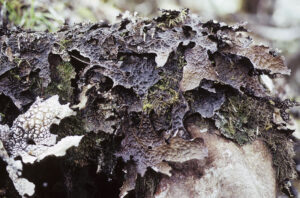Kaj Halberg - writer & photographer
Travels ‐ Landscapes ‐ Wildlife ‐ People
Plants in folklore and poetry

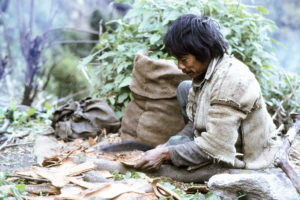
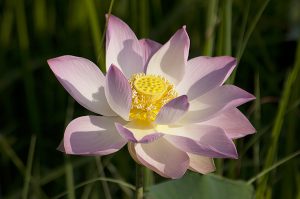
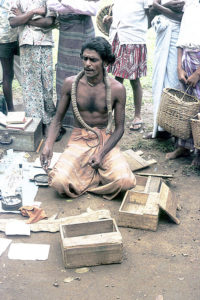

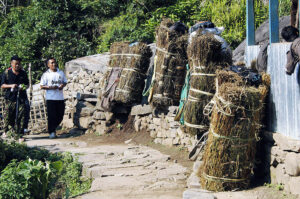
Sage was a healing herb, supposed to impart wisdom and immortality, rosemary is for remembrance, and was believed to identify one’s true love, whereas thyme was believed to impart courage.
It has been proposed that ‘rosemary and thyme’ is a misheard lyric for ‘grows merry in time’.
In case you find errors on this page, I would be grateful to hear about them. You can use this email address: respectnature108@gmail.com.
Common elder is native to Europe and North Africa, eastwards to the Caucasus, and has also become naturalized in North America. The generic name is from the Greek sambuca, the name of an ancient instrument of Asian origin. The pith was removed from elder branches to make flutes. The name elder is from Anglo-Saxon, aeld, meaning ’fire’ – the hollow stems were used to kindle a fire. The popular names pipe tree and bore tree stem from the habit of removing the soft pit of elder branches to make pipes. The same procedure would make pop-guns, popular among small boys. English herbalist Nicholas Culpeper (1616-1654) writes: ”It is needless to write any description of this [the elder], since every boy that plays with a pop-gun will not mistake another tree for the elder.”
A common medieval belief was that Judas hanged himself on an elder after betraying Jesus. In his Vision of Piers Plowman, medieval poet William Langland (c. 1332-1386) says:
Another belief was that the cross, on which Jesus was crucified, was made of elder. An old rhyme runs thus:
In Denmark and other countries, the elder was connected with magic. In it lived Hyldemor (’elder-tree mother’), who watched over it. If somebody cut down the tree, they would be haunted by her. In The Book of Herbs, Lady Rosalind Northcote (1873-1950) writes: ”There is a tradition that once when a child was put in a cradle of elder-wood, Hylde-Moer came and pulled it by the legs and would give it no peace, till it was lifted out. Permission to cut elder wood must always be asked first, and not until Hylde-Moer has given consent by keeping silence, may the chopping begin.”
A widespread popular belief was that the elder would ward off evil and protect from witches, and green elder branches were buried in graves to protect the dead from evil spirits. In Denmark, it was believed that if you were standing under an elder on Midsummer Eve, you would see the King of Elves ride by, attended by his retinue.
Elder is highly esteemed for its medicinal properties. English herbalist John Evelyn (1620-1706) writes in praise of it: “If the medicinal properties of its leaves, bark and berries were fully known, I cannot tell what our countryman could ail for which he might not fetch a remedy from every hedge, either for sickness, or wounds.” Flowers and fruits are taken as tea or soup against sore throat, colds, flu, and fever, and as a diuretic. They are also an effective remedy for allergy and hay-fever. In former days, the green bark of young branches was used for skin problems, and also as a laxative. Elder-flower water was used as a skin tonic.
Supposedly, sheep with foot-rot will be cured, when they eat bark and young foliage of elder.
Elder is widely used for dyeing, the root and older bark yielding black, the leaves green, and the berries blue and purple. Wine, spirits, and vinegar can be made from berries and flowers, and pancakes with fresh elder flowers is a popular course.
When crushed, the leaves give off an unpleasant smell, supposedly warding off harmful insects. In the old days, gardeners would sprinkle a decoction of the leaves over young plants, and coachmen would tie a whisk of leaves to the mane of their horses to keep flies away. They were also used by farmers to drive away mice and moles.
The white and hard wood is used for turned items, and also to make fences. In an old rhyme, it is said:

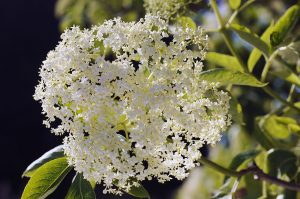
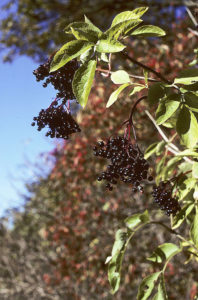
Some varieties are cultivated as ornamentals, including cristata, known as crested cockscomb. In several Asian and African countries, tender parts are eaten as a vegetable. The plant is also used for fodder, and in soap. In several African countries, it is utilized to help control growth of the parasitic witchweed (Striga), which is a pest in cereal crops. (A picture, depicting Striga asiatica, is shown on the page Plants: Parasitic plants.)
Flowers and seeds have antibacterial properties. They are utilized in treatment of bloody stool, haemorrhoids, bleeding from uterus, leucorrhoea, fever, dysentery, jaundice, and diarrhoea. Seeds are also used for various eye diseases. Powdered seeds are regarded as an aphrodisiac. The root is used for colic, gonorrhea, and eczema. A poultice of the stem and leaves are applied to wounds, inflamed areas, and skin problems. In Sri Lanka, the leaves are used for inflammations, fever, and itching, the seeds for fever and mouth ulcers. In China, flowers and seeds are used for gastroenteritis and leucorrhoea. This species is a very effective remedy against the parasite Trichomonas vaginalis, which causes infection of the genitals. It is also used as an antidote for snake poison.
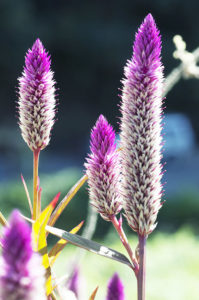
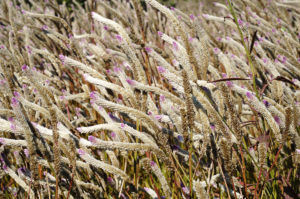
In Europe, in the old days, garlic was regarded as a magic herb, which would protect you against evil. The Ancient Greeks often placed it at crossroads to placate the frightening Hecate, goddess of the underworld, who haunted desolate places at night. People of the Balkans would hang garlic on stable doors to deter milk thieves at night, and in other parts of Europe, garlic rosaries were worn around the neck as protection from evil spirits and disease. In the novel Dracula (1897), by Irish author Abraham Stoker (1847-1912), garlic is utilized to ward off vampires.
Some of the Ancients also believed that garlic was toxic. In his Book of the Epodes, Roman poet Quintus Horatius Flaccus (65-8 B.C.), also known as Horace, says: “If any person at any time with an impious hand has broken his aged father’s neck, let him eat garlic, more baneful than hemlock. Oh! the hardy bowels of the mowers! What poison is this that rages in my entrails? Has viper’s blood, infused in these herbs, deceived me?”
Danish herbalist Simon Paulli (1603-1680) says: ”It is well-known that among animals cocks are the most belligerent, which caused Artemidorus [Artemidorus Daldianus, also known as Artemidorus Ephesius, Greek astrologist and philosopher from the 2nd Century A.D.] to say: ”Cocks are really belligerent and inclined to quarrel and brawl.” However, as many people may know, if you want them to live in all friendliness, you must feed them garlic.”
According to a Hindu legend, The Churning of the Milk Ocean, from the Bhagavata-Purana, garlic came into existence in this way:
The gods had become weakened and had been usurped by the asuras (demons). The gods appealed to the supreme god Vishnu for help, and he suggested that they should regain their power by drinking the miraculous amrita, the nectar of immortality, which they could obtain by churning the cosmic milk ocean, thus bringing the jar with amrita to the surface. However, Vishnu advised the other gods to treat the asuras diplomatically by suggesting them to jointly churn the ocean. When the amrita was brought to the surface, Vishnu would ensure that the gods got hold of it. To perform this stupendous task, the gods and the asuras uprooted the mountain Mandara, placing it upside down in the ocean, and coiling the giant, many-headed naga (serpent) Vasuki around it. By pulling alternately at each end of Vasuki, the mountain would act as a gigantic churn, thus bringing the pot, containing the amrita, to the surface. When that happened, the man-eagle Garuda, Vishnu’s mount, snatched the pot and ran away with it, but some drops spilled and fell on the ground. Later a plant, containing all the divine properties of the amrita, sprouted from these drops – garlic.
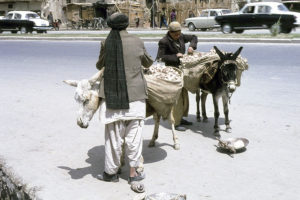

It is widely used in European and Asian cuisines as a vegetable, in soups, sauces, and cakes, and as topping on cold dishes and sour cream products. The seeds are used as a spice, especially in pickles and vinegar. In Jutland, Denmark, dill, thyme, and bog myrtle were once added to a local liqueur. It is also utilized as perfume in soap production, and has been used as an insect repellent.
In the Middle Ages, dill was used by magicians in their spells, and in charms against witchcraft. In Nimphidia, the Court of Faery, from 1627, English poet Michael Drayton (1563-1631) writes:
In his book The Popular Names of British Plants, Richard Chandler Prior (1809-1902) states that the name dill is derived from an old Norse word, dilla (‘to lull’), in allusion to the carminative properties of the plant. The strange name meeting house seed refers to the former custom of chewing dill seeds during long church services to calm rumbling stomachs.
The medical properties of dill were already known in Ancient Greece and Rome, and it is also mentioned in the Bible. English herbalist Nicholas Culpeper (1616-1654) writes: ”Mercury has the dominion of this plant, and therefore to be sure it strengthens the brain. (…) It stays the hiccough, being boiled in wine, and but smelled unto, being tied in a cloth. The seed is of more use than the leaves, and more effectual to digest raw and vicious humours, and is used in medicines that serve to expel wind, and the pains proceeding therefrom.” [‘To stay’ is an old expression for ‘to stop’.]
In Middle Age Denmark, herbalists utilized dill for countless ailments, including stomach pain, excessive air, wounds, eye problems, cough, headache, and hiccups. They also claimed that consuming much dill would curb libido. Herbalist Henrik Smid (c. 1495-1563) says that it ”extinguishes the natural play of Venus”, and herbalist Simon Paulli (1603-80) claims that it ”makes you incompetent and disinclined for the natural play.”
In today’s herbal medicine, dill is considered antibacterial, an antioxidant, and a powerful remedy for menstrual flow. The fruits, as well as an oil derived from them, possess stimulant, aromatic, carminative, and stomachic properties. It is utilized for lowering cholesterol levels, and for colic, excessive gas, bad breath, heartburn, menstrual cramps, depression, and epilepsy. In Chinese traditional medicine, it is said to benefit the spleen, kidney, and stomach.
The specific name is Latin, derived from gravis (‘heavy’) and olens (‘smelling’).
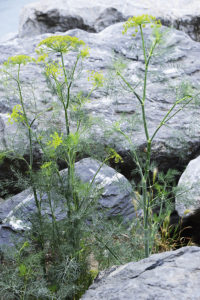
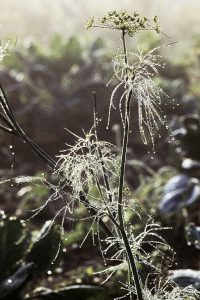
Garden angelica has been utilized medicinally for hundreds of years. In the Middle Ages, dried roots were considered to be an important remedy against plague. In his Paradise in Sole, from 1629, herbalist John Parkinson (1567-1650) puts angelica in the forefront of all medicinal plants.
The root stalks, leaves and fruit possess carminative, stimulant, diaphoretic, stomachic, tonic, and expectorant properties, and today angelica is regarded as a valuable remedy for various heart problems, heartburn, colds, coughs, fever, pleurisy, rheumatism, psoriasis, and urinary diseases. It contains an essential oil with antiseptic properties.
Middle Age legends explain the names angelica and archangelica in various ways. These words are derived from the Latin angelicus (‘angelic’), originally from the Greek angelos (‘messenger’), and from the Greek archos (‘leader’). One legend has it that an angel had a dream that this herb would cure the plague. Another one claims that angels – or even Archangel Gabriel himself – brought the knowledge of this herb to humans. A third legend says that it blooms on the day of Michael the Archangel (May 8, old style; May 18, new style), and on that account it is believed to protect against evil spirits and witchcraft. All parts of this species were thought to be an effective remedy against spells and enchantment, one of its popular names being Root of the Holy Ghost.
Originally, the obsolete specific name officinalis was derived from officina (‘workshop’, or ‘office’), and the suffix alis, which, together with a noun, forms an adjective, thus ‘made in a workshop’. However, in a botanical context, the word denotes plants species that were sold in pharmacies due to their medicinal properties.
Tender stems and leaves of angelica are eaten raw or cooked, especially in the Faroe Islands and Greenland. Stem and seeds are used in confectionery, and candied stems are eaten by the French. The roots, which in autumn has a high content of sugar, are dug up and boiled. Angelica root used to be an important ingredient in chartreuse, the famous liqueur produced by Carthusian monks. The dried leaves, on account of their aroma, are used in the preparation of hop bitters.
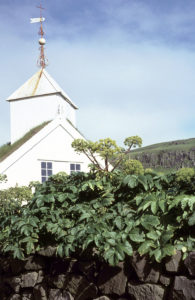

The specific name is Latin, meaning ‘of woods’. However, wild angelica is more commonly found in open areas, including forest and field edges, hedgerows, and the outskirts of marshes.
Medicinally, this plant has been used as a poorer substitute for garden angelica, utilized for a number of ailments, including lung and chest problems, rheumatism, and corns. In Ireland, chewing the roots of the plant before breakfast was said to cure heart palpitations and promote urination, and the plant was also used in treatment of epilepsy and hydrophobia.
It yields a yellow dye. In England, children once used the hollow stem as a ‘pea shooter’.
A near relative, Chinese angelica (A. sinensis) – in Chinese 當歸 (‘female ginseng’) – is much utilized in Chinese traditional medicine, mainly for treatment of menstrual disorders and other ailments, including liver problems, hair loss, sciatica, and shingles. The root is a common ingredient in Chinese cooking.
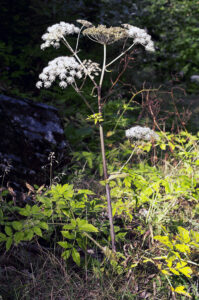
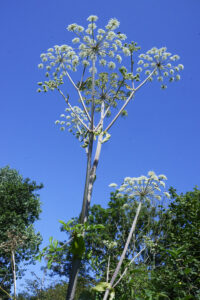
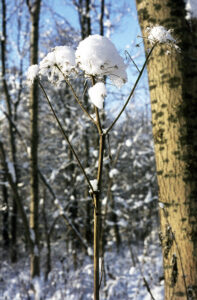
Originally, poison hemlock was called Cicuta in Latin and in several South European languages, but as this name was also applied to another poisonous umbellifer, the water-hemlock (Cicuta virosa), Swedish naturalist Carl Linnaeus (1707-1778), decided to apply the name Conium after the Greek name of the plant, koneion, from konas, to ‘whirl around’, as it causes vertigo and death when eaten. Naturally, the common names poison parsley, devil’s bread, and devil’s porridge also refer to its great toxicity.
The plant is sedative and antispasmodic, paralyzing the centres of motion. For this reason, it was recommended as an antidote to poisoning from strychnine and similar poisons. It was also prescribed for tetanus, hydrophobia, teething in children, epilepsy from dentition, cramps, etc. When inhaled, it was said to relieve cough associated with bronchitis and asthma, and also whooping-cough.
Greek physician, pharmacologist, and botanist Pedanius Dioscorides (died 90 A.D.), who was the author of De Materia Medica (five volumes dealing with herbal medicine), recommended this herb for external treatment of herpes. In the Middle Ages, hemlock was applied to cancerous tumours, and, mixed with betony and fennel seed, it was thought to cure rabies.
Formerly, poison hemlock caused several deaths, because its root was confused with the root of parsnip. In some cases, the poison was utilized to get rid of voles by soaking nuts in hemlock juice and then placing them at the entrance to their dens.
Greek philosopher Socrates (469-399 B.C.), who was accused of introducing new gods and of corrupting youth, was sentenced to commit suicide by consuming hemlock juice. His last minutes are described in Phaido, by Greek poet Plato (c. 428-348 B.C.):
”(…) returned with the jailer carrying the cup of poison. Socrates said: “You, my good friend, who are experienced in these matters, shall give me directions how I am to proceed.”
The man answered: “You have only to walk about until your legs are heavy, and then to lie down, and the poison will act.”
At the same time he handed the cup to Socrates, who in the easiest and gentlest manner, without the least fear or change of colour or feature, looking at the man with all his eyes, as his manner was, took the cup and said: “What do you say about making a libation out of this cup to any god? May I, or not?”
The man answered: “We only prepare just so much as we deem enough.”
“I understand,” he said, “but I may and must ask the gods to prosper my journey from this to the other world, even so, and so be it according to my prayer.”
Then raising the cup to his lips, quite readily and cheerfully he drank off the poison. (…) he walked about until, as he said, his legs began to fail, and then he lay on his back, according to the directions, and the man who gave him the poison now and then looked at his feet and legs; and after a while he pressed his foot hard, and asked him if he could feel. Socrates said no; and then his leg, and so upwards and upwards, and showed us that he was cold and stiff.
Socrates felt them himself, and said: “When the poison reaches the heart, that will be the end.”
He was now beginning to grow cold about the groin, when he uncovered his face, for he had covered himself up, and said his last words: “Crito, I owe a cock to Asclepius. Will you remember to pay the debt?”
In Ancient Greece, it was customary to sacrifice a cock to Asclepius, the god of medicine, when you had recovered from an illness. In this case, Socrates had left the vulnerable, sickly life and had been healed to eternity.
In an old Danish medicinal book, herbalist Henrik Harpestræng (died 1244) says: ”If a virgin applies the juice to her breasts, they will become stiff and stay thus” (i.e. they won’t grow any bigger). Furthermore, he claims that ”applied above the penis, the juice restricts the lust for women and spoils all the semen, by which a child is born.”
In another Danish herbal book, the juice is recommended for monks and nuns, as it would cause them to behave chastely. It was also recommended for mothers, when their child was to be weaned. The juice was applied to the nipples – a rather drastic method, as the child might easily be poisoned.
In his book Art of Simpling, English botanist William Coles (1626-1662), also called William Cole, writes: “If asses chance to feed much upon hemlock, they will fall so fast asleep that they will seeme to be dead, in so much that some thinking them to be dead indeed have flayed off their skins, yet after the hemlock had done operating they have stirred and wakened out of their sleep, to the griefe and amazement of the owners.”
This species is mentioned in the tragedy King Lear, by William Shakespeare (1564-1616):
The specific name maculatum means ‘spotted’, referring to the reddish spots on the stem. According to a Christian legend, these spots represent the brand, which was applied to Cain’s brow after the killing of Abel.
The common name hemlock is derived from the Anglo-Saxon words hem (‘border’, ‘shore’) and leác (‘plant’). According to a 14th Century herbal book, there are two kinds of hemlock, one being the “grete homeloc, called kex, or wode whistle, being of no use except for poor men’s fuel, and children’s play.” The word kex may mean ‘with a hollow stem’, or it may stem from a Swedish name of the plant, käx, which possibly refers to the similarity of the umbel to a primitive basket for catching fish, called käx. Wode is Old English for ‘mad’, or ‘insane’.


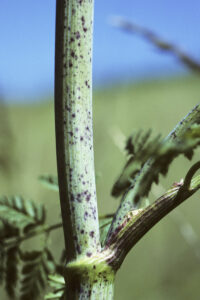
All parts of the plant are edible, and the species is utilized as food over most of the world. The strongly aromatic fresh leaves are eaten as a vegetable, and the dried seeds are a very common spice, either whole or ground, especially in Indian cuisine, where it is called dhanya. It is one of the main ingredients in the popular spice mixture garam masala. The root is used in Thai cuisine.
Since 1610, Carmelite friars have been making so-called Carmelite drops, a liquor, in which coriander is one of the ingredients.
In California, aphids are a serious pest in organic lettuce fields. Experiments have shown that coriander was among the species that, when planted with lettuce and allowed to flower, would attract hoverflies, the larvae of which eat up to 150 aphids per day. (Source: E. Brennan. Efficient Intercropping for Biological Control of Aphids in Transplanted Organic Lettuce, in: articles.extension.org).
The generic name is derived from the Greek koriannon (‘stink bug’) – a name that was probably given because of the very powerful fragrance of this plant. The Spanish name cilantro is a corruption of Coriandrum, whereas the name Chinese parsley stems from the very popular usage of this herb in Chinese cuisine.
Coriander has been utilized medicinally for at least 3000 years. Since the Middle Ages, it was used as a digestive and for stomach trouble, including flatulence. Other ailments traditionally treated with coriander include skin inflammation, diarrhoea, high cholesterol levels, mouth ulcers, anemia, and diabetes. Alcohol, containing coriander, is rubbed on rheumatic joints and muscles.
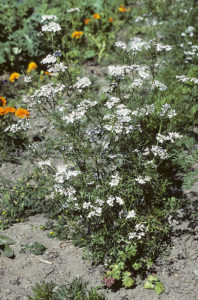
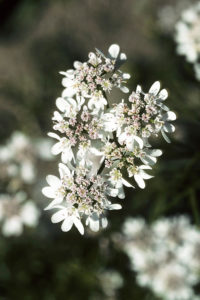
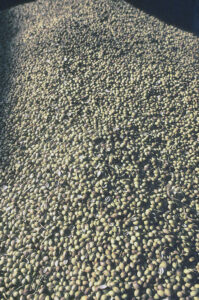
In North America and Australia, it has invaded open grasslands, meadows, roadsides, abandoned fields, waste areas, and degraded prairies, often displacing native plants. In his delightful book All about Weeds, American botanist Edwin Spencer (1881-1964) says: “(…) authorities say that it is the cultivated carrot run wild. If it is, it has run a long way and into all sorts of places. It seems never to be the least particular in its choice of a habitat. It thrives in uncultivated ground, wherever or whatever it may be, as long as it is not densely shaded.”
Some authorities claim that 13 subspecies exist, 12 wild taxa and one cultivated, named ssp. sativus. The original wild species, named ssp. carota, has a thin, white root, which has a bitter taste and is inedible. It is generally assumed that the cultivated purple form, which contains red anthocyanins, originated in Afghanistan and was later cultivated in Afghanistan, Russia, Iran, Pakistan, and Turkey. The purple carrot, together with a yellow variety, spread to the Mediterranean and Western Europe around the 11-14th Centuries, and to China, India, and Japan in the 14-17th Centuries. The orange form, which contains carotene, probably arose somewhere in Europe through gradual selection within yellow carrot populations. The Dutch types Long Orange and Horn were the basis for the orange carrot cultivars that are now grown all over the world. In Asia, they have largely replaced the purple and yellow types because of superior yield and changing fashion. (Source: cabi.org)
The generic name is derived from the Ancient Greek daukos, a term first applied by Greek-Roman physician, surgeon, and philosopher Aelius Galenus (c. 129-210 A.D.), also known as Claudius Galenus or Galen of Pergamon, to distinguish the carrot from the parsnip. The specific name, derived from the Greek karoton (‘carrot’), first appears in the writings of Greek rhetorician and grammarian Athenaeus of Naucratis (c. 170-220 A.D.). The English name evolved around 1530, derived from Middle French carotte.
The popular name bird’s-nest refers to the umbel, which, after flowering, curls upwards, forming a dense structure, which somewhat resembles a bird’s nest. The popular names bishop’s lace and Queen Anne’s lace were given in allusion to the inflorescence, which resembles lace. The Anne in question may refer to Queen Anne of Great Britain (1665-1714), or to her great grandmother, Anne of Denmark (1574-1619), who was married to King James Charles Stuart (1566-1625). In those days, lace was prominent in fine clothing.
In the centre of each inflorescence is one, or sometimes a few, red or purple flowers. According to legend, they are thought to represent a blood droplet where Queen Anne pricked herself with a needle when she was making the lace. One biological explanation is that they may attract insects. This explanation, however, is not satisfactory. Other umbellifers, which possess only white flowers, have no difficulty in attracting insects. As Spencer (above) expresses himself: “What possessed old Mother Nature to attempt to hide that purple stitch in the center of each of the Queen’s snow-white kerchiefs?”
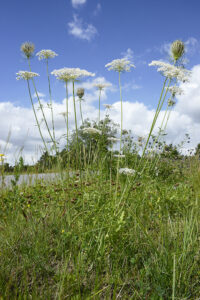
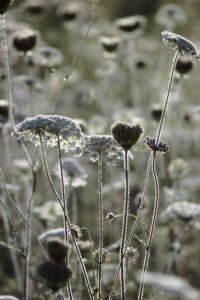
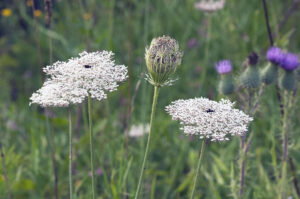
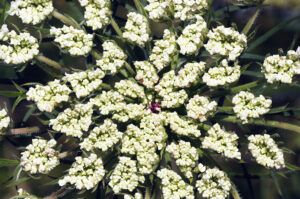
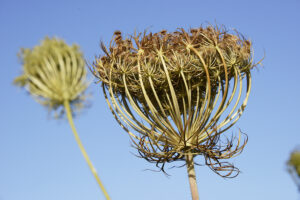
In his delightful book All about Weeds, American botanist Edwin Spencer (1881-1964) writes about pollination of milkweeds:
“(…) they have one of the most distinct flowers of the plant kingdom. It is made for the purpose of tricking insects in order that cross fertilization may be assured. (…) insects attempting to get nectar from the cups in the flower. There are five of these cups on each flower, and they usually are found hanging mouth downward. They are very smooth, and a foot of the insect that tries to alight on one of them invariably slips off and lands on the slit, which lies between two of the cups. This is exactly what should happen; the very purpose for which the flower was made. In that slit lies the male principle of the flower in such a position that it may never come in contact with the female organ, unless it is pulled out and pulled in again. So the foot of the insect goes into the slit and finds itself caught as if between two tough little wires. If the insect is strong enough, a jerk or two will bring out the foot, and along with it two little bags of pollen, which ride away on the insect’s leg to another flower, where the foot again slips into a slit, but this time carrying the pollen bags (…) right down upon the stigmatic surface of the female organ. There the bags stay, and the pollen in them develops as it should (…). Of course, that same insect leg may come out of the second flower slit with two more bags of pollinia hanging to it like two little saddle bags. (…) it takes a strong leg to do this work, and strong insects are sometimes seen with several bags of pollinia hanging to their legs. If the insect is not strong enough, he pays dearly for the sip of nectar he gets. (…) if he cannot pay for that nectar by carrying away to another flower those two little pollinia bags, he hangs there until he dies (…).”
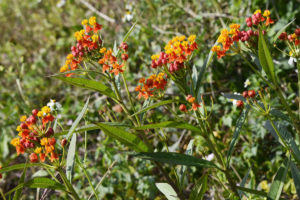

In India, giant milkweed is used as an insecticide and fungicide. Bark fibres are utilized for ropes, carpets, fishing nets, and sewing thread. A fermented mixture of giant milkweed and salt is employed to remove the hair from goat skins for production of nari leather. The seed hairs are often stuffed into pillows.
In Nepal, juice of bark and root are taken for diarrhoea and dysentery. Heated leaves can relieve muscular pain. Dried leaves are smoked, the smoke blown out through the nose to relieve sinusitis. Juice of the leaves is taken for fever, and juice of young buds is dripped into the ear for earache. Powdered flowers are used for cough, colds, and asthma. The milky juice, and also a paste of the root, is applied to wounds, sprains, boils, and pimples. In Ayurvedic medicine, the root bark is regarded as a febrifuge, anthelmintic, depurative, expectorant, and laxative. The powdered root is used for asthma, bronchitis, and dyspepsia, the leaves for treatment of paralysis, painful joints, swellings, and fever. The latex is used as a purgative and an emetic.
The flowers are widely used as decoration. It is told that Hawaiian Queen Liliuokalani (1838-1917) wore them as a symbol of royalty, strung into leis (garlands).
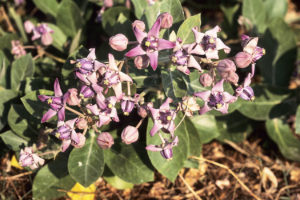
The generic name is from the Greek arisamos (‘conspicuous’, ‘distinguished’), naturally alluding to the spectacular appearance of these plants. A common name of the genus is Jack-in-the-pulpit. To some people, the flower resembles a person in a pulpit: ‘Jack’ is the flowering club, and the ‘pulpit’ is the spathe. Another name is cobra plant, referring to the cobra-like spathe on some species. The Nepalese name of the genus is sarpa ko makai (‘snake maize’), likewise alluding to the cobra-like spathe, and to the cluster of fruits, which resembles a maize cob.
Outside the summer months, fresh vegetables are often difficult to find in rural areas of the Himalaya. A widespread method of obtaining nutrients from vegetables at times, when fresh ones are not available, is to make gundruk – fermented leaves of certain cultivated plants, including cabbage, mustard, and radish, and of various wild plants, such as Arisaema utile, a buttercup, Ranunculus diffusus, and Nepalese dock (Rumex nepalensis).
Two methods are utilized to make gundruk. One is to wash the leaves and leave them to dry for a day, after which the last juice is beaten out of them. They are then stuffed firmly into a container, which is tightly closed, making it airtight. About a week later, the fermented leaves are taken out and left to dry in the sun, after which they are stored in a dry place for later use. Another method is to boil the leaves for a short time and then stuff them tightly in a container. After a short period of time, the juice is removed and boiling water added. The leaves are then left to ferment for 4-5 days, before being dried in the sun. (Source: Manandhar, N.P. 2002. Plants and People of Nepal. Timber Press)
Gundruk can be kept for about a year. The fermented leaves emit a characteristic fragrance, and they have a unique, strong, and lovely taste – at least in my opinion.
The tuber and ripe fruits of various Himalayan Arisaema species are also edible after being boiled. In Nepal, the powdered corm of A. tortuosum is applied to snake bites. Juice of the corm is applied to wounds of livestock to kill fly larvae. Seeds are fed to sheep with colic.
Numerous species of Arisaema are described on the page Plants: Himalayan flora 1.
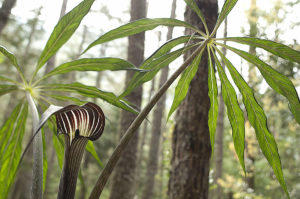
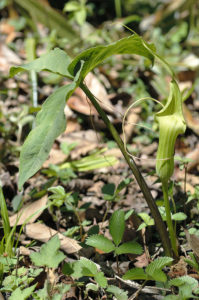

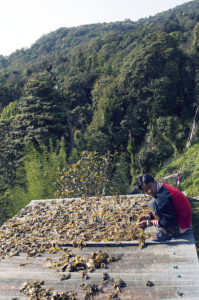
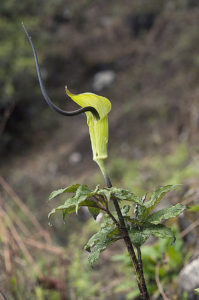

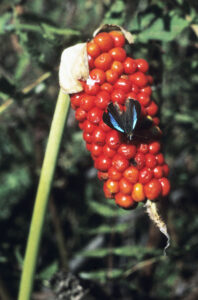
Later, it was used in the treatment of various respiratory diseases, nervous disorders, rheumatism, and dropsy.
Eastern skunk cabbage is native to eastern North America, from Nova Scotia and southern Quebec, westwards to Minnesota and southwards to North Carolina and Tennessee.
In spite of its unpleasant odour, skunk cabbage is praised in a poem, My Fetid Friend, by Joshua Schwartz (born 1976):
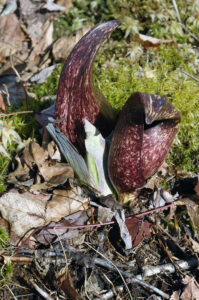
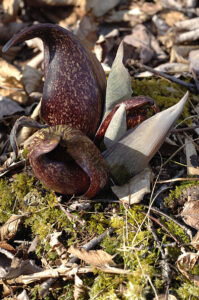
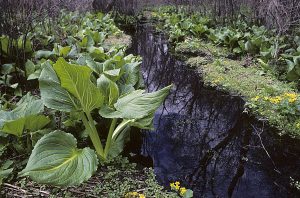
The generic name is the classical Latin name of the common, or English, ivy (below), stemming from Proto-Indo-European ghed (‘to seize’ or ‘to grasp’). The common name is derived from Old English ifig, ultimately from the German Efeu, of unknown origin.
In his Herball (1597), English herbalist John Gerard (c. 1545-1612) recommends water infused with ivy leaves as a wash for sore or watering eyes. Another herbalist, Nicholas Culpeper (1616-1654), says: “It is an enemy to the nerves and sinews taken inwardly, but most excellent outwardly.”
In his work The New Family Herbal: Comprising a Description, and the Medical Virtues of British and Foreign Plants, etc., etc., herbalist Matthew Robinson tells us that the flowers decocted in wine restrains dysentery, and that the yellow berries are good for those who spit blood, and also against jaundice.
In Ancient Greek mythology, ivy was dedicated to the wine god Dionysos, symbolizing joy and merriment. His followers adorned themselves with foliage of grape vine and ivy, and poets wore ivy wreaths around their forehead.
In former days, English taverns bore over their doors the sign of an ivy, to indicate the excellence of the liquor supplied in them.
The specific name is Greek, meaning ‘twisted’ or ‘spiralled’, which of course refers to its climbing habit.
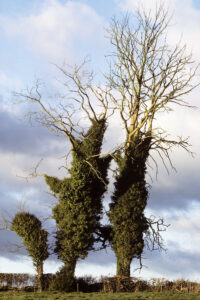
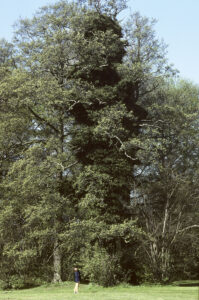
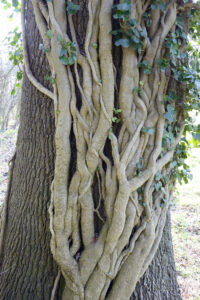
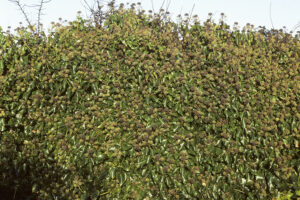
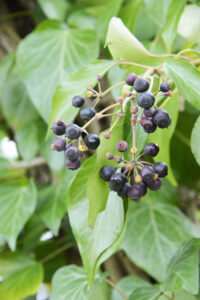
Ginseng has been utilized in traditional medicine for thousands of years. The most popular species are Chinese ginseng (P. ginseng) and American ginseng. The first use of ginseng in Chinese medicine dates back to the famous classic herbal book 神農本草經 (Shen Nong Ben Cao Jing), which was written c. 200 A.D., its origin being attributed to the famous emperor and herbalist Shen Nong, who ruled about 2750 B.C. In this book, it is said: “Ginseng is a tonic to the five viscera, quieting the animal spirits, stabilizing the soul, preventing fear, expelling the vicious energies, brightening the eye, improving vision (…) and prolonging life.”
Today, ginseng is mainly taken for its restorative qualities, improving a poor immune system, increasing physical endurance, and treating chronic infection, diabetes, headache from exhaustion, depression, and, taken with Ginkgo biloba, dementia. It is also widely regarded as an excellent aphrodisiac, being a good remedy for erectile dysfunction, again taken with Ginkgo.
American ginseng was used by several Native American tribes for various ailments, including headache, ear ache, fever, stomach problems, and female infertility, and also as an aphrodisiac. Creeks used it for lung problems, the Chippewa people to prolong the life of a dying person.
Naga people of north-eastern India dry and grind roots of Himalayan ginseng (P. pseudoginseng), taking the powder orally to treat heart problems, diabetes, cancer, tuberculosis, and ulcers, and also as an aphrodisiac. They also eat the leaves as a vegetable.
Among several Native American tribes, American ginseng was regarded as a magic herb. Creeks would carry the root to ward off evil spirits.
Today, Chinese ginseng and American ginseng are both extremely rare in the wild, having been seriously over-harvested. American ginseng may even be extinct in the wild state. Both species, however, are widely cultivated, and, therefore, not at risk of becoming extinct.
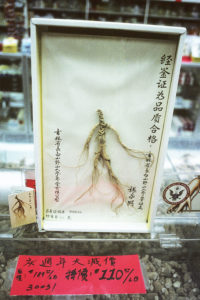

The generic name honours American botanist Sereno Watson (1826-1892), who joined the Geological Exploration of the Fortieth Parallel. From 1867 to 1872, this survey conducted field work in western United States. Later he became curator of the Gray Herbarium at Harvard University. The popular name refers to the numerous sharp spines on the leaf-stalk.
In pre-Columbian North America, saw palmetto fibres were widely traded. The leaves are still used for thatching by several indigenous peoples. The fruit is edible and nutritious and was collected for food by several native tribes. It was also taken as an aphrodisiac. The Seminoles and the Bahamians utilized it to treat poisoning from eating tainted fish.
Saw palmetto fruits have expectorant and soothing properties, and traditionally they have been taken for sore throat, cough, colds, bronchitis, and asthma. Research indicates that they are a good remedy for impotence. The fruits have also been used for migraine headache, chronic pelvic pain, bladder problems, and prostate cancer, but new research has not confirmed that the species is effective in treating any of these medical conditions. It may, however, be effective in treatment of benign enlargement of the prostate.
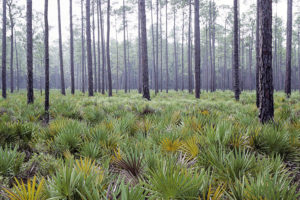
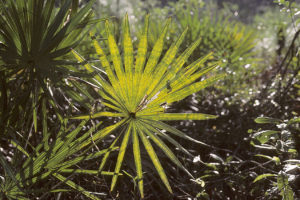
Various plants, including yarrow, were found in a 50-60,000-year-old Neanderthal grave in Iraq, perhaps indicating that these plants were used medicinally. (Source: G.P. Shipley & K. Kindscher 2016. Evidence for the Paleoethnobotany of the Neanderthal: A Review of the Literature. hindawi.com/journals/scientifica/2016/8927654)
English herbalist John Gerard (c. 1545-1612) informs us that during the Trojan War the Greek hero Achilles used yarrow to stop bleeding on wounded soldiers. Hence, the name Achillea was applied to the genus by Swedish naturalist Carl Linnaeus (1707-1778). Herbalist John Parkinson (1567-1650) tells us that “if it be put into the nose, assuredly it will stay the bleeding of it.” [‘To stay’ is an old expression for ‘to stop’.]
Popular names, attesting to the ability of yarrow to stop bleeding, include bloodwort, nosebleed, staunchweed, knight’s milfoil, and soldier’s woundwort. Highlanders of Scotland still produce an ointment of yarrow to apply to wounds.
In earlier days, yarrow was dedicated to the Evil One, hence the folk names devil’s nettle, devil’s plaything, and bad man’s plaything. It was also used for divination in spells. In eastern England, where yarrow is called yarroway, a peculiar mode of divination formerly took place with its leaves, with which you would tickle the inside of the nose, while reciting the following lines:
Herbalist Nicholas Culpeper (1616-1654) speaks of yarrow as a profitable herb in cramps, and Parkinson (above) recommends a decoction to be drunk warm for ague (malaria).
Among the Micmac people of north-eastern North America, the stalk was chewed or stewed to induce sweating to break fevers and colds. They also pounded the stalks into a pulp to be applied to wounds, insect and snake bites, sprains, and swelling. Among other American tribes, boils, inflamed eyes, and cracked skin on your hands were bathed in a decoction of this plant. This decoction was drunk against fever, colic, and dyspepsia, and it was considered to be blood cleansing and diuretic. Leaves were stuck into the ears in case of toothache, and boiled leaves were wrapped around arthritic limbs. A decoction of the flowers was used internally for stomach pain, and liver and kidney problems, externally against itching. The root was chewed for colds.
Today, yarrow is utilized to relieve menstrual cramps, for colic and infections, and as a diuretic. It stimulates sweating and reduces fever. In the Orkneys, milfoil tea is drunk to dispel melancholy.
In former days, an ounce of yarrow was sewed up in flannel and placed under the pillow before going to bed. You would then repeat the following words, which would supposedly bring a vision of your future husband or wife:
In the seventeenth century, yarrow was an ingredient in salads. Flowers and leaves have a bitter, pungent taste, hence the popular name old man’s pepper. It has also been employed as snuff.
In Sweden, yarrow was formerly used in beer brewing, hence its popular name jordhumle (‘field hops’). Linnaeus considered beer of this type more intoxicating than beer brewed with hops.
In a Chinese form of divination, hexagrams are generated by throwing sticks, made from yarrow stalks – a random method, using the I Ching, or Book of Changes, consisting of sixty-four hexagrams, each of them six lines, each of which is either yin (dark forces) or yang (light forces).
In his novel Cold Mountain, from 1997, American author Charles Frazier (born 1950) relates an old superstition connected with the leaves of yarrow. If its crushed leaves would emit a sharp smell like falling snow, it was a sure sign that the coming winter was going to be hard.
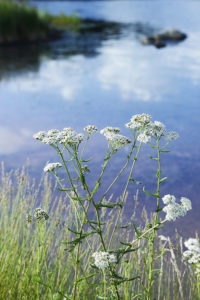
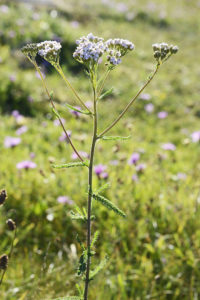
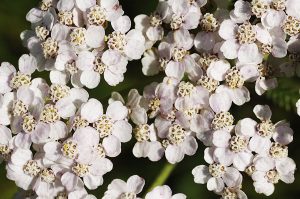
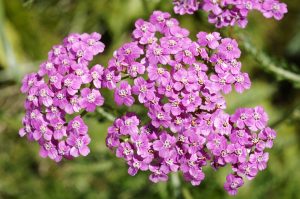
The juice of both species is widely used to treat cuts, wounds, and burns, and for its antibacterial properties. In Nepal, goat-weed is often used in traditional medicine. A paste of the root, mixed with bark of Schima wallichii, is applied to set dislocated bones. A paste of the leaves is applied to remove thorns from the feet, to boils, and, mixed with several other plants, to snakebites. Crushed leaves are rubbed into the hair to expel lice. A paste of the flowers is used to treat rheumatism, and juice from them is applied to scabies. Juice of the flowers, mixed with tulsi (Ocimum tenuiflorum) and boiled for 10 minutes, is taken for colds and cough. In Brazil, an infusion of goat-weed is employed to treat colic, colds, fever, diarrhoea, rheumatism, and spasms. In Africa, both species are used to treat fever, rheumatism, headache, pneumonia, and colic.
However, ingestion of these plants is quite risky, as they may harm your liver. They are also toxic to grazing animals, causing liver lesions.
Goat-weed is utilized as an insecticide and nematicide. In India, an extract of Mexican blueweed has been employed to kill mosquito larvae.
Goat-weed has a number of other popular names, including chickweed, whiteweed, bastard agrimony, and appa grass. In Vietnamese, it is called cứt lợn (‘pig faeces’), because it often grows in dirty areas. Other names of Mexican blueweed include flossflower, bluemink, pussy foot, and Mexican paintbrush.
Ageratum species have evolved an ingenious method of protecting themselves from insects. They produce a compound, which interferes with the function of the organ responsible for the secretion of juvenile hormones. This chemical will trigger the next moulting cycle to prematurely develop adult structures and can render most insects sterile if ingested in large enough quantities. (Source: wiki.medicinalplants-uses.com)
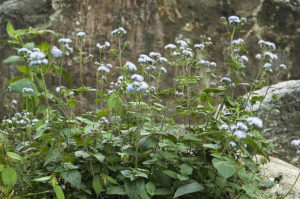
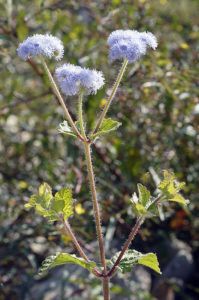
One authority states that the specific name stems from the Celtic word llap (‘hand’), alluding to the ‘gripping’ burs. The popular name herrif is derived from two Anglo-Saxon words, haeg (‘hedge’), and reafe (‘robber’), perhaps referring to the vigorous growth of this species. Other folk names include fox’s clote, thorny bur, clot-bur, beggar’s buttons, and cockle buttons.
In his delightful book All about Weeds, American botanist Edwin Spencer (1881-1964) writes about the burs: “Sometimes (a boy) is mean enough to throw a bunch of the burs into the hair of a rival, or even into the hair of the girl he thinks has snubbed him. She who has had this experience needs no technical description of the burdock.”
In the tragedy Troilus and Cressida, by William Shakespeare (1564-1616), Pandarus says: “They are burs, I can tell you, they’ll stick where they are thrown.”
Another Shakespeare tragedy, King Lear, also has a direct reference to this plant:
Khadzhi (Hadji) Murat is the title of a short novel, written by Tolstoy 1896-1904, in which the main character is an Avar rebel from the Caucasus, who, because he wants revenge, enters into a fragile alliance with the Russians, whom he until then has fought against.
English herbalist Nicholas Culpeper (1616-1654) says: “The burdock leaves are cooling and moderately drying, wherby good for old ulcers and sores. (…) The leaves applied to the places troubled with the shrinking in the sinews or arteries give much ease: a juice of the leaves or rather the roots themselves given to drink with old wine, doth wonderfully help the biting of any serpents – the root beaten with a little salt and laid on the place suddenly easeth the pain thereof, and helpeth those that are bit by a mad dog. (…) The seed being drunk in wine 40 days together doth wonderfully help the sciatica: the leaves bruised with the white of an egg and applied to any place burnt with fire, taketh out the fire, gives sudden ease and heals it up afterwards. (…) The root may be preserved with sugar for consumption, stone and the lax. The seed is much commended to break the stone, and is often used with other seeds and things for that purpose.”
Traditionally, in many countries, farmers have applied bruised leaves as a remedy for hysteria. Among American natives, a decoction of the root of a near relative, the lesser burdock (Arctium minus), was drunk for whooping cough and arthritis. It was considered to be sweat-inducing and blood cleansing, and also a diuretic.
In modern herbal medicine, root and seeds are used for boils, scurvy, psoriasis, rheumatism, and arthritis. The leaves are applied externally as a poultice for tumours, gouty swellings, bruises, ulcers, and inflammation, and an infusion of the leaves is used for indigestion. Burdock is also utilized for seborrhea, which causes dandruff, and it is regarded as one of the best blood purifiers. Research indicates that it may inhibit attack of HIV virus. – In Nepal, the root is utilized as a diuretic and diaphoretic, and juice of the plant is applied to boils.
Burdock roots are edible, with a sweet and mucilaginous taste. They are much utilized in Chinese cuisine. The stalk is also edible. After removing the rind and boiling the stalk, it tastes like asparagus. However, it is highly laxative, so only small amounts can be enjoyed.

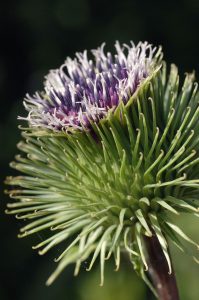
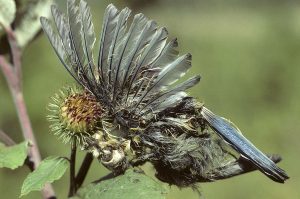
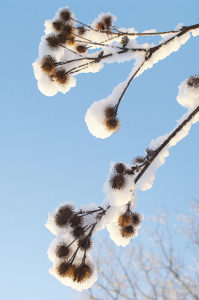
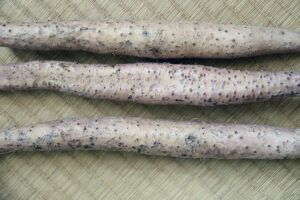
In his illustrated herbal Neuwe Kreuterbuch (from 1588), German physician and botanist Jakob Dietrich (1525-1590), also called Jacobus Theodorus, but better known under the name Tabernaemontanus and often called ’the father of German botany’, describes the usage of arnica to treat bleeding: ”In Sachsen, common people use arnica, when they fall down from a high place, or are otherwise hurt during work. You take a handful [of flowers], boil them in beer and drink this concoction in the morning, whereupon you cover yourself to sweat. Where you were hurt feels great pain for two or three hours, but then you are cured.”
In Denmark, arnica was much utilized in the 1700s. In an herbal book, it is said that it has dissolving and neurotonic properties, and another source mentions that a decoction of the plant, drunk with beer, can be used for headache, pressure on the chest, and pains in arms and legs. Arnica flower tea was used as a laxative.
In another herbal from the 1700s, it is said that the flower, laid on an aching tooth, would cause ‘the worms’ to fall out. Danish herbalist Laust Glavind (died 1891) recommended a decoction of arnica and linseed in beer for insanity. As late as in the 1920s, herbal tea with arnica was drunk by women in northern Jutland to treat sterility.
To prevent hair loss, the scalp was bathed in beer, boiled with arnica root, and the label on an Austrian remedy for growth of hair, Quinar, states the following: “Substances are extracted from the flowers, which in an effective way will make your hair bouffant, luxuriant, and beautiful. For centuries, these substances have been known as life-giving for hair growth. Dissolved in alcohol, with added quinine, they form the most important ingredients in Quinar.”
In modern herbal medicine, arnica is regarded as a stimulant and diuretic, chiefly used for low fever and paralysis. It is excellent for shock. Arnica oil is a good remedy for bruises and sprains, but it should not be applied to open wounds. It is also used for insect bites, arthritis, muscle and cartilage pain, chapped lips, and acne.
The leaves were formerly utilized as a substitute for tobacco – hence the name mountain tobacco. Today, an extract of the plant is used for flavouring beverages, frozen dairy desserts, candy, baked goods, gelatin, and puddings, and also as an ingredient in hair tonics and anti-dandruff remedies. The oil is used in perfumes and cosmetics.
An old German folk name of arnica is Wohlverleih (‘endowed with good’). However, as this plant is very poisonous, it should not be used internally. The common name leopard’s bane refers to its great toxicity.
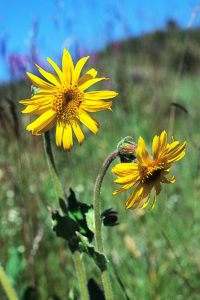
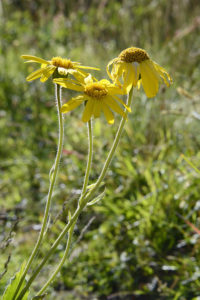
The genus is named for Artemis, the Greek goddess of wilderness and wild animals, hunting, childbirth and virginity, protector of young girls, and also bringer and reliever of disease in women. In his Herbarium, Roman philosopher and scholar Lucius Apuleius (c. 124-170 A.D.) writes: “Of these worts that we name Artemisia, it is said that Diana found them and delivered their powers and leechdom to Chiron the Centaur, who first from these worts set forth a leechdom, and he named these worts from the Greek name of Diana, Artemis.”
Common wormwood held a high reputation among herbalists in Ancient Greece and Rome. According to them, it would counteract the effects of poisoning by hemlock (see Conium maculatum, Apiaceae), toadstools, and the biting of the sea dragon. During the Middle Ages, in the Nordic countries, wormwood was used for all sorts of ailments and diseases. In 1546, Danish herbalist Henrik Smid notes: ”Where is the person who can explain all the virtues of wormwood?”
In his compendium The Vegetable System, English botanist John Hill (c. 1714-1775) says: “The leaves have been commonly used, but the flowery tops are the right part. These, made into a light infusion, strengthen digestion, correct acidities, and supply the place of gall, where, as in many constitutions, that is deficient. (…) In the morning, the clear liquor with two spoonfuls of wine should be taken at three draughts, an hour and a half distance from one another. Whoever will do this regularly for a week, will have no sickness after meals, will feel none of that fulness so frequent from indigestion, and wind will be no more troublesome; if afterwards, he will take but a fourth part of this each day, the benefit will be lasting.’”
About sea wormwood, English herbalist Nicholas Culpeper (1616-1654) says: “Boiling water poured upon it produces an excellent stomachic infusion, but the best way is taking it in a tincture made with brandy. Hysteric complaints have been completely cured by the constant use of this tincture. In the scurvy and in the hypochondriacal disorders of studious, sedentary men, few things have a greater effect: for these it is best in strong infusion. The whole blood and all the juices of the body are effected by taking this herb.”
Dr. Hill (see above) states: “This is a very noble bitter. Its peculiar province is to give an appetite, as that of the common wormwood is to assist digestion. The flowery tops and the young shoots possess the virtue, the older leaves and the stalk should be thrown away as useless. (…) The apothecaries put three times as much sugar as of the ingredient in their conserves; but the virtue is lost in the sweetness, those will not keep so well that have less sugar, but ’tis easy to make them fresh as they are wanted.”
In modern herbal medicine, common wormwood is used as a tonic, stomachic, febrifuge, and as an anthelmintic. It is also a good remedy for indigestion, debility, and gall bladder infection. As a nervine tonic, it is particularly helpful against epilepsy and for flatulence. Numerous closely related Asian species are also utilized medicinally. Among certain American tribes, tea made from leaves and flowerheads of mugwort (Artemisia vulgaris) was taken as a stomachic, to calm the nerves, and to reduce fever. It was also drunk in case of menstrual problems, and to expel intestinal worms.
The common name green ginger was given in allusion to the medicinal properties of common wormwood, comparable with those of ginger (Zingiber officinale, Zingiberaceae).
Since the Middle Ages, sommon wormwood has been utilized to get rid of lice and fleas. It was strewn in bedrooms and placed among clothes and furs to keep away moths. In corn lofts, ‘worms’ and snout beetles were exterminated with wormwood, and smoke from the burning herb would keep flies and mosquitos at bay.
In July’s Husbandry, from 1577, English poet and farmer Thomas Tusser (1524-1580) says:
An old proverb says: “As bitter as wormwood,” and all members of the genus are remarkable for their extreme bitterness. For hundreds of years, both common and sea wormwood have been added to alcohol in the Nordic countries, and still today, two alcoholic drinks in southern Europe, vermouth and absinthe, are spiked with wormwood. However, absinthe is addictive, in large quantities even deadly.
Today, wormwood is cultivated as an ornamental, and it can also be utilized for dyeing, producing yellow colours.
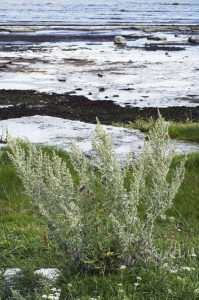
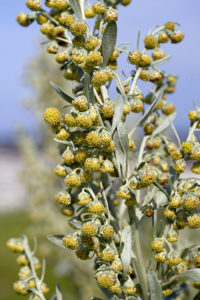
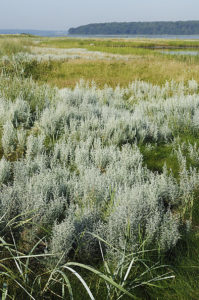
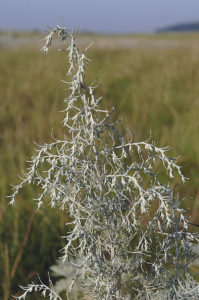
Chicory was cultivated in Ancient Egypt and was utilized medicinally from at least the 1st Century A.D. The Egyptians, as well as the Greeks and the Romans, considered the bitter leaves to be blood cleansing, and to invigorate the nerves. Other old herbalists recommended the leaves, when bruised, as a good poultice for swellings, inflammations and inflamed eyes, and that “when boiled in broth for those that have hot, weak and feeble stomachs doe strengthen the same.”
English poet and farmer Thomas Tusser (1524-1580) considered chicory a useful remedy for ague (malaria), and herbalist John Parkinson (1567-1650) found it to be a “fine, cleansing, jovial plant.”
In the 16th and 17th Centuries, followers of the Doctrine of Signatures took it for granted that the milky juice of the plant would be a good remedy for sore breasts of nursing mothers, whereas its bright blue flowerheads symbolized blue eyes and would thus be an effective remedy for inflammation of the eyes.
Today, herbalists recommend chicory as a stomachic and diuretic, and as a blood purifier. It also stimulates the heart and liver. The root is widely used to expel intestinal worms and other parasites.
The flowerheads of chicory unfold in the morning, and until around noon they turn, always pointing toward the sun, after which they wither. A German name of the plant is Wegwarte (’waiting at the road’). A legend has it that chicory is a transformed virgin, standing at the road side, looking for her sweetheart, turning this way and that.
It has been suggested that the common name succory stems from the Latin succurrere (‘to run under’), referring to its long root. However, it may be a mere corruption of chicory, from Cichorium, a word of Egyptian origin. Hendibeh is the Arabic name of a near relative, endive (C. endivia), and the specific name intybus is a corruption of this word. What a lot of corruption!
Naturally, the common names blue sailors, ragged sailors, blue daisy, blue dandelion, and blue weed all refer to the pretty blue flowerheads, whereas the name coffee weed refers to the earlier usage of the root, which, dried and pounded, was widely utilized as a substitute for coffee, but this usage has largely disappeared.
The Ancient Egyptians, Arabs and Romans ate the leaves as a vegetable or in salads. Today, young leaves of cultivated forms are still eaten in salads, but they are generally blanched, as this removes the bitterness of the leaves. The French call blanched leaves barbe de capuchin (‘Capuchin monk’s beard’) – a favourite winter salad.
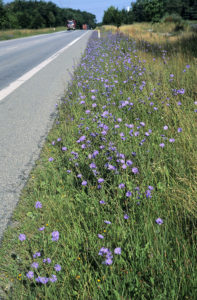
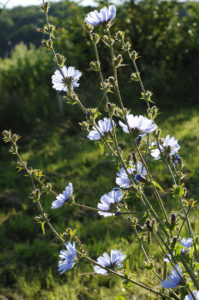

Inula is the old Latin name for this plant, derived from the Greek inaein (‘cleansing’), referring to its medicinal properties. In the 5th Century, it was called Inula campana, in medieval times Enula campana, which, by the English, was corrupted to elecampane. The specific name helenium, from the Greek helenion, was first mentioned by Greek scholar and botanist Theophrastos (c. 371 – c. 287 B.C.), called ‘the founder of botany’. Later a physician, Nikander (c. 147-? B.C.), linked the name with Helen of Troy. One legend has it that elecampane sprang from Helen’s tears, falling on the ground, when she was abducted by Prince Paris.
The popular names horseheal and horse elder were given in allusion to an old custom in Britain, where asthmatic horses were fed with the fleshy root of elecampane. The name scabwort refers to its former usage to treat scabies.
Elecampane has been used medicinally for at least 2000 years, first mentioned in Codex Constantinopolitanus in 512 A.D.
English herbalist Nicholas Culpeper (1616-1654) states: “The fresh roots of Elecampane preserved with sugar, or made into a syrup or conserve, are very effectual to warm a cold windy stomach, or the pricking therein, and stitches in the sides caused by the spleen; and to help the cough, shortness of breath, and wheezing in the lungs. The dried root made into powder, and mixed with sugar, and taken, serveth to the same purpose; and is also profitable for those who have their urine stopped, or the stopping of women’s courses, the pains of the mother, and of the stone in the reins, kidnies, or bladder (…) The root boiled well in vinegar, beaten afterwards, and made into an ointment with hog’s suet, or oil of trotters, is an excellent remedy for scabs or itch in young and old; the places also bathed or washed with the decoction, doth the same (…)”
Elecampane was also used for tuberculosis.
Even today, many herbalists consider this herb an effective remedy for lung problems, such as congested phlegm, bronchitis and emphysema (swollen alveoles). It has a beneficial effect on digestion. It is also used to expel intestinal worms and other parasites.
To the Celts of Britain, elecampane was a sacred plant.
In the 1500s, elecampane roots were sweetened and eaten as candy in England. Today, in France and Switzerland, an extract from the root is added as flavouring to absinthe, an alcoholic drink. It is widely cultivated as an ornamental.
The very similar Inula racemosa of Central Asia is widely used as an expectorant. It is described on the page Plants: Himalayan flora 1.
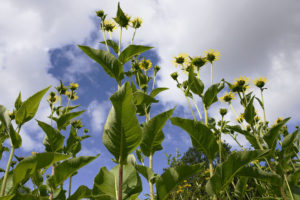
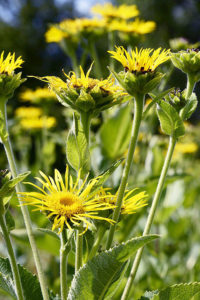
Today, flowerheads of German chamomile are collected and dried to be used as tea, which is a very efficient remedy for colds, sore throat, mouth ulcers, stomach ache, and colic. It is used for many other problems, such as allergies, diverticulitis (abdominal pain), fungal infections, insomnia, and heartburn, and also as a diuretic and a diaphoretic. Chamomile soothes inflammation, cramps, and menstrual pain. Externally, it is used for skin problems, including eczema, and for ulcers and burns, and a tincture is used to keep biting insects at bay.
In former days, chamomile was one of the commonest medicinal herbs, utilized for many diseases, such as bladder stones, flatulence, chest pain, tooth ache, bite of a mad dog, ‘heated brain’ (migraine?), bad nerves, etc.
The generic name is from the Latin matricis (’mother’s life’, i.e. the womb). Formerly another plant, feverfew (Tanacetum parthenium, see below), was regarded as a species of chamomile, named Matricaria parthenium by Swedish naturalist Carl Linnaeus (1707-1778). In Ancient Rome, feverfew was used for uterus problems. The specific name (and with that the English name) is derived from the Greek chamaimelon, meaning ‘earth-apple’, referring to the apple-like scent of German chamomile.
In Denmark, in the old days, a number of superstitions were connected with chamomile. When a woman passed a growth of chamomile, she had to make a curtsy twice. On Midsummer’s Eve, the girls would adorn their chamber with chamomile flowers, and on the island of Falster, it was placed among the plates on their rack. On Sunday morning, chamomile flowers were burned to spread fragrance in the living room. In the 1600s, on 24th of June, chamomile and burdock (Arctium lappa, see above) were placed several places in the house as protection against the poison, which in the evening would surge up from the earth.
Formerly, boys would smoke dried chamomille flowers as tobacco. If you rinsed your hair in chamomile water, it would get a sheen. Chamomile and wormwood (Artemisia absinthium, see above) were added to beer to make it keep. (The honour probably goes to wormwood, whereas chamomile might have added fragrance.)
Today, an essential oil, derived from the flowers, is utilized cosmetically.
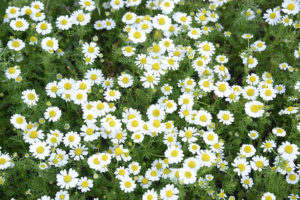
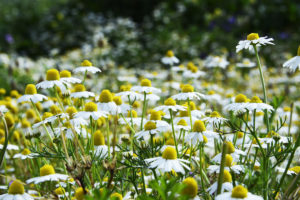
The generic name is derived from the Greek petasos, meaning ’broad-brimmed hat’, like the common name umbrella plant referring to the very large leaves, growing to one metre across. These leaves appear in two of Hans Christian Andersen’s fairy tales, The Ugly Duckling and The Happy Family. The name butterbur supposedly stems from the habit of using the large leaves to wrap butter in during hot weather, whereas another popular name, lagwort, refers to the late appearance of the leaves, which do not usually unfold, until the flowers have faded. ‘Dock’ is a term applied to various plants with large leaves, here used in the popular names flapperdock, blatterdock, and butterdock.
For more than 2000 years, butterbur has been used to treat a variety of ailments, including fever, cough, lung diseases, spasms, and pains. A former name of this plant was plague flower, as it was believed to be one of the few helpful remedies for the dreaded disease. In his book A niewe Herball, from 1578, English botanist and antiquary Henry Lyte (1529?-1607) calls it “a soveraigne medicine against the plague,” and English herbalist John Gerard (c. 1545-1612) writes: “The roots dried and beaten to powder and drunke in wine is a soveraigne medicine against the plague and pestilent fevers, because it provoketh sweat and driveth from the heart all venim and evill heate; it killeth worms. The powder of the roots cureth all naughty filthy ulcers, if it be strewed therein.”
Herbalist Nicholas Culpeper (1616-1654) says: “It is a great strengthener of the heart and cheerer of the vital spirits. (…) if the powder thereof be taken in wine, it also resisteth the force of any other poison. (…) The decoction of the root in wine is singularly good for those that wheeze much or are shortwinded. (…) The powder of the root taketh away all spots and blemishes of the skin.”
Butterbur was also regarded as anti-allergenic and anti-inflammatory. Fresh leaves were applied to burns. The juice, mixed with pigeon dung, was used against sunburn and freckles.
Today, butterbur extract is used to prevent migraine and to treat allergic rhinitis (inflammation of the inside of the nose).
In former times, the root was chewed, as it was thought to protect against ‘bad air’ (such as bad breath).
In his book The British Flora (1838), botanist William Jackson Hooker (1785-1865) writes: “The early flowering of this rank weed induces the Swedish farmers to plant it near their beehives.”
In England, the seeds have been used for love divination. They had to be sowed by a young, unmarried woman half an hour before sunrise on a Friday morning, in a lonesome place, and she must strew the seeds gradually on the grass, saying these words:
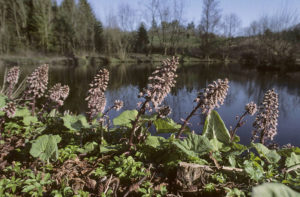
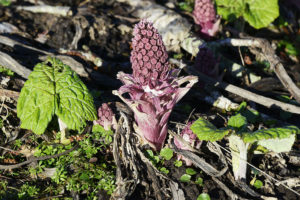
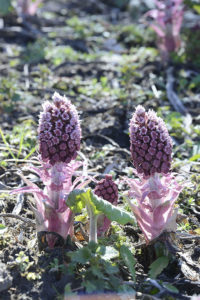

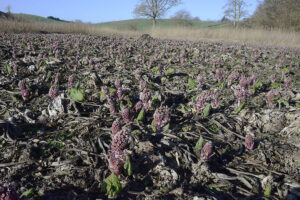
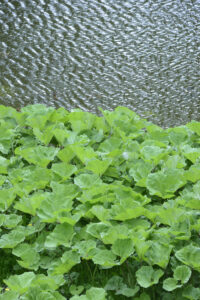
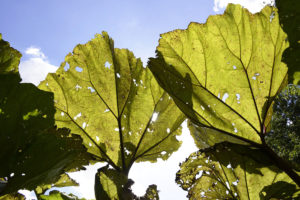
Greek physician, pharmacologist, and botanist Pedanius Dioscorides (died 90 A.D.), who was the author of De Materia Medica (five volumes dealing with herbal medicine), wrote that feverfew is anti-inflammatory. In Ancient Rome, it was used for uterus problems – and also for foetus expulsion! This usage was known to Swedish naturalist Carl Linnaeus (1707-1778), who named it Matricaria parthenium, as he regarded it as a species of chamomile.
Since the Middle Ages, this plant has been used for many ailments, including migraine headaches, fever, uterus problems, tooth ache, hysteria, nervousness, depression, dropsy, arthritis, constipation and other digestive disorders, and as a carminative.
Today, it is mostly used for migraine headache, but also for allergies and irregular menstruation. Taken with sugar or honey, it is supposedly good for coughs and difficulty of breathing.
Previously, feverfew was placed in the genus Pyrethrum, from the Greek pyr (’fire’), referring to its hot-tasting root. The common name feverfew is a corruption of the Latin febrifugia (‘fever-reducing’), and featherfew and featherfoil are further corruptions of feverfew.
In former days, feverfew was regarded as a magic plant. It was said that if the milk, cream, or butter had become bewitched, you should apply juice of the plant to the cow’s udder. If a girl, who was not a virgin, smelled the plant, she would have a strong urge to urinate. A pregnant woman, smelling the plant, would give birth to a red-haired child. It was also widely believed that if you planted feverfew around your home, it would purify the air and ward off disease.
This plant was also used to keep bees and other stinging insects at bay, and it was placed between clothes, not only for this purpose, but also to spread fragrance.
In Denmark, in the old days, it was used as a spice in soups, on omelettes, etc. It was also utilized for tanning.
Today, feverfew is widely cultivated as an ornamental.
Incidentally, a coffin in Faarevejle Church in Denmark, which reputedly contained the remains of James Hepburn, 4th Earl of Bothwell (c. 1534-1578), also contained feverfew flowers. Later, it was proved that the man in the coffin could not be the Earl of Bothwell.
Certain American indigenous tribes made a tea from leaves and top shoots of a near relative, tansy (Tanacetum vulgare), drinking it as a stimulant. A decoction of the same species was utilized as an emetic, to clean wounds, to regulate menstruation, to cure bloody diarrhea, and finally to promote sweating.
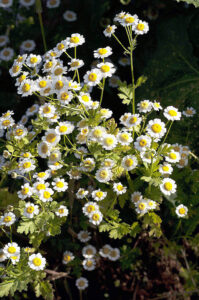
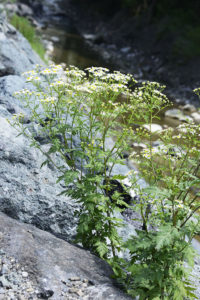
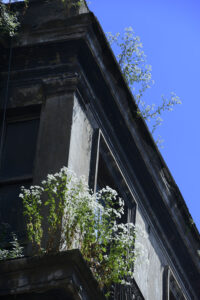

Originally, officinale was derived from officina (‘workshop’, or ‘office’), and the suffix alis, which, together with a noun, forms an adjective, thus ‘made in a workshop’. However, in a botanical context, the word denotes plants species that were sold in pharmacies due to their medicinal properties.
In today’s herbal medicine, the fresh leaves are used as a diuretic, for kidney and liver disorders, for dyspepsia, and as a mild laxative. Research indicates that dandelion may prevent osteoporosis and Alzheimer’s disease, and it is effective in treatment of bronchitis and pneumonia. A strong decoction is used for stone and gravel.
Among the Tamang people of Nepal, a decoction of the leaves is drunk to cure body ache. Elsewhere in Nepal, juice of the root is given for stomach disorders.
Among Kiowa tribals in the United States, a decoction of the flowers was taken by women with a cramped menstruation, whereas Tewa tribals would mix mashed leaves with water and tie this mixture around broken bones. From the root, a slightly purgative drink was made, which was also taken for cough and chest pains, and to increase milk production in women.
Apomictic reproduction is very common in dandelion, resulting in hundreds of micro-species. The obsolete specific name densleonis, as well as the common name lion’s tooth, refer to the serrated leaves of some micro-species. In French, densleonis became dent de lion, in English corrupted to dandelion.
The names monks-head and priest’s-crown were commonly used in the Middle Ages, an allusion to the naked flower disc, which resembles a monk’s or a Catholic priest’s shorn head. The names pee-a-bed and wet-a-bed (and the French name piss-en-lit) refer to its diuretic properties, while blowball refers to the popular game of blowing off the seeds.
Young leaves have a high content of vitamin C and are used in salads, and they may also be boiled as a vegetable or in soups. In Wales, the two-year-old root is chopped up and mixed with the leaves in salads. In Berkshire and Worcestershire, and in Scandinavia, wine is made from the flowers. The root is dried and pounded to make substitute coffee.
Girls often make garlands of the flowering stems, placing them around their hair, and a popular game among children as well as adults is to try blowing off the seeds of a flowerhead, all at once. Formerly, all kinds of divinations were connected with the ability to blow off the seeds.
A near relative, Mongolian dandelion (Taraxacum mongolicum), is utilized in Chinese herbal medicine for a number of ailments, such as tonsillitis, jaundice, urinary dysfunction, red and swollen eyes, and sores, especially breast and intestinal boils. It also promotes lactation.
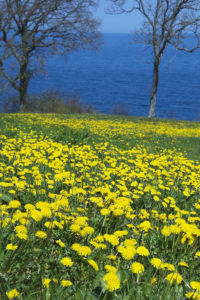
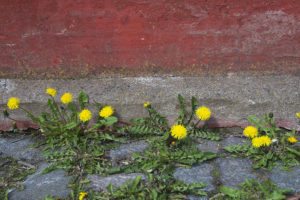

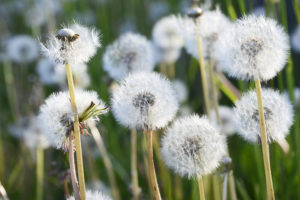
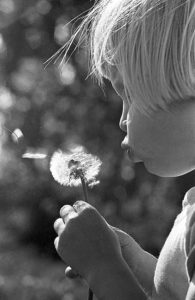
Greek physician, pharmacologist, and botanist Pedanius Dioscorides (died 90 A.D.), who was the author of De Materia Medica (five volumes dealing with herbal medicine), and Roman naturalist Pliny the Elder (23-79 A.D.) both recommend inhaling smoke from burning colt’s-foot leaves for cough. Pliny further recommends that the smoke is drawn into the mouth through a reed and swallowed, sipping a little wine between each inhalation. To derive the full benefit from it, it had to be burnt on cypress charcoal.
Still today, herbal tea, made from the dried leaves, is regarded as an excellent remedy against coughs, catarrh, wheeziness, asthma, and chronic bronchitis, but as the species contains poisonous alkaloids, it should not be taken during pregnancy and while breast-feeding. Today, however, certain cultivated varieties are non-toxic.
The generic name, from the Latin tussis (’to cough’), as well as the common name coughwort, refer to the usage of the leaves. The names colt’s-foot and horse-hoof were given in allusion to the shape of the leaves. An old name for the plant was Filius ante patrem (‘the son before the father’), referring to the fact that the flowers appear long before the leaves.
The leaves contain poisonous alkaloids, but non-toxic cultivated varieties have been developed. In England, an herbal sweet, called coltsfoot rock, contains colt’s-foot leaves. Hopefully, the non-toxic varieties are used in the production of this candy.
In former days, in Denmark, young leaves were eaten as a vegetable, and they were also mixed with tobacco. They were widely utilized for dyeing, in Jutland to dye black, on the Faroe Islands green. An old custom was to line your bed with the leaves to drive away fleas and lice.
In her poem The Song of the Colt’s-foot Fairy, English artist Cicely Mary Barker (1895-1973) praises this hardy plant:
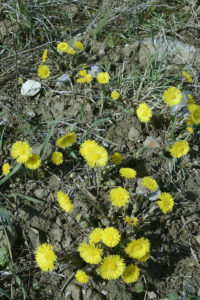
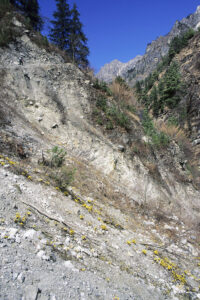
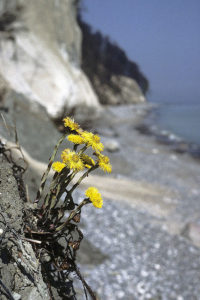
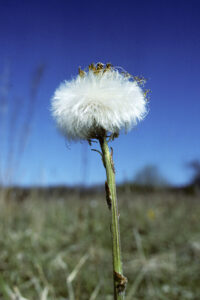
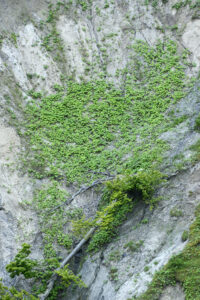
The leaves are edible, raw or cooked. In Nepal, leaf-stalks and stem are pickled, and the juice is applied to dyed clothes to make colours permanent. The Naga people of north-eastern India use the root stalk to make a red dye, by mixing its juice with crushed leaves of a species of balsam (Impatiens).
In Nepal, the plant juice is used for headache, and crushed leaves are applied to sore nipples. Juice of the root is applied to inflamed eyes, and also drunk to treat peptic ulcers. Among the Naga people, a paste of the leaves is applied to treat stomatitis and bristles on the tongue. The juice is used for diarrhoea and dysentery. In Nepal, the plant is fed to barren animals to help them conceive.
This species is described in depth on the page Plants: Himalayan flora 1.
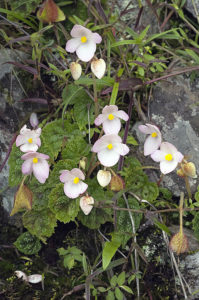
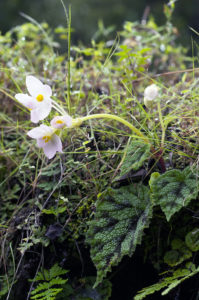
Barberry was cultivated for its berries, which contain 4-6 % of citric acid and lots of vitamin C. Their taste resembles that of lemons, and they were used as a substitute for this luxury item. However, it was soon noticed that where barberry grew, crops of rye, wheat, and barley would often fail. As it turned out, barberry is an alternative host for stem rust (Puccinia graminis), which attacks cereals, in humid and warm summers often causing huge losses.
In the early twentieth century, the United States government carried out an eradication campaign, which largely eliminated common barberry, and by the early 1980s, stem rust was not a big problem. In 1999, however, a more potent type of stem rust was discovered in Africa, so planting of barberry, which is a popular ornamental, is discouraged in the U.S.
In Ancient Egypt, the bark was used against infections – a usage which is still employed today. During the Middle Ages, it was used as a tonic, an antiseptic, and a laxative. Berries are astringent, and a drink, made from crushed fruits, is taken for sore throat. Among American natives, a decoction of the root was drunk in case of cough or stomach trouble, and a decoction of the bark was used to bathe wounds.
In former days, young leaves were eaten as salad, and jam was made from the berries. The bark yields a yellow dye.
Several other barberry species are described on the page Plants: Himalayan flora 1.
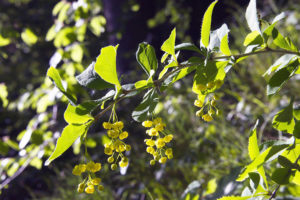
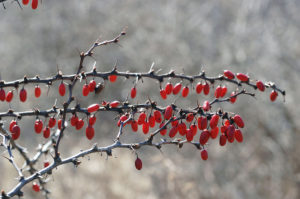

The English name may-apple refers to the early flowering of a related American species, Podophyllum peltatum. Formerly, they were regarded as belonging to the same genus, but Asian may-apple was moved to a separate genus in 1979, the only member of that genus.
The entire plant, especially root and fruit, is anti-inflammatory and purgative, and it promotes the discharge of bile. The root is also used for rheumatism. The plant contains the toxic podophyllin, which interferes with cell division, thus being able to prevent growth of cancer cells. It has been used with success in treatment of ovarian cancer. However, over-collecting has endangered the plant. It is now protected, but illegal collecting is still taking place.
Here and there, the species is cultivated as an ornamental. The fruit is edible when fully ripe, but toxic when unripe.

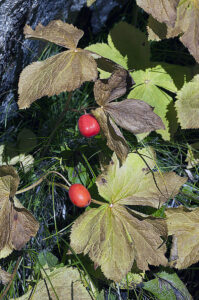
Silver birch and downy birch are both widespread and common in Europe, in the Caucasus, and eastwards across Siberia to the Pacific, silver birch also occurring in China and Japan.
In Norse religion, the birch represented Freya, the Great Mother Goddess, and among Celtic peoples the star goddess, Arianrhod, whose caer (‘throne’) was situated in the Corona Borealis (northern lights). She was invoked through the birch to assist in births and initiations.
Previously, the soft birch wood was carved into numerous items, including furniture, cups, bowls, bobbins, cradles, and toys. The bark separates into thin strips, which peels off easily. It is tough, water proof and rot proof, making it perfect as roofing material. It was also utilized to make buckets, baskets, bottles, plates, and shoes, and for writing and drawing. Due to its content of volatile oils, rolled-up bark could be used as torches.
In north-eastern North America, indigenous peoples made canoes from paper birch bark. They are lightweight and easy to manoevre, and when European fur traders came to the area, they adopted this means of transportation on the waterways. The bark was also widely used as tinder, as it may ignite even when fairly wet. Syrup can be made by boiling the sap.
The generic name is derived from Celtic betu (’glue’), referring to the fact that Celts extracted a glue-like substance from birch sap. In certain areas with Gaelic-speaking peoples, including Wales and Brittany, birch is still called bezuenn or bedwen.
The specific name pendula, meaning ’pendulous’ or ‘hanging’ in Latin, refers to the pendulous outer branches of silver birch, whereas pubescens is from the Latin pubes (’downy’), like the common name alluding to the downy twigs of downy birch.
The name birch is derived from Proto-Germanic berko, in all probability rooted in Sanskrit bhurja, the name of a species of birch.
Silver birch and downy birch are described in depth on the page Plants: Ancient and huge trees.

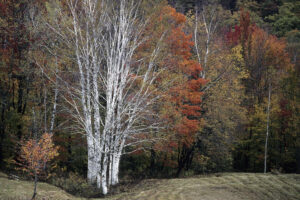
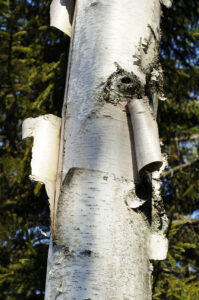
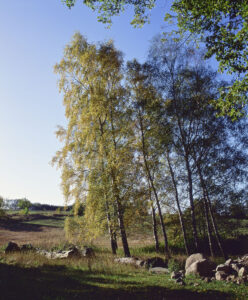
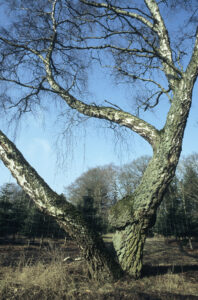
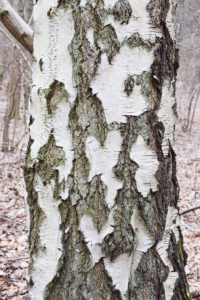
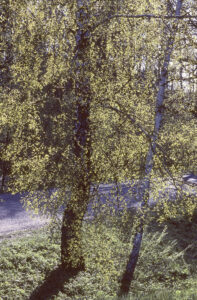
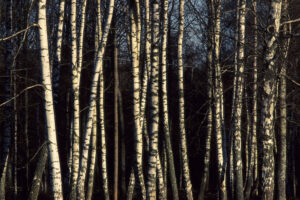
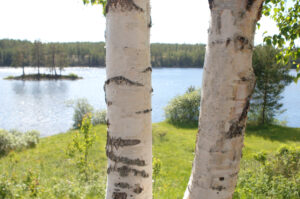
The generic name is possibly from the Latin borra, meaning ‘short wool’ or ‘rough hair’, alluding to the hairiness of this plant. An alternative possibility is that it is derived from the Arabic abū min al-araq, meaning ‘father of sweat’, which, like the specific name, refers to the medicinal properties of this species.
Originally, officinalis was derived from officina (‘workshop’, or ‘office’), and the suffix alis, which, together with a noun, forms an adjective, thus ‘made in a workshop’. However, in a botanical context, the word denotes plants species that were sold in pharmacies due to their medicinal properties.
The popular name herb of gladness is explained below (see John Gerard), whereas starflower refers to the shape of the flower.
The leaves, which have a cucumber-like smell and taste, are eaten as a vegetable, and also used in soups. In Liguria, northern Italy, borage is often an ingredient in ravioli. Leaves and flowers are excellent in salads. An essential oil is extracted from the seeds.
Greek physician, pharmacologist, and botanist Pedanius Dioscorides (died 90 A.D.), who was the author of De Materia Medica (five volumes dealing with herbal medicine), and Roman naturalist Pliny the Elder (23-79 A.D.) both claim that borage was the Nepenthe, mentioned in Homer, which would “cause forgetfulness”, when mixed with wine – i.e. acting as an anti-depressant.
In his Herball, English herbalist John Gerard (c. 1545-1612) writes: “Pliny calls it Euphrosinum, because it maketh a man merry and joyfull: which thing also the old verse concerning borage doth testifie: ‘Ego borago, gaudia semper ago.’ (’I, borage, bring alwaies courage.’) Those of our time do use the flowers in sallads to exhilerate and make the mind glad. There be also many things made of these used everywhere for the comfort of the heart, for the driving away of sorrow and increasing the joy of the minde. The leaves and floures of borage put into wine make men and women glad and merry and drive away all sadnesse, dulnesse and melancholy, as Dioscorides and Pliny affirme. Syrup made of the floures of borage comforteth the heart, purgeth melancholy and quieteth the phrenticke and lunaticke person. The leaves eaten raw ingender good bloud, especially in those that have been lately sicke.”
Another English herbalist, Francis Bacon (1561-1626), says that it ”hath an excellent spirit to repress the fuliginous vapour of dusky melancholie.” Herbalist John Parkinson (1567-1650) commends it “to expel pensiveness and melanchollie,” whereas herbalist Nicholas Culpeper (1616-1654) finds the plant useful for ”putrid and pestilential fever, the venom of serpents, jaundice, consumption, sore throat, and rheumatism.”
English gardener and vegetarian John Evelyn (1620-1706) writes: “Sprigs of borage are of known virtue to revive the hypochrondriac and cheer the hard student.”
Not long ago, borage was used for various disorders, including asthma, bronchitis, colic, cramps, diarrhoea, and also as a diuretic and blood-purifier. Today, it is used as an anti-inflammatory, whereas seed oil, when applied over several months, is a good remedy for various skin conditions, such as eczema. A decoction of the plant, rubbed on the hands, is utilized to treat Raynaud’s disease (‘white fingers’).
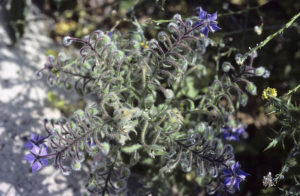
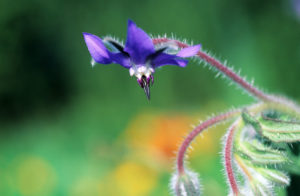
The generic name is from the Greek echis, meaning ‘viper’, referring to the shape of the flower, with the long, red stamens sticking out like a viper’s tongue. The name bugloss is from the Greek, meaning ‘ox tongue’, referring to the rough surface of the leaves. In Swedish, the name of this species is blåeld, meaning ‘blue fire’, alluding to the wonderful blue colour of the flowers, which, when many plants grow together, does resemble ‘blue fire’ (see picture on top of this page).
Formerly, it was believed that this species could be used as a cure for snake bite. British herbalist Nicholas Culpeper (1616-1654) says about this: “It is a most gallant herb of the sun; it is a pity it is no more in use than it is. It is an especial remedy against the biting of the viper, and all other venomous beasts, or serpents; as also against poison, or poisonous herbs. Dioscorides and others say that whosoever shall take of the herb or root before they be bitten, they shall not be hurt by the poison of any serpent.” (Pedanius Dioscorides (died 90 A.D.), was a Greek physician, pharmacologist, and botanist, author of De Materia Medica, five volumes dealing with herbal medicine.)
Among American indigenous peoples, a decoction of the plant was taken in case of ’white urine’, indicating too much calcium in the urine.
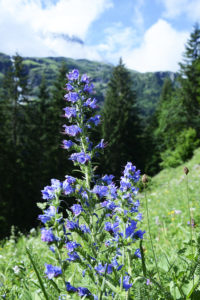
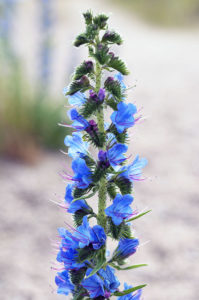
At least two legends explain the origin of the name forget-me-not. A French knight was walking along a river with his lady, when he noticed some beautiful blue flowers, growing at the waterside. When he bent down to pick them, his heavy armor caused him to lose his balance, and he fell into the water, where the armour dragged him below the surface. Before disappearing, he managed to toss the flowers to his lady, shouting “Ne m’oubliez pas!” This became the name of the flower, and it was translated into several other languages, including forget-me-not in English, Vergissmeinnicht in German, no-me-olvides in Spanish, gleym mér ei in Icelandic, etc.
The other legend says that God had assembled all the flowers in order to give each one a name. When God thought that he had finished his task, he turned to leave, but a small plant cried out: “Forget me not, O Lord!” – “That shall be your name,” he decided.
Over time, forget-me-not became a symbol of fidelity and being truthful to someone you love, and they also came to represent long lasting connections between friends. In his poem Forget-me-not, English poet John Clare (1793-1864) says:
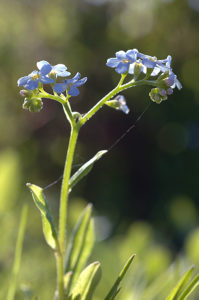
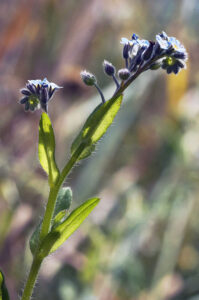
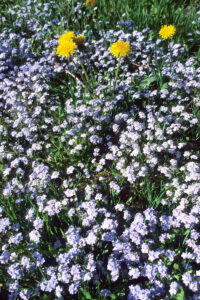
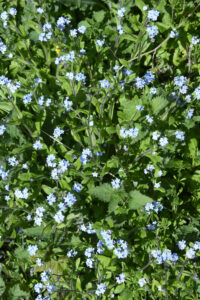
The healing properties of comfrey have been known for hundreds of years. English herbalist John Gerard (c. 1545-1612) writes: “A salve, concocted from the fresh herb, will certainly tend to promote the healing of bruised and broken parts.” Another herbalist, Nicholas Culpeper (1616-1654), says: “Comfrey restrains spitting of blood. The root boiled in water or wine and the decoction drank, heals inward hurts, bruises, wounds and ulcers of the lungs, and causes the phlegm that oppresses him to be casily spit forth…. A syrup made there of is very effectual in (…) outward wounds or sores in the fleshy or sinewy parts of the body, and to abate the fits of agues [malaria] and to allay the sharpness of humours. A decoction of the leaves is good for those purposes, but not so effectual as the roots. The roots being outwardly applied cure fresh wounds or cuts immediately, being bruised and laid thereto; and is specially good for ruptures and broken bones, so powerful to consolidate and knit together that if they be boiled with dissevered pieces of flesh in a pot, it will join them together again.”
The generic name is from the Greek symphyo (’to make grow together’) and phyton (’plant’), like its common names comfrey (from the French conserve), boneset, knitbone, knitback, and bruisewort, referring to its bone- and bruise-healing properties.
Originally, officinale was derived from officina (‘workshop’, or ‘office’), and the suffix alis, which, together with a noun, forms an adjective, thus ‘made in a workshop’. However, in a botanical context, the word denotes plants species that were sold in pharmacies due to their medicinal properties.
The folk name ass ear was given in allusion to the rough leaves.
Today, an ointment of comfrey root is used as a very effective remedy for bruises, sprains, and minor fractions, stimulating tissue repair. It is also used for haemorrhoids, varicose veins and ulcers, and for heartburn and dandruff. In some parts of Ireland, comfrey is eaten as a cure for defective circulation and poverty of blood.
In England, comfrey roots, together with chichory and dandelion roots, were formerly used to make substitute coffee.
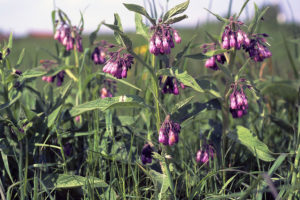
The name shepherd’s purse, as well as many of its folk names, including lady’s purse, witches’ pouches, rattle pouches, case-weed and mother’s heart, and also the specific name bursa-pastoris (‘purse of shepherd’), refer to the shape of the fruits, or siliques, which are flat and triangular, resembling an old-fashioned bag or purse.
An Irish name of the species, clappedepouch, also refers to the siliques, which are long-stalked. This name was given in allusion to the way lepers were begging in the old days. They would ring a bell, or a clapper, receiving their alms in a cup at the end of a long pole, to avoid people being infected.
English herbalist Nicholas Culpeper (1616-1654) says that shepherd’s purse helps bleeding from wounds, both inward or outward, and continues: “If bound to the wrists, or the soles of the feet, it helps the jaundice. The herb made into poultices, helps inflammation and St. Anthony’s fire. The juice dropped into ears, heals the pains, noise and matterings thereof. A good ointment may be made of it for all wounds, especially wounds in the head.”
Today, St. Anthony’s fire is called ergotism, a very painful burning sensation in the limbs, caused by alkaloids from the ergot fungus (Claviceps purpurea), which grows on cereal ears, especially rye and barley. In the Middle Ages, this disease often caused gangrene in the limbs, besides brain damage.
American indigenous people drank an extract of shepherd’s purse to cure dysentery and diarrhoea. In Europe, a decoction of fresh plants was also employed for chronic diarrhoea, and dysentery, blood in the urine, haemorrhoids, and to stop nose-bleeding. During World War II, the Germans used an extract of Capsella to stop bleeding on soldiers.
Dried shepherd’s purse yields a tea which herbalists use for stopping internal bleeding of stomach, lungs, uterus, and kidneys. Its diuretic properties cause it to be much used in kidney disorders and dropsy. Externally, it can treat skin problems. It is also used for rheumatism.
A decoction of fresh shepherd’s purse has been employed for blood in the urine, haemorrhoids, chronic diarrhoea, and dysentery, and to stop nose-bleeding. It is also used for rheumatism. During World War II, the Germans used an extract of Capsella to stop bleeding on soldiers. Dried, it yields a tea which herbalists use for stopping internal bleeding of stomach, lungs, uterus, and kidneys. Its diuretic properties cause it to be much used in kidney disorders and dropsy. Externally, it can treat skin problems.
In former days, in Denmark, tender parts were eaten as a vegetable – which is still the case in Nepal. In the Himalaya, the seeds are employed to kill mosquito larvae. In the West, however, the seeds are considered a valuable food for cage birds!

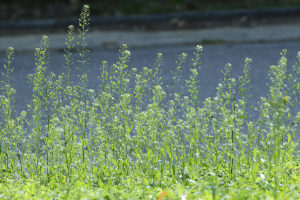
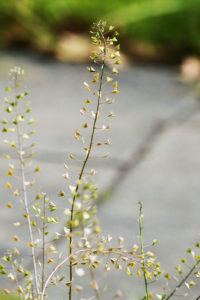
Since ancient times, woad was cultivated throughout Europe as an important source of a blue dye, reflected in its specific name, which is Latin, meaning ‘used in dyeing’, derived from tingo (‘soak in dye’). Caesar relates that the people of Brittain used the dye as war paint. When extracting the dye from the plant, it has to ferment for about a week in urine, producing a horrible stench.
In the 1800s, woad was eventually replaced by the more colourfast indigo, and in the early 1900s, both woad and indigo were replaced by aniline.
Woad was also used as a medicinal herb for a number of ailments, including wounds, ulcers, snakebites, haemorrhoids, and inflammation.
The common name is derived from Proto-Indo-European woyd, of unknown meaning.
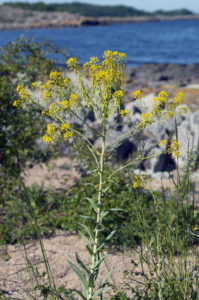
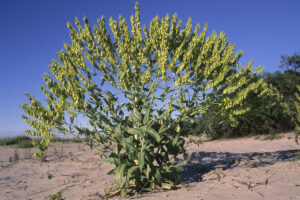
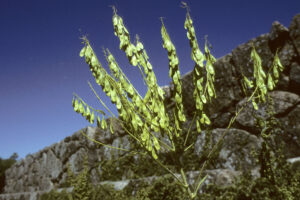
This species, and its near relative, narrow-fruited watercress (N. microphyllum), are very rich in vitamin C and were formerly much utilized to prevent outbreaks of the feared disease scurvy (see Citrus, Rutaceae). They were also used for tuberculosis, paralysis, epilepsy, and constipation.
Greek physician Hippocrates of Kos (c. 460-370 B.C.) considered watercress a digestive stimulant, and also prescribed it for cough. English herbalist Nicholas Culpeper (1616-1654) states that a lotion, made from bruised leaves or juice will free the face from blotches, spots, and blemishes. In Denmark, in the 1600s, fresh leaves were added to wine, and this decoction was utilized to rinse the teeth, ”removing filthiness, and resetting loose teeth.” Leaves, boiled in wine, were taken for painful urination.
In modern herbal medicine, Nasturtium species are regarded as important antioxidants, lowering the risk of cancer. They act as a diuretic, and also benefit the liver function. They are also used for colds, bronchitis, catarrh, gingivitis, and shingles. Taken in large quantities, watercress acts as a purgative.
Seeds may be ground and used as mustard.
Originally, officinale was derived from officina (‘workshop’, or ‘office’), and the suffix alis, which, together with a noun, forms an adjective, thus ‘made in a workshop’. However, in a botanical context, the word denotes plants species that were sold in pharmacies due to their medicinal properties.
The name scurvy-grass refers to its usage as a remedy to prevent scurvy.
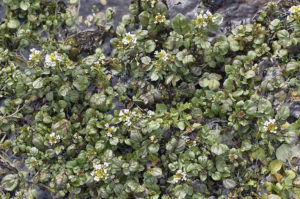
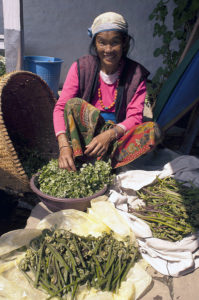
In his book Acetaria: A Discourse of Sallets, English gardener and vegetarian John Evelyn (1620-1706) writes: ”When in the leaf, mustard, especially in young seedling plants, is of incomparable effect to quicken and revive the spirits, strengthening the memory, expelling heaviness, (…) besides being an approved antiscorbutic.”
Today, white mustard is regarded as an emetic and a diuretic. It is also used for treatment of arthritis, rheumatism, and sciatica, for hypothyroidism, and for Raynaud’s disease (‘white fingers’). A paste of the seeds is applied to the skin to increase blood circulation.
Another species of mustard, the leaf mustard (Brassica juncea), is presented on the page In praise of the colour yellow.
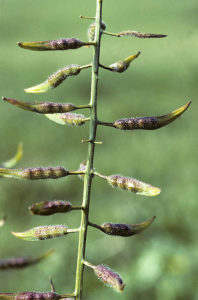

It is distributed from central Europe eastwards to European Russia, southwards to northern Africa, Jordan, and Iran, growing in a wide variety of habitats, including forests, fields, dry meadows, waste places, and along roads, from sea level up to elevations around 2,000 m.
It was once widely cultivated in Europe for its leaves, which were cooked like spinach, and its parsnip-like root, which was used like a radish.
The specific name is a diminutive of rapa, the Latin word for turnip, thus ‘little turnip’, referring to the shape of the root.
The fairy tale Rapunzel, published by the Grimm Brothers in 1812, took its name from this plant. This tale can be traced back to an Italian tale from 1634, Petrosinella, by Giambattista Basile.
A couple live next to a large vegetable garden, which belongs to a sorceress. When the wife gets pregnant, she notices a vegetable, called rapunzel, in the garden and starts craving for it. She refuses to eat anything else, so her husband climbs the wall around the garden to get some for her. However, during his next visit to the garden, he is caught by the sorceress. She agrees to let him take all the rapunzel he wants, but on the condition that the newborn baby is given to her. Desperate, he agrees.
The sorceress names the newborn girl Rapunzel after the plant that her mother craved. The girl grows up to be a beautiful child with long golden hair, and the sorceress locks her up inside a tower with no door and no stairs, and only one room with one window. When she visits Rapunzel, the sorceress stands beneath the tower, calling out: “Rapunzel, Rapunzel, let down your hair!” – whereupon she climbs up her long, braided hair.
One day, a prince, who is riding in the forest, hears Rapunzel singing from the tower. As he approaches, he hears the sorceress calling Rapunzel to let down her hair. When the sorceress has left, he calls the same words, and climbs up her hair. Naturally, the two fall in love, and after many adventures they live happily ever after.
At some time, in German, the name Rapunzel was transferred to members of another genus in the bellflower family, the rampions (Phyteuma). Why this was done, is not clear. Members of this genus are described on the page Plants: Plants in the Alps and the Pyrenees.


Hemp is sacred to many Hindus, who usually call it bhang. During festivals, it is utilized by saddhus (holy ascetics) to enter a different mental level, thus getting in contact with the gods. It is also worshipped by the Rai people of eastern Nepal.
Three intoxicants are obtained from this plant. Bhang is made from soaking the leaves in water and then drinking it. The effect is relatively mild. Bhang is also mixed with sweets or desserts. Ganja, in the West called marihuana, pot, or grass, is more potent, consisting of dried flowers and upper leaves, which are smoked. The most potent drug, charas, in the West called hashish, is made from resin, exuded by the flowers. This resin is mixed with tobacco and smoked.
A Hindu legend has it that the god Shiva, after quarrelling with his family members, went off by himself. He found shelter from the sweltering heat in the cool shade of a tall plant, unknown to him. Curious about this plant, he ate some of its leaves and felt so refreshed that he adopted it as his favourite food – hence one of his titles, ‘Lord of Bhang’. He brought the plant down from the Himalaya and presented it as a gift to mankind. In India, it is said: “Bhang is the Joygiver, the Skyflier, the Heavenly Guide, the Poor Man’s Heaven, the Soother of Grief.”
According to another Hindu legend, The Churning of the Milk Ocean, from the Bhagavata-Purana, the gods had become weakened and had been usurped by the asuras (demons). The gods appealed to the supreme god Vishnu for help, and he suggested that they should regain their power by drinking the miraculous amrita, the nectar of immortality, which they could obtain by churning the cosmic milk ocean, thus bringing the jar with amrita to the surface. However, Vishnu advised the other gods to treat the asuras diplomatically by suggesting them to jointly churn the ocean. When the amrita was brought to the surface, Vishnu would ensure that the gods got hold of it. To perform this stupendous task, the gods and the asuras uprooted the mountain Mandara, placing it upside down in the ocean, and coiling the giant, many-headed naga (serpent) Vasuki around it. By pulling alternately at each end of Vasuki, the mountain would act as a gigantic churn, thus bringing the pot, containing the amrita, to the surface. The churning also brought other substances to the surface, one of these being bhang.
Stem fibres of hemp have been utilized for more than 10,000 years, as rope, textiles, and paper, and today also as biodegradable plastic, insulation, and biofuel. The seed oil is used for cooking, lamps, lacquers, and paint. In India and Nepal, hemp leaves are used in salads, and its seeds are roasted and pickled. In the West, the plant is cultivated for its fibres and is widely planted as game fodder.
Hemp has been utilized in traditional Asian medicine for thousands of years, mainly as a sedative, analgesic, and anti-inflammatory, and to reduce nausea and vomiting. In Nepal, juice of the leaves is used for diarrhoea and dysentery, and a paste of the leaves is applied to wounds. Powdered seeds can expel intestinal worms. The Naga people of north-eastern India drink a decoction of the plant for stomach pain and malaria.
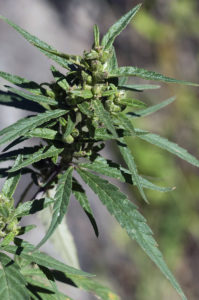

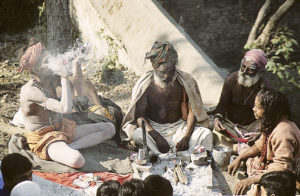
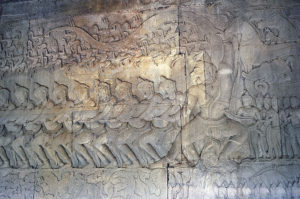
As early as the 9th Century, in Europe, hop was added to beer to make it keep better; only later was it used as flavouring and to make the beer stronger. For another 800 years, however, the English opposed hop as an additive to beer, calling it “a wicked weed that would spoil the taste of the drink and endanger the people.” Elsewhere in Europe, it was praised for its taste and effect.
Formerly, hop sprouts were eaten as a salad and in soups, and young buds were utilized as a spice in sauces. In times of war, the leaves were smoked as tobacco. They were also chopped to make animal feed, and sheep were fed with dried leaves in winter. Rope was made from the fibres, and on the island of Funen, Denmark, the stems were wound around each other to make strong ropes, which were used to fasten laths to rafters and also to tie straw bundles to the rafters. Door mats were also produced from the stems. Dried, they constituted an excellent fuel.
The bitter resins of the inflorescence have a soothing effect on the nervous system, and are thus taken for stress, anxiety, insomnia, and nervous indigestion, and also as a sedative. Hop juice will clean the blood and is a very effective remedy for calculus problems. Traditionally, hop flowers have been used for leprosy, tuberculosis, and dysentery. Tea, made from the flowers was taken for cramps, swellings, and hardness of the uterus.
Among American tribals, hop tea was taken as a stimulant, and the vapours were inhaled to cure insomnia.
The specific name is a diminutive of the Latin lupus (wolf), referring to the strong growth of hop, which ’attacks’ and overgrows other plants. In June, when the growth is at its peak, the stem may grow up to 17 cm a day. On the island of Funen, Denmark, an old saying was that you were able to see this fast growth. The English name is from the Anglo-Saxon word hoppan (’to climb’).
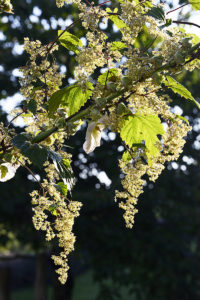
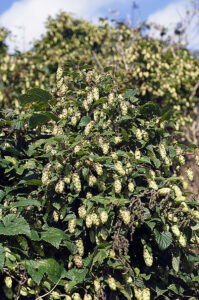
In traditional Indian medicine, this species is used for fever, blood and liver ailments, eye diseases, hysteria, hypochondria, and nervous disorder. A paste of the root is applied to wounds, and also to the forehead to relieve headache. In Nepal, a paste of the plant is applied to boils. The root is used for hysteria, insomnia, rheumatism, cholera, nausea, and pimples. It is threatened due to excessive collecting.
The root and rhizome contain an essential oil, used as incense.
In the West, a related species, Valeriana officinalis, is used for treating various ailments, including heart trouble, high blood pressure, insomnia, anxiety, and hives.
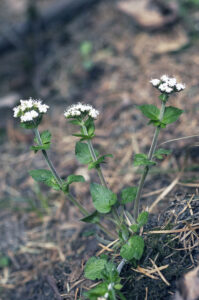
The common and specific names of one member of the genus, the clove pink (Dianthus caryophyllus), stem from the clove-like fragrance of this plant. The Ancient Greek name of the clove-tree was karyophyllon, derived from karyon (‘nut’) and phyllon (‘leaf’), which was adopted by early botanists in the form Caryophyllus aromatica (today changed to Syzygium aromaticum). The family name was linked to this species of pink by French botanist Antoine Laurent de Jussieu (1748-1836), known as the first person to publish a natural classification of flowering plants.
In his delightful book All about Weeds (which was published before usage of chemical sprays became common), American botanist Edwin Spencer (1881-1964) says: “It is pretty enough, but it has a notorious reputation. Its seeds ripen simultaneously with winter wheat, and since they are about the same size and weight of wheat grains, their removal from wheat seed is very difficult. The weed is a winter annual, just as winter wheat is, and for this reason it is sure to be sown with the wheat, if it is threshed with it. Farmers who want to rid their fields of corn cockle, should take the only sure way of doing it: examine every inch of the fields containing the pest before the wheat is ready to harvest, and remove every corn cockle stalk found, roots and all. In most fields, the plant is very easily pulled up.
(…)
Corn cockle is not worth much. It finds its place in the herbals as a medicinal plant, but the very same seeds that make it medicinal, vex the wheat grower and poison his stock. The medicine made from the seeds by trituration is said to be useful in treating paralysis and gastritis, two very dissimilar diseases, but the herbals declare such to be the case.”
In his book The British Herbal (1756), British botanist John Hill (1714-1775) declares that corn cockle was considered a cure for dropsy and jaundice.
However, the seeds contain an irritant poison, and today they are no longer used medicinally.
The generic name is derived from Ancient Greek agros (‘field’) and stemma (‘garland’), alluding to one of the habitats of this plant, and to its pretty flowers. The specific name is said to be derived from the old English word gith, which was used for a plant with aromatic, black seeds, and the Latin suffix –ago (‘resembling’). The name was commonly used for corn cockle for at least a hundred years, before Swedish naturalist Carl Linnaeus (1707-1778) applied the name in 1753. The origin of the word cockle is obscure.
Nowadays, corn cockle is very rare in Europe, and I have never seen it in the wild. I once thought I had found it in Turkey, but, as it turned out, the plant was a close relative, the short-lobed corn cockle (A. brachyloba) (see pictures below).
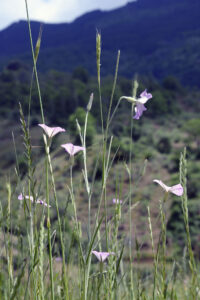
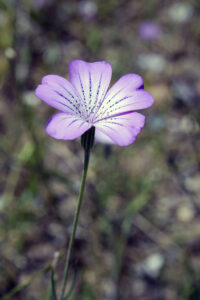
The generic name is derived from the Latin sapo, meaning soap, which, like two of its common names, soapwort and latherwort, refers to the usage of this plant as lather. In the Middle Ages, the soapy liquid was utilized in wool mills to degrease and thicken woolen cloth, a process known as ‘fulling’, hence the popular name fuller’s herb.
Originally, officinalis was derived from officina (‘workshop’, or ‘office’), and the suffix alis, which, together with a noun, forms an adjective, thus ‘made in a workshop’. However, in a botanical context, the word denotes plants species that were sold in pharmacies due to their medicinal properties.
Popular names like Sweet Betty, wild Sweet William, hedge pink, Boston pink, and lady-at-the-gate all refer to the pretty flowers.
In her book Nature’s Garden, published in 1900, American historian and writer Neltje Blanchan de Graff Doubleday (1865-1918) writes about the occurrence of soapwort (or ‘bouncing bet’, as she calls it) in North America: “A stout, buxom, exhuberantly healthy lassie among flowers is bouncing bet, who long ago escaped from gardens, whither she was brought from Europe, and ran wild beyond colonial farms to roadsides, along which she has travelled over nearly our entire area.” In parts of the United States, it is considered a pest, which outcompetes native vegetation.
Formerly, soapwort was widely used in folk medicine, as a tonic, a diaphoretic, and a laxative, for rheumatism, and for jaundice and other visceral problems. A decoction was applied to itchy skin, and to induce sneezing. It was also used for venereal diseases, when mercury had failed. Around 1900, on the island of Lolland, Denmark, a decoction of soapwort root was utilized to treat burns. Among American natives, a poultice containing soapwort was applied over a painful spleen.
Today, it is used for respiratory problems, such as bronchitis and laryngitis.
In his excellent book The Green Pharmacy, American botanist and herbalist James A. Duke (1929-2017) recommends the juice of soapwort as the best remedy, if you have been into contact with certain plants, which contain the toxic urushiol, including Toxicodendron species such as poison oak, poison ivy, and poison sumac, and also in parts of the mango tree (Mangifera indica). Simply smear the soapwort juice over the affected area. – Pictures of poison ivy and poison oak are shown on the page Nature: Autumn.
Despite being slightly toxic, the species is used as a culinary ingredient in preparing tahini, and in the Middle East, the root is used as an additive when making a popular sweet, halva. Added when brewing beer, it creates plenty of foam, the so-called ‘beer head’.
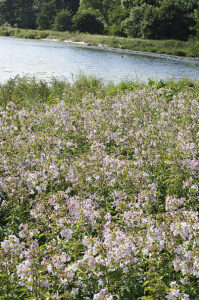
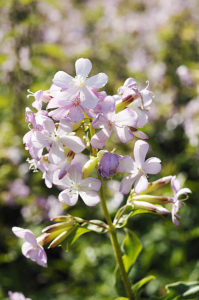
It is very widespread, native from Iceland eastwards to eastern Siberia, southwards to Ethiopia, India, and China, but has become naturalized almost worldwide, especially in North America, growing in open areas like fields and along trails, and it is a notorious weed of lawns and vegetable gardens. It is widely consumed as a healthy vegetable, and poultry are very fond of it, giving rise to the name chickweed.
In his delightful book All about Weeds, American botanist Edwin Spencer (1881-1964) says: “One of the meanest of the lawn weeds is that little, crawling member of the pink family known as chickweed. Filled with a vitality even superior to that of bluegrass [meadow-grass, Poa], it is on the job as soon as the frost is out of the ground, and long before the grass is ready to cut, this pest is in full bloom and spreading itself.”
According to English herbalist John Gerard (c. 1545-1612), “the leaves of chickweed boyled in water very soft, adding thereto some hog’s grease, the powder of fenugreeke and linseed, and a few roots of marsh mallows, and stamped to the forme of cataplasme or pultesse, taketh away the swelling of the legs or any other part (…) in a word it comforteth, digesteth, defendeth and suppurateth very notably.”
English herbalist Nicholas Culpeper (1616-1654) says: “The herb bruised, or the juice applied, with cloths or sponges dipped therein to the region of the liver, and as they dry to have fresh applied, doth wonderfully temper the heat of the liver and is effectual for all impostumes and swellings whatsoever; for all redness in the face, wheals, pushes, itch or scabs, the juice being either simply used, or boiled in hog’s grease; the juice or distilled water is of good use for all heat and redness in the eyes (…) as also into the ears. (…) It helpeth the sinews when they are shrunk by cramps or otherwise, and extends and makes them pliable again, by using the following methods, viz.: Boil a handful of chickweed and a handful of dried red-rose leaves, but not distilled, in a quart of muscadine, until a fourth part be consumed; then put to them a pint of oil of trotters, or sheep’s feet, let them boil a good while, still stirring them well, which being strained, anoint the grieved part therewith warm against the fire, rubbing it well with your hand, and bind also some of the herb, if you choose, to the place, and with God’s blessing it will help in three times dressing.”
In former days, it was also believed that chickweed water was a remedy for obesity.
The generic name is derived from the Latin stella (‘star’), alluding to the shape of the flowers of some species. The specific name means ‘of medium size’ – a strange name for this plant, which is among the smallest members of the genus.
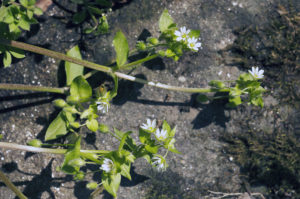
An essential oil, named Taiwan Hinoki, is obtained from its twigs and wood. This oil is valued for its ability to kill harmful bacteria, viruses, and fungus. It is also excellent for respiratory problems, blocked sinuses, high blood pressure, and skin diseases. Research indicates that its fragrance can effectively release tension and stress.
The wood is excellent for construction and furniture. The species is protected by law and may only be harvested with special permission, but in recent years there has been several cases of trees being cut illegally.
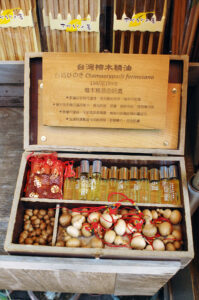
There are various theories as to the origin of the generic name. Some authorities claim that it stems from the Latin iungere (’tie together’ or ’weave’), referring to the use of its branches in baskets and fences, whereas others maintain that it is derived from juvenis (’young’) and parere (’to produce’), referring to the fact that juniper bushes constantly are renewed by new shoots. The words gin and genever are also derived from Juniperus. The specific name communis is Latin, meaning ‘common’.
Traditionally, a decoction of the berries was used as an antiseptic, and oil from the cones is still today used externally for arthritis and rheumatism. Galls on the needles, caused by larvae of a species of gall gnat, Oligotrophus juniperinus, were taken for whooping cough.
Formerly, certain Native American tribes used the fruits as a contraceptive. Others drank a decoction made from tips of young branches as a blood cleanser, and the seeds were eaten to cure lumbago.
Research has shown that certain substances in the berries are an effective diuretic and analgesic, they can lower the blood pressure, and they are an efficient remedy for gout and digestive disorders. Inhalation of steam from boiling berries relieves catarrh and congestion.
In the old days, in Denmark, fresh branches were strewn on the church floor during funerals, and a juniper bush planted near the door would keep witches and ogres at bay. The branches were utilized for basket weaving, and thicker stems were used as almost imperishable staves in fences. From the tough wood, buttons, kitchen utensils and other items were carved, and an American species of juniper is still used for pencils.
Previously, on Easter Monday, Kashubian boys of northern Poland would chase the girls, whipping their legs gently with juniper twigs. Supposedly, this would make the girls interested in the boys.
When burning wood and foliage, an aromatic smoke is produced, in former times used for smoking various foods. Still today, Buddhist peoples of the Himalaya and Tibet burn fresh juniper branches as incense in temples.
The cones are an ingredient in the production of gin and genever, adding the characteristic smell and taste to these drinks. They are also excellent in cooking, e.g. in meat courses and marinades. They emit an aromatic fragrance, containing up to 40% glucose and 2% essential oil.
Other species in this genus are presented on the pages Plants: Himalayan flora 1, and Plants: Ancient and huge trees.
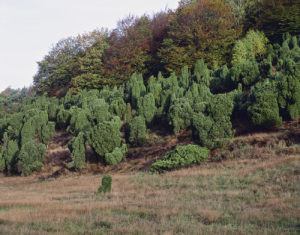

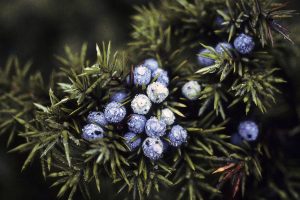
The tuber is edible after boiling. The fresh tuber is used as fish poison. It is squeezed and mixed with water to wash clothes, and this soap is also used as a body wash to kill lice.
In Nepal, juice of the tuber is used for constipation, and to expel roundworms. Bulbs from the upper part of the stem are boiled and the liquid drunk for gastric problems. Juice of the bulbs are used for dysentery. Elsewhere, the tuber is used for various diseases, including asthma and arthritis, and also as a contraceptive.
In America, a related species, D. villosa, is used for diverticulitis, i.e. abdominal cramps and inflammation, and also for postmenopausal vaginal dryness.
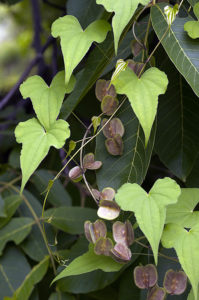
Persian joint-pine is distributed in the Middle East and Central Asia. Excavations in the Karakum Desert in Turkmenistan suggest that it may have been a component of the Zoroastrian ritual drink haoma, which is identical to the Vedic drink soma. Drinking haoma ‘gives insight’ and makes you ‘wise’.
As Ayurvedic medicine, tea from Gerard’s joint-pine is drunk for colds, cough, bronchitis, asthma, and arthritis. In Nepal, the crushed plant, mixed with water, is used for skin problems. Juice of the plant is said to stimulate the heart. It is used for respiratory infections, asthma, and hay fever, and is also given to children to control bedwetting.
In traditional Chinese medicine, Persian joint-pine – and also E. sinica and E. equisetina – are called 麻黄 (ma huang), meaning ’yellow hemp’. Their leaves are used for treatment of a large number of ailments, including fever, cardiovascular problems, nervous disorder, pulmonary diseases, and diarrhoea. They also have anti-viral properties. The root is used to reduce sweating due to weakness of the body. In Tibet, Persian joint-pine is used for liver diseases.
Joint-pine stems are used for fodder, and dry plants are collected for fuel. Goats are fond of eating the green stems.
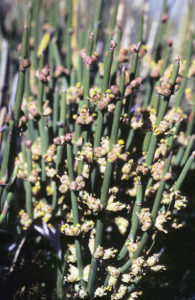

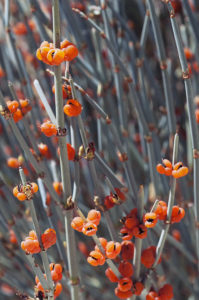
King Juba II (c. 50 B.C. – 19 A.D.) of Numidia (in present-day Algeria and Tunisia) had an interest in plants and often described them, including a thorny, succulent plant from the Atlas Mountains in Morocco, whose latex was a powerful laxative. He named this plant Euphorbea after his Greek chief physician, Euphorbus. In 1753, Swedish naturalist Carl Linnaeus (1707-1778) adopted this name, in the form Euphorbia, for the entire genus.
The specific name royleana was given in honour of British botanist John Forbes Royle (1798-1858), who is chiefly known for his work Illustrations of the Botany and other branches of Natural History of the Himalayan Mountains, and of the Flora of Cashmere (1839ff).
In Nepal, the boiled pith is used for stomach and gastric problems, and a paste of the leaves is applied to wounds. Juice of the leaves is used for fever, and also dripped into the ears to remove pus. The latex is applied to boils and pimples, and also used for sprains, cough, and asthma, and to expel intestinal worms. It is applied to fungi between the toes, caused by walking barefoot in water during the rainy season. In Ayurvedic medicine, it is used to treat leukaemia.
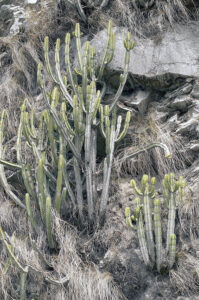
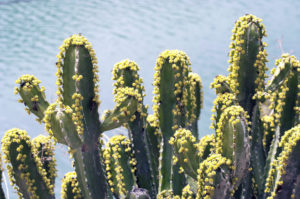
The generic name is Latin for ‘tick’, referring to the seed, which resembles certain species of ticks. The specific name means ‘common’. The name castor oil plant was given in allusion to the former usage of the seed oil as a powerful laxative, whereas another popular name, Palm of Christ, refers to the similarity between Christ and this plant: As the belief in Christ can help psychological problems, Ricinus oil is able to cure a variety of physical ailments.
Research has shown that this species possesses anti-inflammatory, analgesic, antipyretic, anti-asthmatic, and antihistamine properties. In Nepal, the plant is utilized for numerous ailments. Juice of the root is used for skin problems, diarrhoea and dysentery, and as a purgative. Powder from the dried root is used for jaundice and nervous disorders. A paste of the bark is applied to cuts and wounds. A poultice of the leaves is applied to treat boils and rheumatism, and also to the forehead to relieve fever and headache. A paste of the flowers is applied to infected wounds. Oil from the seeds is used for haemorrhoids, liver problems, rheumatism, diarrhoea, gout, and skin diseases, such as ringworm. Cotyledons are given to infants to expel intestinal worms, and a paste of them is used for scabies and gout. In the Nepal lowland, women eat one cotyledon per day as a contraceptive.
The Naga people of north-eastern India apply leaves to the forehead to relieve headache, and a paste of the leaves is applied as a poultice on boils and pimples. As an antidote, seeds are roasted and eaten, and as a purgative they are mixed with seed husks of Rhus simialata.
In Ancient Egypt, where castor oil plant has been cultivated for at least 6,000 years, the seed oil was used for lamps. Today, this oil is an effective engine lubricant. The seeds are very poisonous, but after pressing, the oil is not toxic, as the poison stays in the residue. In Nepal, the seeds are fed to mad dogs to kill them. Necklaces and bracelets are made from the seeds, and the dried plant is utilized as fuel.
The plant is cultivated here and there as an ornamental, but it produces an abundance of pollen and is regarded as extremely allergenic. As it grows most proliferately, it often expels other plant species.
Bodo and Naga tribals of north-eastern India feed the leaves to larvae of the eri silkmoth (Samia cynthia ssp. ricini), and an extract of the plant is used as insecticide. Naga people also use it as fertilizer.
The pictures below are from Taiwan, where castor oil plant is an extremely common escape. They were all taken in the city of Taichung.
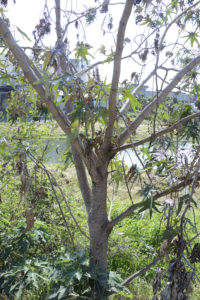
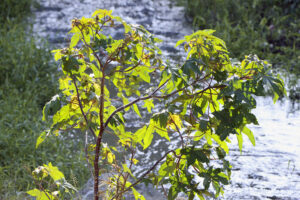
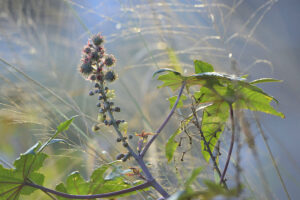

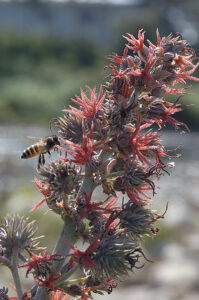
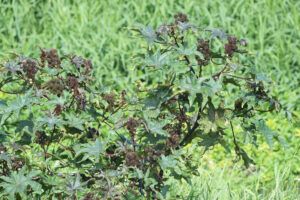
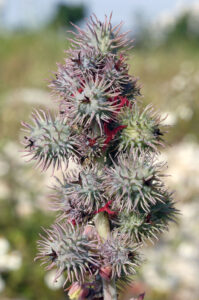
This tree is valued for its seed oil, called abrasin oil or Chinese wood oil. Because of its similarity to tung oil, which is extracted from a near relative, the tung oil tree (Vernicia fordii), the oils from the two species are often treated together as ‘tung oil’.
Traditionally, this oil is utilized to manufacture paints, Chinese black ink, and lamp oil, for waterproofing cloth and paper, and for caulking and painting ships. It was also formerly used for insulating electric wires. (Source: Protabase – Plant Resources of Tropical Africa – prota.org)
In the 1200s, Venetian explorer Marco Polo wrote: “The Chinese take lime and chopped hemp, and these they knead together with a certain wood-oil; and when the three are thoroughly amalgamated they hold like any glue, and with this mixture they paint their ships. The wood-oil is derived from a tree called tong-shu.”
Today, the main usage of the oil is in the production of paint and ink, whereas low-quality oil is processed into soap or linoleum. Growing environmental awareness has led to an increased usage of the oil from both species as a lining in food, beverage, and medicine containers. After extraction of the oil, the press cake is a good fertilizer.
Despite being highly toxic, parts of the mu oil tree are used in traditional Chinese medicine as an emetic and an anti-inflammatory, and as a vermifuge. The seed oil is a strong purgative and is also used for treatment of wounds, burns, and parasitic skin diseases. It is a component of nearly all Chinese plasters. An extract from the fruit is antibacterial.
A selection of pictures, depicting the spectacular flowering of the mu oil tree, is shown on the page Plants: When the mu oil tree is flowering.
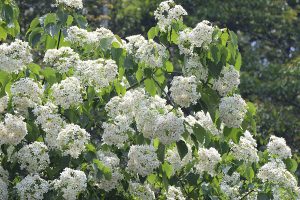
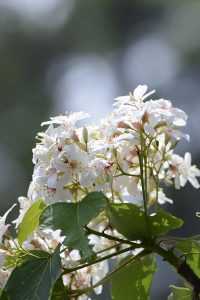
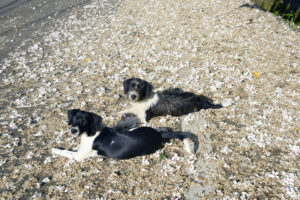
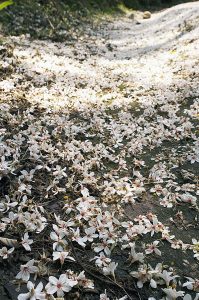
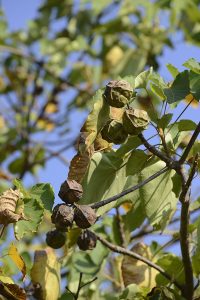
Common names of this plant include crab’s eye and cock’s eyes, which refer to the black markings on the seeds. The name jumbie bead stems from Trinidad, where bracelets, made from the seeds, are worn around the wrist or ankle to ward off jumbies (evil spirits) and mal-yeux (‘evil eyes’).
The seeds are very poisonous – ingestion of a few may be fatal. Formerly, in India, they were used for murder, and for killing cattle. In King’s American Dispensatory (1898), H.W. Felter & J.U. Lloyd write: “Abrus seeds are the agents, by which the Chamar caste (or ‘native skinners’) carry on the felonious poisoning of cattle for the purpose of securing their hides. This is done by means of small spikes, called sui (‘needles’) or sutari (‘awls’), which are prepared by soaking the awl in a thin paste of the water-soaked, pounded seeds, and then drying the weapon in the sun, after which it is oiled and sharpened upon stone, affixed in a handle, and then used to puncture the skin of the animal.”
The seeds are used as beads in rosaries and necklaces, hence the common names rosary pea, prayer bead, and paternoster pea. In the old days, they were also used by jewellers as weights, as their weight is always consistent.
Crab’s eye has antibacterial properties. In Nepal, it has numerous uses as folk medicine. A paste of the root is applied to boils, and also applied to treat headache, sore throat, and rheumatism. A paste of the leaves is applied for boils, swellings, rheumatism, caries, asthma, and loss of skin pigment. Juice of the leaves is taken for cough and fever, and as a blood purifier. Chewing fresh leaves relieves cough and hoarseness. Seeds are antiperiodic, diaphoretic, emetic, expectorant, and purgative. They are used for nausea, eye diseases, itching, and loss of skin pigment. A paste of the seeds is used for sciatica, fever, headache, malaria, paralysis, skin diseases, and bad nerves. In Ayurvedic medicine, it is said that the plant promotes hair growth, and oil from the seeds is believed to be an aphrodisiac.
In Nepal, Chepang and Mooshar tribals cook the young leaves for food. Thin branches are used for binding.
In many areas, including Belize, West Indies, United States, Hawaii, and Polynesia, crab’s eye is proclaimed an invasive weed.

This tree is native to native to tropical and sub-tropical parts of the Indian Subcontinent and Southeast Asia, southwards to Indonesia, and it is widely cultivated elsewhere for its gorgeous flowers, which are brought to temples as an offering to Hindu gods. The gum, in Hindi called kamarkas, is used in certain food dishes, and is also used for tanning and dyeing. Rope, paper, and sandals are made from fibres of the root and inner bark. The leaves are utilized as fodder, and to make plates and umbrellas. The flowers yield a yellow dye, the roots a red dye. An oil is obtained from the seeds. The soft wood is used for utensils and fuel.
In India, the so-called Bengal kino, extracted from tannin-rich vesicles in the bark, is used for diarrhoea and wounds. In Nepal, juice of the bark is used for fever, whereas the powdered seeds are utilized for inflammations, and to expel intestinal worms.
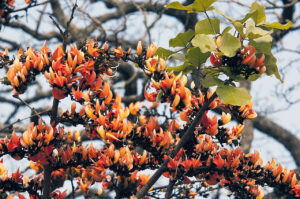
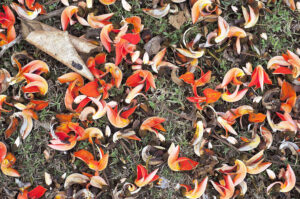
In Medieval Europe, the species was known as Planta genista, and it was adopted as emblem by Geoffrey V (1113-1151), Count of Anjou and later Duke of Normandy. He was married to Mathilda, daughter of King Henry I of England, and they had a son, who later became King Henry II (1133-1189). Planta genista was corrupted to Plantagenet, which became the family name of the English kings, up to Richard III (1452-1485).
In the Middle Ages, broom was ascribed to possess magical powers, and witches were believed to make sticks of the thicker stems, supposedly riding on them during their hallucinogenic travels.
In Celtic mythology, Blodeuwedd (‘Flower-Face’) is a woman, made from flowers of broom, meadowsweet (Filipendula ulmaria), and oak (Quercus robur).
A Christian legend has it that when Joseph and Mary fled to Egypt, they were passing through a growth of broom, the ripe pods of which made loud crackling sounds when spreading their seeds, hereby possibly drawing the attention of Herod’s soldiers, and causing the Virgin to curse the bushes.
In northern Europe, most common brooms are of South European origin, imported as ornamentals. They often escape, in many places becoming invasive, dispelling native vegetation. Genetically, they also pollute the original low and creeping variety of broom, which is today very rare. In Denmark, it is only found in a few moors and dunes in western Jutland.
In the old days, broom buds were pickled and eaten as capers, and, before the introduction of hops, young green broom shoots were added to beer to give it more flavour and make it more intoxicating. The bark yields an excellent fibre, and also contains a considerable amount of tannin, in former times utilized for tanning leather.
Medicinally, green parts of the plant were previously used for heart trouble, and also as a diuretic and cathartic. The flowers were used for gout, whereas ashes of broom were used to treat dropsy. Henry VIII would take a drink, made from broom flowers, against surfeit.
English herbalist John Gerard (c. 1545-1612) says: “The decoction of the twigs and tops of broom doth cleanse and open the liver, milt and kidnies”, whereas Nicholas Culpeper (1616-1654) considered a decoction of broom to be good for dropsy, jaundice, ague (malaria), gout, sciatica, and various pains of the hips and joints.
Today, broom is taken as a heart tonic.
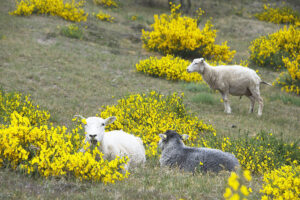
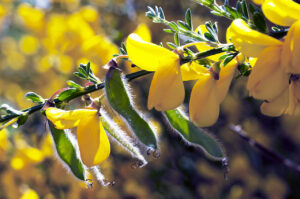
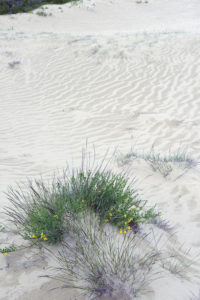
The specific name is from the Greek leuko (‘white’) and kephalos (‘head’), referring to the dense, round inflorescense.
In traditional Chinese medicine, the root and seeds are used for skin problems and arthritis.
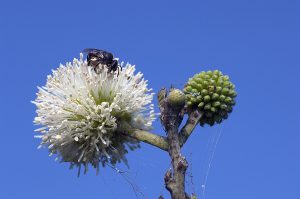
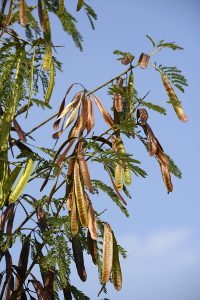
In Brazil and other places, kudzu is utilized as a soil improver due to the nitrogen-fixing bacteria in its root. It is also used for grazing, especially by goats. The root contains starch and has been used for food in East Asia for hundreds of years. A fine, grapefruit-tasting jelly is made from the flowers. The stems fibers are used for making baskets, clothes, and paper. In southern U.S., kudzu is utilized to make compost, soap, and lotions.
In Chinese, kudzu is called gé gēn, which is explained as “the root of a vine, from which you can extract medicine, and fibres of the stem may be woven into fabric.” Kudzu is widely used in traditional Chinese medicine for numerous ailments, including measles, headache, dizziness, tinnitus, dysentery, diarrhoea, colds, fever, and stiff back and neck. Root, flowers, and leaves are excellent antioxidants. In Japan, an herbal drink is made from the powdered root.
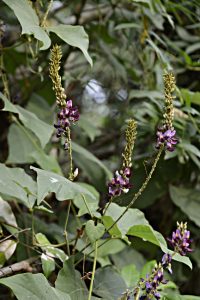
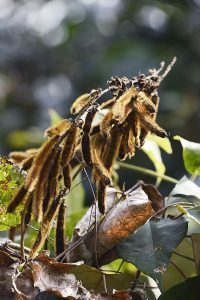
The cotyledons (embryotic leaves) and nuts are edible. Leaves are wrapped around tobacco and smoked like a cigar, and they are also lopped for fodder. The wood is hard and termite-resistant. It is utilized for roof-shingles, furniture and other items, and as fuel.
In Nepal, juice of the bark is taken for indigestion, whereas juice of young leaves are utilized for stomach disorder. The resin, pounded into a paste with water, is used for diarrhoea.
The spiny fruits may be a health hazard. Once, when I was walking in a forest above Pokhara, Nepal, a bunch of fruits fell from a tall Indian chinkapin tree onto my arm and got stuck in the skin. Luckily, the fruit spines are not barbed, but, nevertheless, it took some force to remove them from my arm!
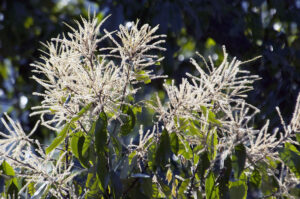
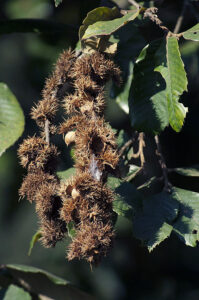
The generic name Quercus probably stems from the name of the Lithuanian god of thunder, Perkunas. The word oak is from the Anglo-Saxon ek, in ancient Germanic aik, of uncertain origin and meaning.
Previously, in large parts of Europe, oaks were sacred trees, dedicated to the highest gods: in Ancient Greece to Zeus, in Rome to Jupiter, in Norse religion to Thor, the god of thunder, and in Celtic religion to Dagda, god of manliness, fertility, and wisdom. Celtic druids often performed their rituals in sacred oak groves, especially worshipping the mistletoes (Viscum album, Santalaceae), growing on the trees.
In Celtic mythology, Blodeuwedd (‘Flower-Face’) is a woman, made from flowers of oak, meadowsweet (Filipendula ulmaria), and broom (Cytisus scoparius).
Oaks are very important timber trees, utilized for numerous items, including boats, furniture, musical instruments, and casks for storage of wine and liqueur, and in former days also for houses and ships. The astringent bark is excellent for tanning. In the old days, acorns were ground and roasted as a substitute for coffee, and they were a most important food for domestic animals, especially pigs, which were roaming the forests in search of them.
In former days, a decoction of the astringent oak bark and leaves was utilized for treating countless ailments, including diarrhoea, frostbite, haemorrhoids, rashes, epilepsy, coughing blood, poisoning, hair loss, volvulus, tuberculosis, and throat infections, to mention but a few. A poultice of fresh leaves was applied to wounds.
These two species, and other oaks, are described in depth on the page Plants: Ancient and huge trees.
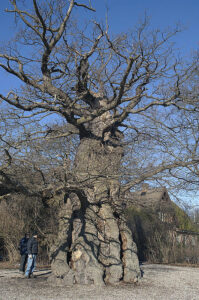
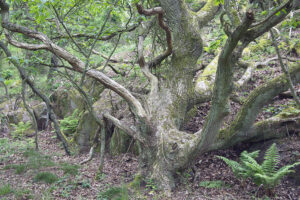

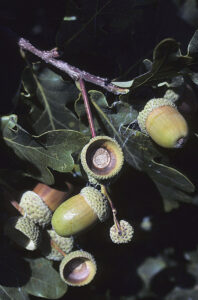
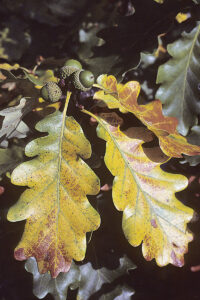
The flowers of most species are various shades of blue, others are purple, violet, mauve, yellow, white, or, rarely, red. The four or five petals are usually fused, being trumpet-, funnel-, or bell-shaped.
The generic and common names commemorate King Gentius, who ruled in Ancient Illyria 181-168 B.C., and who allegedly discovered the medicinal value of the great yellow gentian (below).
A large number of gentian species are presented on the pages Plants: Flora of the Alps and the Pyrenees, and Plants: Himalayan flora 2.
The root contains one of the most bitter-tasting substances known, and it is unrivalled as a stomachic tonic. A few drops of gentian tincture will stimulate the function of liver and pancreas, and also increase the appetite. Herbalists recommend it for a number of ailments, including jaundice, dyspepsia, flatulence, fever, and infections.
In certain parts of Europe, the fermented root is distilled, and the product is added to aperitifs and liqueurs.
A near relative, Gentiana officinalis, of China, is used for a number of ailments, including malfunction of the thyroid gland, ulcers, earache, and heartburn. In Nepal, several gentian species are utilized for various ailments, including cough, colds, and fever. A paste of the root of Gentianopsis paludosa is applied to wounds, and also to the forehead in case of headache.
Many other gentian species are presented on the pages Plants: Himalayan flora and Flora of the Alps.

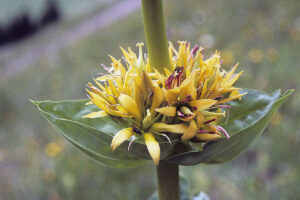
The specific name and the popular name perforate St. John’s wort both refer to the glandular dots on the leaves. Legend has it that these dots were made by the Devil, who didn’t want humans to acquire this precious herb. Therefore, he perforated the leaves with a fine needle, trying his best to make the plant wither.
As its name implies, St. John’s wort has long been associated with St. John the Baptist. In the Middle Ages, its blood-red juice symbolized the blood from the Saint’s beheading. John the Baptist had reproached King Herod for marrying his brother’s wife Herodias, hereby incurring Herodias’ wrath. Cunningly, her daughter persuaded the king to promise her anything she wanted, and, on request from her mother, she asked for John the Baptist’s head on a tray. (Mark, 6:18-28)
During the Middle Ages, this plant was in high esteem as a wound-healer, including burns and frostbite. It was also used for epilepsy, ague (malaria), intestinal worms, apoplexy, cholera, and, according to Danish physician and herbalist Simon Paulli (1603-1680), for an ailment he calls chlorosis, which young girls get, “when their wedding is approaching, and they are at the mercy of their husbands.” In this situation, they often behave, as if they are ”plagued by being possessed by the Devil.”
Formerly, this species was also utilized for treatment of lung disease and diarrhoea in cows, and tetanus in horses. – In today’s herbal medicine, it is used for burns, insect bites, wounds, scabies, and infections, and as a stomachic and sedative. New research has shown that it is very effective for depression, for herpes simplex, and probably also for HIV and Parkinson’s disease. Furthermore, it contains chemicals which stimulate liver detoxification.
For hundreds of years, flower buds have been added to alcohol, giving it a bitter taste and a wonderful dark red colour. It has also been utilized to dye wool, giving it a reddish or yellowish hue. Formerly, in rural Denmark, this herb was smoked as tobacco.
In former times, St. John’s wort was believed to possess magic powers, protecting against witchcraft and lightning strike. It was also able to exorcise the Devil from persons, which were possessed by him. In the old days, in Denmark, it was believed that if the cattle had acquired an ailment by grazing, where the elves were ruling, you should pick St. John’s wort on St. John’s Eve, at midnight, and feed it to the cattle.
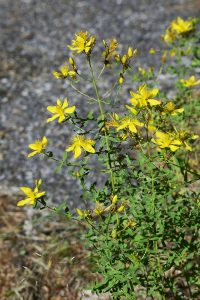


It is indigenous to almost all of Europe and North Africa, eastwards to central Siberia, Turkey, and the Caucasus, but is widely cultivated elsewhere. In the wild, it grows in dry grasslands and open woods.
Betony was held in high esteem by the Greeks as well as the Romans. Greek-Roman botanist Antonius Musa (64-14 B.C.), chief physician to Emperor Augustus, maintained that it was a certain cure for no less than 47 diseases. An old Italian proverb says: “Sell your coat and buy betony,” whereas a Spanish proverb says: “He has as many virtues as betony.”
English herbalist John Gerard (c. 1545-1612) tells us that it “preserveth the lives and bodies of men from the danger of epidemical diseases. It helpeth those that loathe and cannot digest their food.” He proceeds to say that the herb cures jaundice, palsy, convulsions, gout, dropsy, and head troubles, and that ”the powder mixed with honey is no less available for all sorts of colds or cough, wheezing, of shortness of breath and consumption,” and “the decoction made with mead and pennyroyal is good for putrid agues” [malaria].
Taken with wine it is good as a vermifuge, ”and also removes obstructions of the spleen and liver (…) gargled in the mouth easeth the toothache (…) It is a cure for the bites of mad dogs (…) A dram of the powder taken with a little honey in some vinegar is good for refreshing those that are wearied by travel. It stayeth bleeding at the nose and mouth, and helpeth those that spit blood, and is good for those that have a rupture and are bruised. The green herb bruised, or the juice, applied to any inward hurt, or outward wound in body or head will quickly heal and close it up. It will draw forth any broken bone or splinter, thorn or other thing gotten into the flesh, also healeth old sores or ulcers and boils.” [‘Stayeth’ is an old expression for ‘to stop’.]
In modern herbal medicine, an infusion is recommended for anxiety, headache, dizziness, and nerve pain.
In Ancient Rome, and during the Middle Ages, betony was regarded as a magic herb. Antonius Musa (see above) found betony effective against sorcery, and an Anglo-Saxon herbal recommends its use to prevent “frightful nocturnal goblins and terrible sights and dreams.” It was planted in churchyards and hung about the neck as an amulet or charm.
Dutch scholar Desiderius Erasmus Roterodamus (1466-1536) says that betony would protect “those that carried it about them,” being ”good against fearful visions” and an effective means of ”driving away devils and despair.”
In the Middle Ages, it was said that if you place a ring of fresh betony around adders, they dare not creep over it, but will fight and lash their tail, until they die. It was also claimed that stags, if wounded with a dart, will search out betony and be cured upon eating it.
In the 1600s, it was told that if you had been bewitched by a woman, so that you could not love any other woman, you could drink pulverized betony and pennyroyal (Mentha pulegium) with water, distilled on balm (Melissa officinalis), and hang a magnet on your naked chest. It was also said that betony water was able to make a drunken man sober – but you were not supposed to use this method more than twice a year.
Formerly, the leaves were used to dye wool yellow.
According to Roman naturalist Pliny the Elder (23-79 A.D.), an earlier name of the plant was vettonica, named for the Vettones, a people living in Spain, who used it as herbal medicine. Modern authorities, however, claim that the word is derived from the Celtic bew (’head’) and ton (’good’), referring to its usage against headache.
Originally, the specific name was derived from officina (‘workshop’, or ‘office’), and the suffix alis, which, together with a noun, forms an adjective, thus ‘made in a workshop’. However, in a botanical context, the word denotes plants species that were sold in pharmacies due to their medicinal properties.
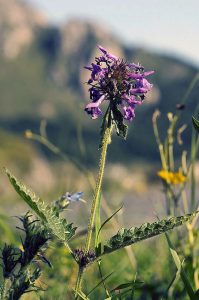
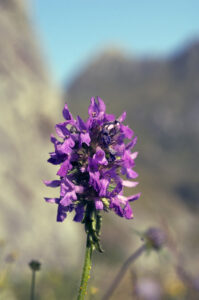
In traditional Ayurvedic medicine, root and bark are used for respiratory problems, fever, cough, and asthma. The root is also used as a laxative, and to kill fly larvae in wounds. A paste of root and leaves is used for skin diseases. Juice of the leaves is used for diarrhoea, liver disorders, wounds, fever, ulcers, and swellings, and also to expel intestinal worms, and rid livestock of lice. In India, it is used for snake bites and scorpion stings. In traditional Thai medicine, leaves and root are used as a diuretic, and to treat internal infections and kidney problems. In Nepal, the juice is dripped into the eyes of cattle to treat conjunctivitis.
In Nepal, the leaves are used as a potherb.
Several other Clerodendrum species are utilized medicinally in Asia.

An alternative English name is squirrel’s tail, alluding to the fuzzy inflorescences.
In Nepal, juice of the root is given for epilepsy, bloody cough, and peptic ulcer. Boiled in water, the root is also drunk to expel intestinal worms. A paste of the root is applied for body pain and sprains. Juice of the bark is used for fever and indigestion. The hairy leaves are applied to wounds to stop bleeding. Juice of the leaves is applied to wounds as an antiseptic, taken for fever and headache, and also to expel worms. It is dripped into the eyes of cattle with conjunctivitis. A paste of the leaves is used for dysentery. Juice of the flower buds is used for gastric problems and sinusitis. Elsewhere, woolly mint is used for skin problems, such as ringworm.
The flowers are brought as an offering in Hindu temples. The foliage used for fodder, dried branches as fuel.
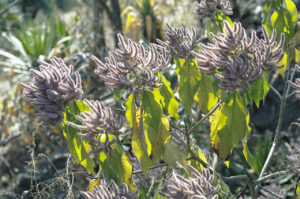
German botanist and pharmacist Carl Ludwig Willdenow (1765-1812), who was one of the founders of the study of the geographic distribution of plants, named the genus in honour of Prussian naturalist Johann Sigismund Elsholtz (1623-1688).
Several species are used medicinally in the Himalaya for various ailments, including cough, colds, wounds, and scabies.
In Nepal, juice of the root is used for headache.
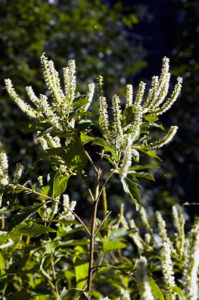
English herbalist John Gerard (c. 1545-1612) writes: “Divers commend it against infirmities of the heart. Moreover, the same is commended for green wounds; it is also a remedy against certain diseases in cattell, as the cough and murreine, and for that cause divers husbandmen oftentimes much desire it.”
English herbalist Nicholas Culpeper (1616-1654) says: “There is no better herb to drive melancholy vapours from the heart, to strengthen it and make the mind cheerful, blithe and merry. May be kept in a syrup, or conserve, therefore the Latins call it cardiaca…. It cleanseth the chest of cold phlegm, oppressing it and killeth worms in the belly. It is of good use to warm and dry up the cold humours, to digest and disperse them that are settled in the veins, joints and sinews of the body and to help cramps and convulsions.”
In China, in the old days, motherwort was used to prevent pregnancy and to regulate menstruation, and in Europe, midwives used it for various female disorders, including uterine infection – hence the name motherwort. Same usage was found among American natives of the Delaware area.
In his delightful book All about Weeds, American botanist Edwin Spencer (1881-1964) writes: “Here’s sumpin’ you art to know,” said an old midwife to a young bride, as the two of them stood looking at a tall mint, growing by the garden fence. “This is motherwort.”
Today, motherwort is valued as a diaphoretic, antispasmodic, tonic, and nervine. As a tonic, it is taken for palpitations and irregular heartbeat, and for fever, nervousness, and delirium. It is also used to ease stomach gas.
In Nepal, the juice is utilized as a diaphoretic and stomachic. Pounded leaves are applied to fungi between the toes, caused by walking barefoot in water during the rainy season.
The generic name is a Latinized form of the Greek words leon (’lion’) and oura (’tail’), thus ‘lion’s tail’, which is also one of its popular English names. It is not clear, why Swedish naturalist Carl Linnaeus (1707-1778) named it thus.
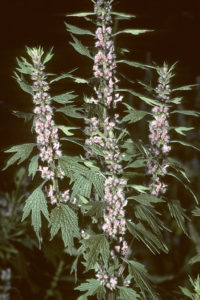
It has also been used as a diuretic, and for its relaxing and soothing effect. It invigorates the blood circulation, reduces swellings, and is also used for eye problems and high blood pressure.
This plant is native to China, Mongolia, and southern Siberia, but has become naturalized in the Americas and elsewhere. In Central and South America, it is utilized as a mild intoxicant, nicknamed marihuanilla (’little marihuana’).
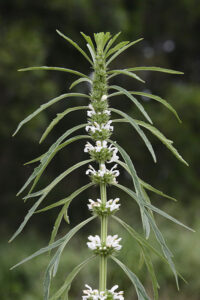
The generic name, formerly spelt Brunella, is derived from the German name of the plant, Braunelle, referring to the usage of the plant against quinsy, in German Bräune.
In his delightful book All about Weeds, American botanist Edwin Spencer (1881-1964) writes: “It is a strange plant in that one seldom finds it in abundance anywhere, and yet it is found everywhere. A man, who had spent seven years in Japan, and who had lived on nearly every island in the archipelago, said that he never failed to find this little plant wherever he went, and that although he had been in many nations of the world he had never entered one, where Prunella was not present to greet him – not many plants, but always enough to attract his attention.”
English herbalist John Gerard (c. 1545-1612) writes: “There is not a better wound herbe in the world than that of Self-Heale (…) for this very herbe, without the mixture of any other ingredient (…) will be brought into the form of a salve, which will heal any green wounde, even in the first intention, after a very wonderful manner. The decoction of Prunell, made with wine and water, doth join together and make whole and sound all wounds, both inward and outward.” – Another herbalist, Nicholas Culpeper (1616-1654), says: “Self-Heal whereby when you are hurt, you may heal yourself. It is an especial herb for inward or outward wounds.”
English botanist William Coles (1626–1662), also called William Cole, writes in Adam in Eden, or Nature’s Paradise. The History of Plants, Herbs, Flowers (1657): “(…) Brunella, from Brunellen, which is a name given unto it by the Germans, because it cureth that inflammation of the mouth which they call ‘die Breuen’.” Cole was partly mistaken, as the German name of the plant is Braunelle, and the inflammation, which is not in the mouth, but in the throat, is called Bräune.
Among American natives, persons with fever were bathed in a decoction of self-heal. This decoction was also drunk to sharpen your vision.
Today, self-heal is still used for wounds and quinsy.

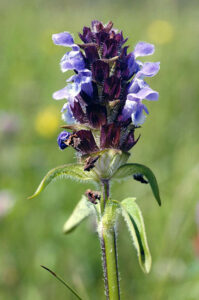
English herbalist John Gerard (c. 1545-1612) strongly recommended it in his Great Herball, saying that in Kent he accidentally heard of a countryman who had cut himself severely with a scythe, and had bound a quantity of this herb, bruised with grease and ”laid upon in manner of a poultice” over the wound, which healed in a week, though it would ”have required forty daies with balsam itself.”
Gerard continues: ”I saw the wound and offered to heal the same for charietie, which he refused, saying I could not heal it so well as himself – a clownish answer, I confesse, without any thanks for my good-will: whereupon I have named it ’clown’s woundwort’.” Later, Gerard ”cured many grievous wounds, and some mortale, with the same herbe.”
Formerly, American natives also employed marsh woundwort as a poultice on wounds, and the herb was eaten to reduce mucus when coughing. It was also an ingredient in a medicine used for venereal diseases.
In modern herbal medicine, woundwort is employed for its antiseptic and antispasmodic properties, relieving gout, cramp and pains in the joints and vertigo. Fresh juice of the leaves is made into a syrup and taken internally to stop haemorrhages, dysentery, etc.
The roots are edible and nutritious. In former times, they were used in bread.
Marsh woundwort is native to temperate Eurasia and has become naturalized in North America.
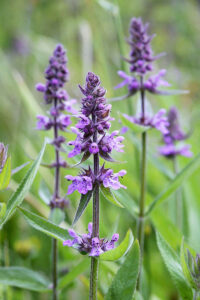
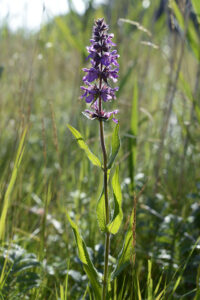
This species is native to southern Japan, South Korea, south-eastern China, Taiwan, and Vietnam, but is widely cultivated elsewhere for production of camphor, which is used as an ingredient in incense and medicine, as a spice, and as an insect repellent. In Ancient Egypt, it was used as early 1485 B.C. for embalming.
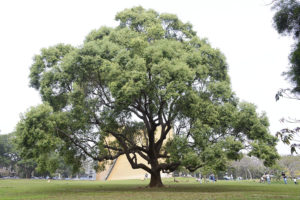
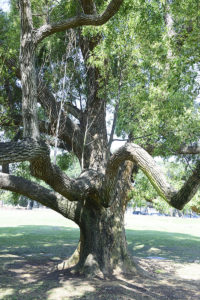
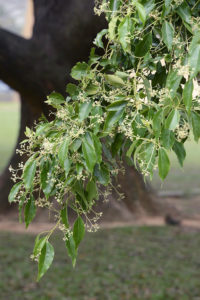
This tree is probably native to north-eastern Africa, Arabia, and Iran, but is widely cultivated, especially in India and Pakistan.
Because of its cooling properties, desert people of Arabia, and elsewhere, have, for millennia, been using henna juice to cool down their bodies. They noticed that the juice left marks on the skin, which led to the idea of using it to make designs for decorative purposes. In Ancient Egypt, some of the mummies were adorned with henna, and it is told that Queen Cleopatra (69-30 B.C.) also used it for decoration.
Still today, henna is widely used in Pakistan, India, North Africa, and the Middle East for decoration of skin and fingernails, and as a hair dye. It is also utilized as a natural dye in the textile industry. An oil extracted from the flowers is used in the perfume industry.
Greek physician, pharmacologist, and botanist Pedanius Dioscorides (died 90 A.D.) was the author of De Materia Medica, five volumes dealing with herbal medicine. He claims that chewing henna leaves is good for mouth ulcers because of their content of tannin, and he also recommends applying a poultice of the leaves to skin inflammations and boils.
Henna is famous for its anti-cancerous and anti-inflammatory properties, and it is commonly used in Unani and Ayurvedic medicines. The plant is used for fever, dandruff, heat stroke, leucodermia, and leprosy in early stages; bark and root for liver enlargement and jaundice; flowers for headache; a paste of the leaves for sunburn, prickly heat, rashes, bruises, burns, boils, skin diseases such as eczema and ringworm, haemorrhoids, sore throat, inflammatory swellings, leprosy, and rheumatic joint pain; seeds for dysentery; seeds and leaves for vaginal discharge and excessive menstruation; and oil from the seeds for arthritis, scabies, and hair loss.
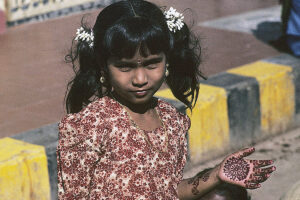
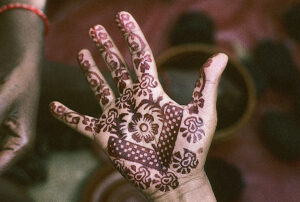
Roman naturalist Pliny the Elder (23-79 A.D.) recommended pomegranate root bark to expel tapeworms – an efficient, but nauseating method. Juice and rind are anti-inflammatory, having a high content of anti-oxidants. Pomegranate is probably an efficient remedy against breast, colon, and prostate cancer. The leaves, which have antibacterial properties, are applied to wounds. In Ayurvedic medicine, the bitter rind is used to treat dysentery, and in the West for diarrhoea.
In Greek mythology, King Peleus was about to marry the beautiful sea nymph Thetis, but, unfortunately, they had forgotten to invite the goddess of strife, Eris, to the wedding. As a revenge, Eris let a golden apple roll in among the guests, and in the fruit skin she had carved: “For the most beautiful one.”
Three of the goddesses, Hera, Athene, and Aphrodite, began arguing, to whom of the three the title should be bestowed. Zeus advised them to go to Troy to consult Prince Paris. Off they went, and upon arrival in Troy, each of them promised Prince Paris a reward, if he chose her: Hera promised him power, Athene fame and wisdom, and Aphrodite the most beautiful woman. He chose the latter – hereby indirectly causing the long siege of Troy, related in Homer’s poem Iliad.
Traditionally, the golden apple is considered to be the sweet apple (Malus pumila), but it is just as likely to have been pomegranate, as the apple may not yet have been introduced to Greece at the time, when the text was written.
One of the most famous Christian myths is about The Fall of Man. Genesis, Chapter 3:1-7, reads as follows:
”Now the serpent (…) said to the woman, “Did God really say, ‘You must not eat from any tree in the garden’?”
The woman said to the serpent, “We may eat fruit from the trees in the garden, but God did say, ‘You must not eat fruit from the tree that is in the middle of the garden, and you must not touch it, or you will die.’”
“You will not certainly die,” the serpent said to the woman. “For God knows that when you eat from it your eyes will be opened, and you will be like God, knowing good and evil.”
When the woman saw that the fruit of the tree was good for food (…) and she took some and ate it. She also gave some to her husband, who was with her, and he ate it. Then the eyes of both of them were opened, and they realized they were naked; so they sewed fig leaves together and made coverings for themselves.”
Traditionally, the Fruit of Knowledge is also regarded as being the apple, although the text in Genesis does not mention this. However, it is just as likely to have been pomegranate, or perhaps apricot (Prunus armeniaca), as the apple may not yet have been introduced to the Near East at the time, when the text was written.
Pomegranate juice is very refreshing. It is also added to the alcoholic drinks Grenadine and Campari, adding a bright red colour and a bitter taste. In Morocco, an extract of unripe fruits is used for tanning leather goods. Due to its pretty flowers, pomegranate is often cultivated as an ornamental.
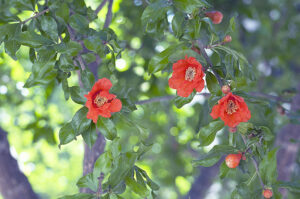
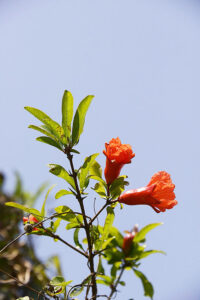
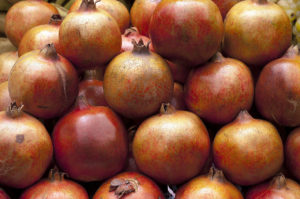
In some places, it is cultivated as a source of food. The leaves are eaten in several Pacific Islands. In Japan and Korea, paper is made from the plant.
In Nepal, juice from the root is applied to sprains, whereas a paste of the bark is applied to wounds. Juice of the flowers is used as a remedy for bronchitis and tooth ache. In traditional Chinese medicine, it is widely used to treat kidney problems.
Aibika is a near relative of okra, or ladies’ fingers (A. esculentus), which has edible fruits.
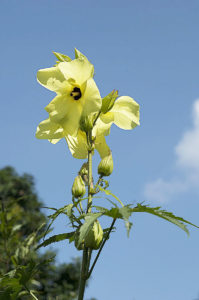
In Ancient Egypt, the sap was extracted and mixed with nuts and honey, or the soft, spongy pith was boiled in sugar syrup and dried to produce a soft, chewy sweet. In the old days, in England and the United States, stem and root, which contains some sugar, were used in sweets, called marshmallows. Today’s marshmallows, however, have nothing to do with the plant. They are a mixture of whipped sugar, water and gelatine, which is then moulded into small cylindrical pieces and coated with corn starch.
Since Ancient Egypt, an extract of the root has been used for cough. In Ancient Arabia, a poultice made from marshmallow was used for inflammation, and in Ancient Greece it was used for stings, wounds and ulcers. Traditionally, in Denmark, it was utilized for a number of ailments, such as boils, dysentery, bladder stones, epilepsy, tuberculosis, tooth ache, colic, kidney pain, haemorrhoids, stomach ache, and whooping cough.
In today’s herbal medicine, common marshmallow is used for treatment of cough, colds, flu, bronchitis, diabetes, skin problems, ulcers and urinary tract inflammation. All parts of the plant are rich in mucilage, which heals soreness and inflammation.
Originally, officinalis was derived from officina (‘workshop’, or ‘office’), and the suffix alis, which, together with a noun, forms an adjective, thus ‘made in a workshop’. However, in a botanical context, the word denotes plants species that were sold in pharmacies due to their medicinal properties.
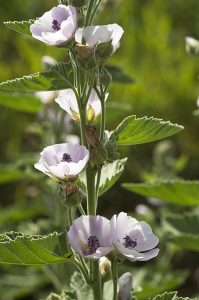
In several Asian countries, the flower-buds are eaten as a vegetable, or pickled, and in Thailand and China, the flowers are used for soup and tea. The young root and ripe seeds are eaten roasted. The root, rich in starch, is also eaten raw. An oil is obtained from the seeds. The wood is used for boats and planks, and rope is made from the bark fibres. The flowers develop into large fruits, containing an abundance of fluffy hairs, which are stuffed in pillows and quilts.
In Nepal, juice of the plant is used for headache and wounds, and juice of the bark for cough, indigestion, and stomach ache. A decoction of the bark is used for fever. The young roots are used for cholera, tuberculosis, cough, urinary trouble, dysentery, and impotence. Root and gum are used for diarrhoea, dysentery, tuberculosis, influenza, wounds, and heavy menstrual bleeding. Juice of the root is used for gonorrhoea and difficulty of urinating. Powdered seeds are given for amoebic dysentery.
In traditional Ayurvedic medicine, silk-cotton tree is utilized for asthma, diarrhoea, vaginal discharge, anaemia, seminal disorders, wounds, and skin problems.
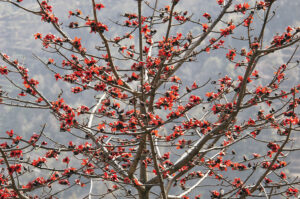
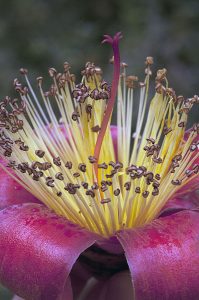
Some authorities claim that this species is a native of West Africa, others maintain that it stems from India or Southeast Asia. Today, it is cultivated worldwide in tropical and subtropical areas, the largest producers being China and Thailand.
In Senegal and other African countries, and in various Asian countries, the green leaves are eaten as a spicy vegetable. In Nepal, the calyx is eaten raw or pickled. From the calyx, jam and a red drink, called karkade, are produced. In Europe and North America, the calyx is used for food colouring. Bast is produced from the stem fibres.
Traditionally, roselle has been used as a diuretic and as a mild laxative. In Brazil, the root is used as a stomachic, and also as an emollient. The Naga people of north-eastern India drink an extract of the root for constipation and stomach ache, and as an emollient and carminative. The red calyx contains antocyanins, and research indicates that these substances can prevent rheumatism, diabetes, and colon cancer. Antocyanins are excellent anti-oxidants, which can subdue infections. The seeds are also a good source of anti-oxidants.
The pictures below are all from Taiwan, where roselle is commonly cultivated.

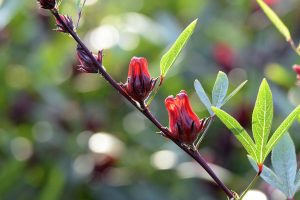
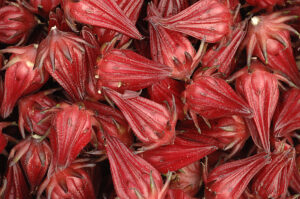
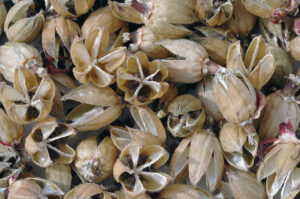
In prehistoric times, linden trees were sacred to many Germanic and Slavic tribes. In the Norse religion, they were dedicated to Odin’s wife Frigg, goddess of wisdom and foreknowledge. Later, lindens were worshipped as a symbol of knowledge, often planted in the centre of the village, where the elders would meet to discuss various issues.
In Denmark, a boat from the Bronze Age, made from linden wood, has been excavated, and, through the ages, the wood has been utilized to make countless other items, including wagons, furniture, eating utensils, musical instruments, and artificial limbs. It also gives excellent charcoal for drawing.
A cup, made from linden bark, has been found in a Danish Bronze Age grave, and later the bark was used as an ingrediens in lacquerware, paper, and other items. The inner bark, called bast, was utilized as far back as the Bronze Age, as evidenced by several grave finds. Later, this bast was used for production of numerous items, including baskets, rope, and mats. (Today, most bast is extracted from various species of palms of the genus Raphia.) In Russia, linden bast is still widely used for various purposes, including production of bast shoes.
Due to their content of essential oils, linden flowers emit a powerful fragrance, and tea made from dried flowers is a popular drink in many countries, in France called tilleul, in Italy tiglio, and in the Unites States basswood tea. The flowers supply excellent honey, and during the Middle Ages, linden trees were often planted around monasteries and castles to provide honey. Oil from the wood was taken to treat numerous ailments, including headache, colds, cough, fever, infections, epilepsy, stomach trouble, gravel, high blood pressure, and as a diuretic, and as a sedative in cases of anxiety and insomnia. The bark was used for infections and burns.
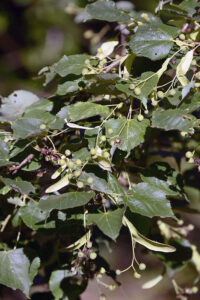
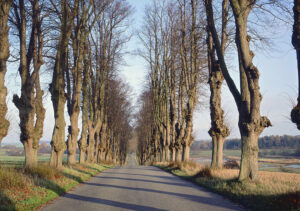
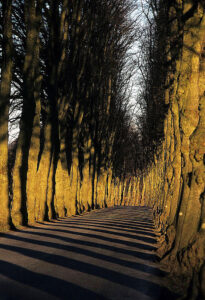
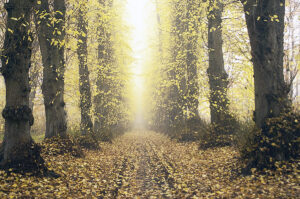
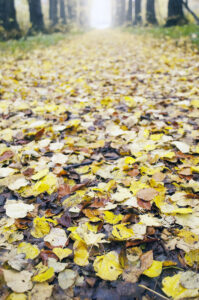
The generic name was applied by Swedish naturalist Carl Linnaeus (1707-1778) in allusion to the tripartite leaves of the genus. The popular name wake-robin refers to the early flowering of this species, at about the time, when the first American robins (Turdus migratorius) would return from their southern wintering areas. The name stinking Benjamin alludes to the unpleasant smell of the plant, a bit like rotting meat. The names squawroot and birthroot, and a corruption of the latter, bethroot, refer to the usage of the root for post-partum haemorrhage and excessive menstrual flow. (The word squaw is of Algonquian origin, meaning ‘woman’.)
In the Appalachian Mountains, some native tribes regarded the root as an effective aphrodisiac. The boiled root can be used to treat dysentery and diarrhoea.
Other species of the genus are used for respiratory problems, including cough, bronchitis, and asthma, and for fever.
Some present-day witches regard purple trillium as a magic herb.
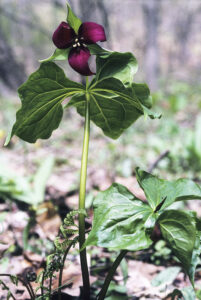
The name neem (also written nim) is Hindi, derived from the Sanskrit name of the plant, nimba. The popular name Indian lilac is a bit odd, as the flowers are white. The name was probably given to separate it from the related Persian lilac (Melia azedarach), which has beautiful lilac inflorescences. This species is described on the page Plants: Ancient and huge trees.
Neem is sacred to Hindus and plays a major role in several festivals. It is widely planted as a wind-breaker and fodder tree. The wood is insect repellent and much used for construction and furniture. Dried leaves are placed in cupboards to keep insects away, and boiled leaves can drive harmful birds, such as sparrows, away from crops. Powdered seeds are used as an insecticide. Tender shoots and flowers are eaten as a vegetable, and also pickled. The seed oil is used as an ingredient in soap, shampoo, creams, and toothpaste, and in rural areas it is used to grease cart wheels. Gum arabic is produced from the resin, and the bark contains tannin. The flowers are an excellent source of honey. Neem cake is used as fertilizer.
Neem has been utilized in Indian Ayurvedic medicine for over 2,000 years. Juice of the bark is used for fever, cough, and urinary disorders. A paste of the bark is applied to swelling or bleeding from the gums. Oil from the seeds is used to improve the liver function, detoxify the blood, and to balance blood sugar levels, and is also applied to burns. A paste of the seeds is used for leprosy. Neem is also used for skin diseases, as a vermifuge, to fight bacterial, viral, and fungal attacks, and as a contraceptive and sedative.
Twigs, called datun, are utilized as a kind of toothbrush, as they are chewed and rubbed against the gums. The juice possesses bacteria-killing properties and thus reduces plaque.
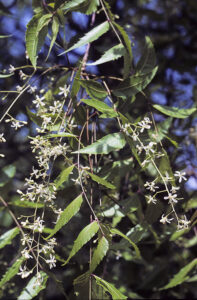

Pipal is native to the Indian Subcontinent, south-western China, and Southeast Asia, and is widely planted elsewhere in warmer countries. It belongs to a group of fig trees, called strangler figs. A pipal seed takes root high up in a tree, from where the sprouting plant sends aerial roots down to the ground. Over the years, these aerial roots wrap themselves tightly around the host tree, strangling it.
This species is cultivated as an ornamental in most warm countries of the world. In Nepal, the bark is used for dyeing and tanning, the inner bark for binding material, and the foliage is used for fodder.
In traditional Ayurvedic medicine, pipal is used for about 50 types of disorders, the bark for dysentery, diarrhoea, diabetes, nervous disorders, heavy menstrual bleeding, bone fractures, earache, glandular diseases, gonorrhoea, scabies, skin diseases, and also as a laxative; oil from the root bark for skin diseases and rheumatism; leaves for constipation; latex for warts; powdered fruit for asthma; seeds as a laxative; young shoots as a purgative.
In Nepal, the bark is used to prevent bleeding from wounds, and also for gonorrhoea, diarrhoea, dysentery, paralysis, scabies, and snakebites. The latex is used for toothache and sore gums. Juice of young leaves is dripped into aching ears. A paste of the leaves is used for skin diseases, the fruit as a laxative.
Numerous other Ficus species are utilized medicinally.
Pipal and its important role is described in depth on the page Plants: Fig trees, whereas the life of The Buddha is related on the page Religion: Buddhism.

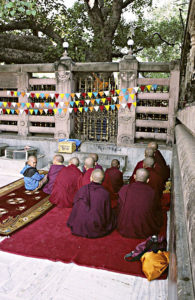
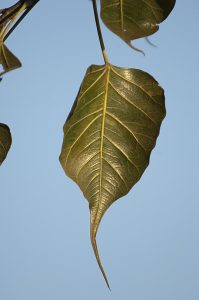
The popular name fever tree stems from the practice of planting eucalyptus trees in swampy, malaria-ridden areas. As their roots are able to store large quantities of water, the swamps dry out, making the malaria-bearing mosquitos disappear.
Eucalyptus plantations are very harmful to the environment, not only because large tracts of forest have been cut down, but also because of the water-retaining properties of these trees, causing the soil to dry out.
Essential oils are extracted from the leaves, used in treatment of colds, sore throat, cough, flu, fever, breathlessness, sinusitis, allergies, viral infections, bronchitis, tuberculosis, and stomach problems. The oil is added to throat lozenges, called ‘eucalyptus bonbons’, which are good against bad breath. The oil is also used by the aborigines of Australia to treat wounds, and research has shown that it is indeed a very effective wound healer.
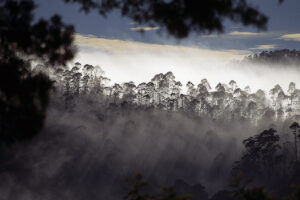
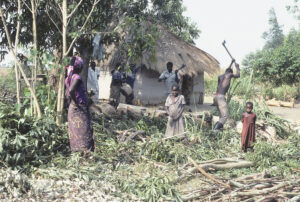
In Sanskrit, this plant is called padma, and it is an ancient sacred symbol in the four main Indian religions, Hinduism, Buddhism, Sikhism, and Jainism. It is associated with the Hindu gods Brahma, Vishnu, Lakshmi, and Saraswati, Vishnu often being described as the ‘Lotus-eyed One’. The lotus flower spouts from his navel, while he assumes the Yoga Nidra position, and it uncovers Brahma, creator of the World, sitting in lotus position.
To Buddhists, the lotus is seen as a symbol of purity in a dirty world. Despite often growing in muddy water, the plant produces a wonderful flower. A widely used Buddhist mantra is Om Mani Padme Hum, which loosely translates as ‘Hail Jewel in the Lotus Flower’. The jewel, naturally, is The Buddha.
All parts of the plant are edible, in particular rhizome and seeds.
The generic name is derived from the Sinhalese name of the lotus, nelum, whereas the specific name nucifera is from the Latin nux (‘nut’) and fer (‘to carry’), thus ‘nut-bearing’, referring to the edible seeds.
The rhizome, leaves, and seeds are widely used in traditional Indian and Oriental medicine for treatment of numerous ailments. Leaves are used against vomiting of blood, nose-bleeding, and blood in the urine, flowers are used for diarrhea, cholera, fever, and intense thirst, and rhizomes have diuretic, anti-diabetic, and anti-inflammatory properties.
The various religions of India are described on the page Religion.
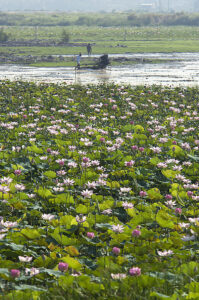
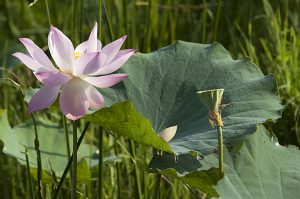
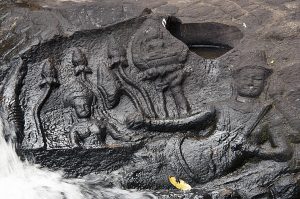

The generic name, as well as the common name in most languages, is derived from the ancient Persian name of these plants, yasmin. Originally, officinalis was derived from officina (‘workshop’, or ‘office’), and the suffix alis, which, together with a noun, forms an adjective, thus ‘made in a workshop’. However, in a botanical context, the word denotes plants species that were sold in pharmacies due to their medicinal properties.
From time immemorial, an essential oil from white jasmine has been used in the perfume industry, and as a medicinal plant, over the years used as an aphrodisiac, a sedative, an antiseptic, antidepressant, antispasmodic, and analgesic. In Ayurvedic medicine, it is utilized for fever and conjunctivitis, and to improve immunity. In traditional Chinese medicine, tea made from the flowers is used for various ailments, including wounds, heat stroke, fever, and urinary infection. This tea can also relieve stress and anxiety. A poultice of the flowers is used for headache and stroke.
This species is probably indigenous from the Caucasus eastwards across the Himalaya to south-western China, and it has also become naturalized in southern Europe, North Africa, Florida, the West Indies, and elsewhere. It is the national flower of Pakistan.
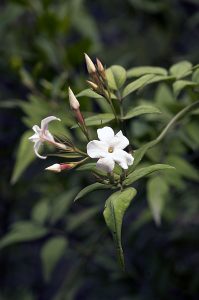

Since Biblical times, olive oil has been used to soften and beautify the skin, and it is also a good remedy against dry hair. When taken daily, it may protect against heart disease, and it may also lower the cholesterol level in the blood. New research has shown that it may prevent stroke, breast and colon cancer, arthritis, gout, and migraine. Warm oil, dripped into the ear, can relieve earache. The oil is also used as a laxative, whereas an infusion of the leaves is taken for infections, colds, fever, flu, meningitis, herpes, shingles, pneumonia, tuberculosis, and diarrhoea, and is also applied to wounds and psoriasis. The timber is used for carving and turning.
According to the Old Testament, Moses made a decree that people in charge of tending the olive groves were excepted from doing military service.
In Greek mythology, Athene was the goddess of war, but also protector of cities. She vied with the god of the seas, Poseidon, who was going to be the tutelary deity of a newly established town at the Saronian Bay. Poseidon let a spring well forth, but unfortunately it was salty. Athene created the olive tree, and the population of the town elected her. In her honour, the town was named Athens, and groves of olive trees were planted around it.
Olive trees can live for more than 2,000 years. Some specimens in the Gethsemane Garden, beneath the Mount of Olives in Jerusalem, were young trees, when Jesus lived in this area.
The olive tree is described in depth on the page Plants: Ancient and huge trees.

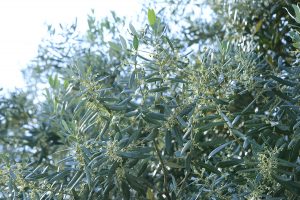

In Nepal, the root is used for soothing the mucous membranes, reducing mucus in lungs, stopping bleeding of wounds, and as a remedy for stomach disorders. In Ayurvedic medicine, juice from the root is used as a tonic, and for treating inflammation of gum and teeth. It is also highly valued as an aphrodisiac. Traditionally, it has been used for treating bone fractures.
The species is protected by law, but is nevertheless severely threatened due to over-collecting. In Nepal, the price of the dried root was about 100 US Dollars per kg in 2015.
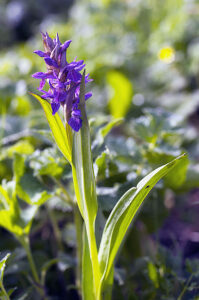
Formerly, these genera were included in the figwort family (Scrophulariaceae). However, following genetic research, they have been moved to the broomrape family. Other hemi-parasites, as well as some holo-parasites, which obtain all their nutrients from other plants, are presented on the page Plants: Parasitic plants.
The usage of these plants for eye problems goes back to medieval Europe. Followers of the Doctrine of Signatures claimed that the Great God had made all plants, so that humans would recognize the usage of them. To them, the red streaks on the petals of eyebright resembled bloodshot eyes, and for this reason, this plant would be an effective remedy for eye diseases. Matthaeus Sylvaticus (1285-1342), a physician of Mantua, recommended it for disorders of the eyes, whereas Jervis Markham (1568?-1637), in his Countrie Farm (1616), advises people to “drinke everie morning a small draught of eyebright wine.” In the 18th Century, eyebright tea was drunk, and in Queen Elizabeth’s time a drink called ‘eyebright ale’ was produced.
English herbalist John Gerard (c. 1545-1612) says that powdered eyebright, mixed with mace, “comforteth the memorie,” whereas another herbalist, Nicholas Culpeper (1616-1654), recommends the following recipe for “an excellent water to clear the sight: Take of fennel, eyebright, roses, celandine, vervain, and rue, of each a handful, the liver of a goat chopt small, infuse them well in eyebright water, then distil them in an alembic, and you shall have a water will clear the sight beyond comparison.”
For once, the followers of the Doctrine of Signatures hit the nail on the head, as the plant is still recommended for conjunctivitis (‘red eyes’), infection of the eyelid, and discharge from the eyes. It is also used for indigestion, and for inflammation of the trachea. The dried herb is an ingredient in British Herbal Tobacco, which smoked is useful for chronic bronchial colds.
In Nepal, Himalayan eyebright (E. himalayica) is utilized to curb profuse menstruation, and juice of the root is applied to boils.
A popular French name for these plants is casse-lunettes, which loosely translates as ‘throw away your glasses’.
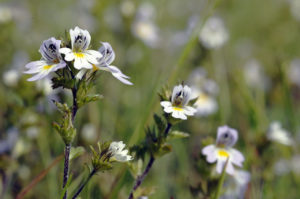
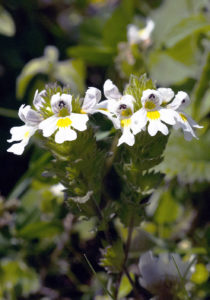
The generic name is derived from the Latin pediculus (‘louse’). According to an old superstition, louseworts could transfer lice to people and cattle, or, according to another belief, the exact opposite was the case, namely that they were able to rid people and cattle of lice! In Denmark, a decoction of these plants was used to expel lice from clothes.
If you shake a lousewort capsule that contains ripe seeds, you may hear a rattling sound from the seeds, which has given rise to the popular name rattle of these plants.
Usually, animals do not graze on louseworts, as they contain poisonous glycosides. Nevertheless, in former times, children at various places in Great Britain would suck out the nectar of the flowers. In Donegal, the plant was known as honey-cap or honey-cup, and in Shetland as bee-sookies or hinney-flo’er.
In North America, Canadian lousewort (Pedicularis canadensis), also called wood betony, was formerly much utilized by native tribes as a medicinal herb and as an aphrodisiac. Medicinally, it was used as a blood tonic, and for anaemia, heart trouble, stomach ulcers, and bloody diarrhoea. Leaves and stems were cooked as a vegetable. The Menomini, or Mamaceqtaw, an Ojibwe tribe of Wisconsin, carried the root as a charm, as they believed it would assist in seducing the opposite sex. The root was also regarded as being able to heal broken marriages, by mixing it into food, which both parties would eat.
Other species of lousewort are presented on the pages Plants: Flora of the Alps and the Pyrenees, and Plants: Parasitic plants.
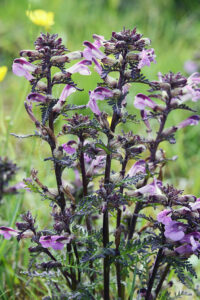
English herbalist Nicholas Culpeper (1616-1654) informs us that “the red rattle is accounted profitable to heal fistulas [an abnormal connection between two hollow spaces, such as blood vessels or intestines] and hollow ulcers, and to stay the flux of humours [liquids] in them, as also the abundance of the courses or any other flux of blood, being boiled in port wine and drunk.” [‘To stay’ is an old expression for ‘to stop’.]
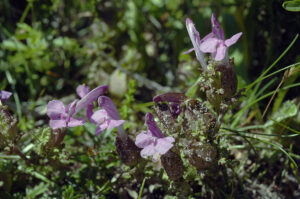
The Swedish name of this species, Kung Karls spira, means ’Scepter of King Karl (Charles)’, where ’scepter’ refers to the erect inflorescence. It was applied to this plant by Swedish naturalist and linguist, professor of medicine, and principal of the university of Uppsala, Olof Rudbeck the Younger (1660-1740), who was a pioneer of botany and ornithology. The name was meant as a homage to King Karl XII (1682-1718), following the victory in the battles of Narva, Estonia, in 1700, and Riga, Latvia, in 1701. (Source: linnaeus.nrm.se)
The specific name is a direct translation of the Swedish name, applied by the famous Swedish naturalist Carl Linnaeus (1707-1778).


This plant is parasitic on roots of other plants, mainly of the heath family (Ericaceae). It is restricted to California and Oregon, growing at low elevations in woodlands and chaparral, a community of shrubby plants, adapted to dry summers and moist winters, which is typical of southern California.
Formerly, this plant was taken by indigenous peoples to relax tired muscles, and buds and flowers were smoked as a mild intoxicant.

It was first collected in New Mexico in the 1850s by surgeon and botanist John Milton Bigelow (1804-1878), who collected many new plant species on expeditions to south-western U.S. and northern Mexico. The specific name is from the Greek kentron (‘sharp point’) and anthos (‘flower’), alluding to the pointed flowers.

The generic name is from the Greek chelidon (‘swallow’). Greek scientist and philosopher Aristotle (384-322 B.C.) relates that swallows take celandine flowers and place them on the eyes of their young, in case they suffer from eye infection. According to Roman naturalist Pliny the Elder (23-79 A.D.), the name refers to the fact that the plant comes into flower when the swallows arrive, and fades at their departure. The name celandine is a corruption of the Greek word, and the name tetterwort refers to the usage of the plant for skin problems.
Certain early botanists thought that another plant, which is today called Ranunculus ficaria, was related to greater celandine, naming it Chelidonium minus, in English ‘lesser celandine’. For some reason or other, both English names of these entirely unrelated plants stuck.
The yellow sap of greater celandine, together with its rotton odour, has led to many fanciful imaginations. In his book Utkast till svenska växternas naturhistoria (1867-1868), Swedish botanist C.F. Nymann (1820-1893) writes: ”As this plant is often growing in cemeteries, the common people believe that it has drawn its poignant sap from dead bodies, for which reason they regard it with a certain abhorrence.”
Greater celandine is mentioned by Pliny the Elder as a drug plant, and it was also used during the Middle Ages. In the fourteenth century, a drink made with celandine was supposed to be good for the blood. English herbalist John Gerard (c. 1545-1612) says: “the juice of the herbe is good to sharpen the sight, for it cleanseth and consumeth away slimie things that cleave about the ball of the eye and hinder the sight and especially being boiled with honey in a brasen vessell, as Dioscorides teacheth.” – Greek physician, pharmacologist, and botanist Pedanius Dioscorides (died 90 A.D.) was the author of De Materia Medica, five volumes dealing with herbal medicine.
It has also been used for jaundice, and in Russia it is said to have proved effective in cases of cancer. Among American tribes, a decoction of the plant was used as a sedative.
In modern herbal medicine, greater celandine is regarded as one of the best remedies for gall and kidney stones, and also as an effective diuretic and a powerful purgative. The juice is a good remedy for skin problems like eczema and warts. As the juice is caustic, it should not get into contact with healthy skin. A decoction of the plant, mixed with potassium chloride, is applied to corns, and is also used as a hair rinse to fight dandruff.
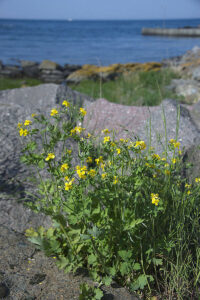

The leaves were used medicinally by Native Americans. In modern herbal medicine, it is regarded as a mild sedative and relaxant, suitable for children. It improves sleep quality and can prevent nightmares. It is also taken for hyper-activity, headache, migraine, depression, and nerve pain.
The seeds are used in cooking. Formerly, the pollen was utilized cosmetically by Native Americans.
In 1903, California poppy became the official state flower of California.
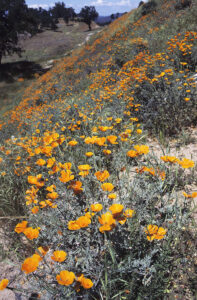

Originally, officinalis was derived from officina (‘workshop’, or ‘office’), and the suffix alis, which, together with a noun, forms an adjective, thus ‘made in a workshop’. However, in a botanical context, the word denotes plants species that were sold in pharmacies due to their medicinal properties.
This species is a native of Europe, western Asia, and North Africa, and it has become naturalized in North America, Australia, New Zealand, and elsewhere. Traditionally, it has been used to treat skin problems, including eczema and psoriasis, and also for liver ailments, as a laxative, and as a diuretic. Recent research has shown that it may indeed be effective against psoriasis, and in Germany it has been approved for treatment of pain in the gallbladder.
In Turkey, closely related species are used as blood purifiers and for allergy. In Nepal, F. indica is used as a diuretic, and to expel intestinal worms. Its juice is applied to wounds.
Fumitory is mentioned in the tragedy King Lear, by William Shakespeare (1564-1616):


Himalayan cedar is native to Afghanistan, south-western Tibet, and the western part of the Himalaya, eastwards to western Nepal, but is widely cultivated as an ornamental. It is the national tree of Pakistan.
Deodar, as it is named in Hindi, is worshipped by Hindus and is often planted around temples. An essential oil is extracted from the wood and burned as incense, as is also the case with the seed oil and resin. The oil is also used as massage oil, and for soap and cosmetics. The crude oil is used as floor polish. The wood is valuable, as it is resistant to termites and fungi. For this reason, buildings made from deodar wood are often used for storage of grain and meat. The wood is also used to make furniture, carts, boats, etc.
In Ayurvedic medicine, deodar is used for numerous ailments, including colds, flu, fever, neurological disorders, arthritis, headache, asthma, liver problems, intestinal worms, skin ailments, and infected wounds. In Nepal, the wood is boiled, until it becomes a sticky mass, which is utilized for fever, rheumatism, haemorrhoids, and lung problems. It is also applied to the forehead to relieve headache. Resin from the wood is used for wounds, skin diseases, and injured joints. The seed oil is also used for skin problems.
The photographs below are all from Manali, Himachal Pradesh, northern India, where Himalayan cedar is very common.

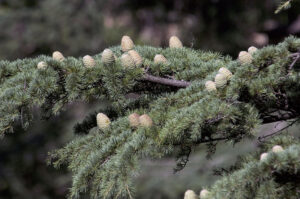
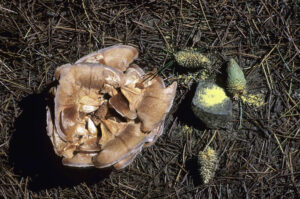

The name Calabrian pine stems from a naturalized population in Calabria, the southernmost part of the Italian Peninsula. When this species was first described, the type specimen was from this region.

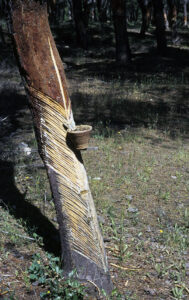
In Ayurvedic medicine, the leaves of chir pine are used as a diuretic, the oil for rheumatic ailments, the resin for inflammations and various skin problems. In Nepal, the resin of chir pine is used for gastric problems, and also applied to cuts and wounds. The Tamang people of Nepal make tea from the resin of chir pine and drink it for cough and chest problems. A similar tea of blue pine is used for wounds.
The seeds are roasted and eaten. In Nepal, honey dew from aphids living on the needles is eaten as candy. The wood is used for timber and furniture, and also to make charcoal. It yields turpentine. Paper, soap, cosmetics, paint, varnish, rubber, polish, and bangles are made from the resin. Tannin from the bark is used for dyeing.
Among the Tamang people, blue pine is used for worship in temples.
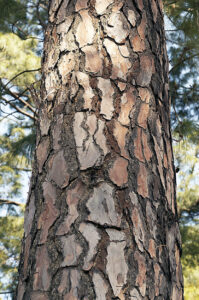


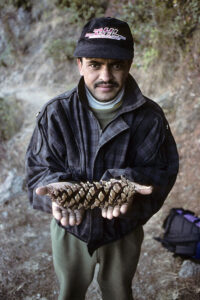
In England, in the old days, it was regarded as a magical herb. The original name of the plant was folk’s glove, the glove of the ‘good folk’, or fairies, and it was believed that fairies lived in the flowers, the dark markings on the inside being their fingerprints. It was also said that fairies taught the fox how to muffle his footprints with foxglove flowers, in this way being able to surprise chickens.
All other common names of the plant, including fairies’ glove, fairy caps, fairy thimbles, gloves of Our Lady, Virgin’s glove, witches’ gloves, bloody fingers, and dead men’s bells, also refer to the flower shape.
In former days, Danish children had fun putting a foxglove flower on a finger as a thimble. It was said that if the flower didn’t break, you would have new clothes within a year. Another game was to pick flower and calyx, squeeze the flower above and then break it on your forehead.
Despite its great toxicity, foxglove was previously much employed by the old herbalists for various purposes, most of them entirely different from the valuable properties, utilized by today’s physicians. In his Cruydeboeck (herb book), Flemish physician and botanist Rembert Dodoens (1517-1585) prescribes foxglove boiled in wine as an expectorant, and it seems to have been in frequent use in cases, in which today’s herbalists would consider it highly dangerous.
English herbalist John Gerard (c. 1545-1612) recommends it to people “who have fallen from high places,” and herbalist John Parkinson (1567-1650) speaks highly of the bruised herb and its juice, applied as an ointment to scrofulous swellings, and the leaves for cleaning old sores and ulcers.
Herbalist Nicholas Culpeper (1616-1654) says of it: “a gentle, cleansing nature and withal very friendly to nature. The herb is familiarly and frequently used by the Italians to heal any fresh or green wound, the leaves being but bruised and bound thereon, and the juice thereof is also used in old sores, to cleanse, dry and heal them. It has been found by experience to be available for the King’s Evil, the herb bruised and applied, or an ointment made with the juice thereof, and so used. (…) I am confident that an ointment of it is one of the best remedies for a scabby head that is.” [Today, King’s Evil is known as scrofula, formerly believed to be curable by the royal touch.]
It was also used for treatment of internal haemorrhage, inflammation, delirium tremens, epilepsy, and acute mania. In England, foxglove tea was traditionally taken for dropsy (fluid retention).
In 1785, English botanist, geologist, chemist, and physician William Withering (1741-1799) found that an extract of foxglove leaves would strengthen the heartbeat, and also speed up discharge of excess fluid in the body. In modern medicine, foxglove is still an important heart stimulant.

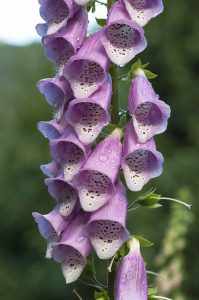
The generic name is derived from the Greek picros (‘bitter’) and rhiza (‘root’), whereas the specific name is derived from karu, the Punjabi name of the plant, which also means bitter.
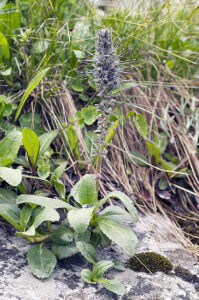
In Denmark, it seems that some species of Veronica were formerly used to generate abortions.
In his book The Popular Names of British Plants, Richard Chandler Prior (1809-1902) states that the name brooklime stems from the fact that this plant often grows in mud of brooks. The Anglo-Saxon word lime is from the Latin limus (‘mud’). In Anglo-Saxon days, houses were built of sun-dried mud, and only later was the word lime applied to the calcareous stone of which mortar is now made.
The specific name is probably derived from the German name of brooklime, Bachbunge, from bach (‘brook’) and bunge (‘bunch’), referring to the fact that this species often grows abundantly in brooks.
Another source claims that the name is from the Flemish beckpunge, meaning ‘smarting mouth’, referring to the pungent leaves, which were formerly eaten in salads in winter and spring, when green vegetables were scarce. During wars between Denmark and Sweden in the 1600s, brooklime contributed significantly to the nourishment of the Danes.
The popular names cow cress and horse cress are derogatory terms for brooklime, indicating its inferiority as salad, and as a medicinal plant, to watercress (Nasturtium officinale, Brassicaceae).
In former days, brooklime was used for many ailments, including tuberculoses, swellings, and gout. The leaves were applied to bruises and burns. Juice from the plant was taken to prevent scurvy.
In Denmark, in the 1400s, a sick midwife was advised to eat brooklime, boiled in pig fat. Danish herbalist Henrik Smid (c. 1495-1563) says that the plant, eaten as salad, will dissolve bladder stones and expel urine, dead embryos, and ‘female impurities’.

Originally, officinalis was derived from officina (‘workshop’, or ‘office’), and the suffix alis, which, together with a noun, forms an adjective, thus ‘made in a workshop’. However, in a botanical context, the word denotes plants species that were sold in pharmacies due to their medicinal properties.
In former times, this species was highly esteemed for treatment of numerous ailments, including congestion, haemorrhage, neurological disorders, infections of the throat, and heart trouble, and as a diaphoretic, diuretic, expectorant, and tonic. It is told that the gout of Emperor Charles V of Spain and Rome (1500-1558) was much relieved due to the use of this herb.
Pregnant women among certain American natives would drink a decoction of the root before setting out on a journey. The same decoction was taken as a sedative and analgesic by people with fever.
A decoction of heath speedwell is still taken today for cough and catarrh and is also an effective remedy for wounds and skin problems. Research has shown that it contains a glycoside, aucuboside, which is thought to be anti-inflammatory.
The tea-like smell of the plant led to its usage as a tea substitute in 19th-century France, where it was called Thé d’Europe.
Heath speedwell, boiled in sulfuric acid, can be used for dyeing, applying a black colour.
Regarding the popular name Paul’s betony, British botanist Adams observes: “It is almost incredible how much confusion and mistake has arisen about these terms. [i.e. Betonica] With respect to the Betonica of Paul of Ægina, the most probable opinion is (…) that it was either the Veronica officinalis, common male speedwell, or the V. serpyllifolia, smooth speedwell.”
Paulus Aegineta (c. 625-690), in English Paul of Aegina, was a Byzantine Greek physician, who wrote a medical encyclopedia.
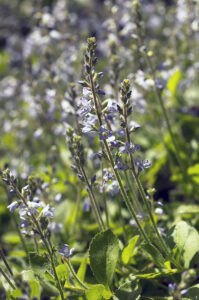
In the Old Testament, Job was a pious man of great virtues, who went through much suffering, as a result of Satan challenging God, saying that he was able to make Job curse God. This made God allow Satan to test Job’s piety through various hardships. Job, knowing that he was innocent, concluded that God must be unjust, but remained faithful to him. The Book of Job, 16:20: “Mine eye poureth out tears unto God.”
This plant is a native of Southeast Asia, but is cultivated elsewhere in the tropics and subtropics. It often becomes naturalized.
The seeds are edible, cooked as grain. In East and Southeast Asia, a nourishing drink is made from powdered seeds, and also an alcoholic drink. Necklaces are made from seeds of hard-shelled varieties. Leaves and stems are used for fodder.
At an early stage, Job’s tears was introduced to the United States. To the Cherokee tribe, its seeds became known as Cherokee corn beads, being used for adornment since at least the time of the foundation of the Cherokee Nation (1794). During the forced removal of c. 16,000 Cherokee, in 1838, from their home lands in south-eastern U.S. to present-day Oklahoma, an estimated 4,000 died. Legend has it that Cherokee corn beads sprang up along the various migration routes, called ‘The Trail of Tears’, or, in Cherokee, Nunna daul Isunyi (‘The Trail Where We Cried’).
The boiled root can expel intestinal worms, and the pounded seeds are used for urinary problems. In traditional Chinese medicine, Job’s tears is taken for diarrhoea, rheumatism, and bronchitis, as a febrifuge, and to promote urination.
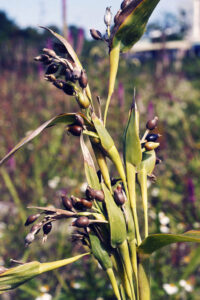
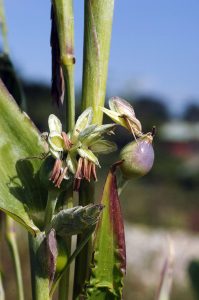
The common name dog’s grass stems from the habit of dogs to chew its leaves in order to procure vomiting. In former days, it was believed that the leaves would cure sick dogs. English herbalist Nicholas Culpeper (1616-1654) says: ”If you know it [couch grass] not by this description, watch the dogs when they are sick and they will quickly lead you to it.”
Greek physician, pharmacologist, and botanist Pedanius Dioscorides (died 90 A.D.), who was the author of De Materia Medica, five volumes dealing with herbal medicine, asserts that a decoction of the rhizomes is a useful remedy as a diuretic and for bladder stones. English herbalist John Gerard (c. 1545-1612) writes: “Although that couch-grasse be an unwelcome guest to fields and gardens, yet his physicke virtues do recompense those hurts; for it openeth the stoppings of the liver and reins without any manifest heat.”
Previously, a decoction of the rhizomes was taken to purify the blood in spring. In Denmark, the juice from fresh rhizomes was utilized for constipation of the liver and spleen, and a decoction of them was used for fever and gall problems. Locally, a decoction was taken daily to prevent ague (malaria), rheumatic fever, intestinal worms, and scrofula.
Today, couch grass rhizomes are crushed and taken with water as a diuretic, and also for bladder infection, bronchitis, laryngitis, kidney stones, and prostrate problems, including benign tumours.
In various countries, including Italy and Denmark, the sugar-containing rhizomes were collected and sold as cattle and horse feed. In Denmark, during famines, they were ground and baked as bread, and ground rhizomes were also utilized in the production of beer and alcohol. Fresh rhizomes were used in green-houses as bast, and rope was made from dried rhizomes.
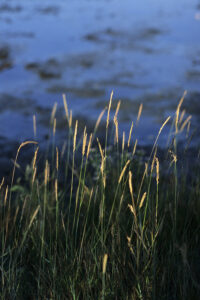
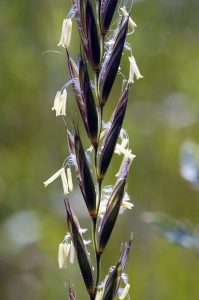
English names include purslane, pursley, and pussley. In his delightful book All about Weeds, American botanist Edwin Spencer (1881-1964) says: “How pursley, purslane, and pussley were derived from Portulaca is rather hard to see. Purslane was probably the first corruption, and it came by the way of the French. An attempt to spell what the Frenchman said, when he pronounced the Latin word Portulaca, brought the word purslane. Then, of course, the English had to modify that, and so pursley and pussley are corrupted purslane.”
In Europe, purslane was eaten as a vegetable since Antiquity, and also by native Americans in pre-Columbian times. Young leaves are excellent in salads, and seeds are ground into a powder and mixed with cereals in bread, pancakes etc. Ash of the burned plant is used as a substitute for salt.
In Ancient Rome, the healing properties of purslane were so highly esteemed that naturalist Pliny the Elder (23-79 A.D.) advised wearing the plant as an amulet to expel all evil. Today, purslane is recommended for treatment of abnormal uterine bleeding. It is antibacterial and antiscorbutic, and is regarded as a diuretic and a febrifuge. A poultice of the leaves is applied to burns, skin diseases, and insect stings. Juice of the leaves is used for earaches. The seeds are utilized as a vermifuge.
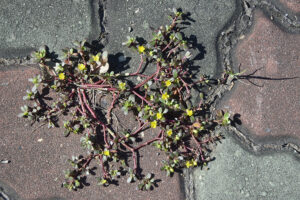
Roman historian Pliny the Elder (23-79 A.D.) stated that loosestrife, added to the hair, imparts a blond tint to it.
For hundreds of years, fresh leaves of moneywort were being used to staunch blood and heal wounds, and the species was also utilized to treat gout. English herbalist Nicholas Culpeper (1616-1654) says: “Moneywort is singularly good to stay all fluxes (…) bleeding inwardly or outwardly, and weak stomachs given to casting. It is very good for the ulcers or excoriations of the lungs.” [‘to stay’ is an old expression for ‘to stop’]
He adds that it is good for treatment of whooping-cough, ”being boyled with wine or honey (…) it prevaileth against that violent cough in children, commonly called the chinne-cough, but it should be chine-cough for it doth make as it were the very chine-bone to shake.”
The generic name is derived from Ancient Greek lysimakhos, from lysis (’release from’) and makhe (’strife’), thus meaning ‘to end a strife’, in English corrupted to loosestrife. In Ancient Greece and Rome, a popular belief was that loosestrife was an effective remedy to calm down furious persons. Pliny the Elder says that if two bullocks start a fight and don’t want to be under the same yoke, you calm them down by placing loosestrife on the yoke.
The specific name, as well as a number of popular names, including twopenny grass and string-of-souvereigns, were given in allusion to the round leaves of this species. Other names, including creeping loosestrife, Creeping Jenny, and Creeping Charlie, refer to its creeping stems. The name serpentaria refers to an old superstition that wounded snakes would lie on top of moneywort to heal their wounds.
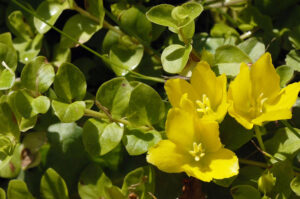
The popular names key flower and Herb Peter refer to the inflorescence, resembling a bunch of keys, which was the emblem of St. Peter. According to legend, St. Peter heard that some people were trying to enter heaven by the back door, instead of the front gates, which were guarded by him. Hurrying towards the back door, he dropped his keys, which took root and became cowslips. German names of the species include Echte Schlüsselblume (‘true key flower’) and Himmelsschlüssel (‘keys of heaven’).
In Norse mythology, the flower was dedicated to Freya, the Key Virgin, a goddess associated with love, beauty, and fertility. When the heathens converted to Christianity, the plant was instead dedicated to Virgin Mary, hence the popular name Our Lady’s keys.
Cowslip has been used medicinally for hundreds of years, among others by Celtic druids. It was utilized as a treatment for rheumatism, paralysis, spasms, and cramps, hence its popular name palsy wort. An oil, extracted from the flowers, was used to treat bruises.
Today, it is recommended for treating hyper-activity and sleeplessness, especially in children. Dried flowers and leaves are used for tea, a fine remedy for restlessness and insomnia. Flowers and root are used as a diaphoretic and diuretic, and as an expectorant for treating bronchitis, laryngitis, fever, cough, and flu.
English herbalist William Turner (1508-1568) mentions the alleged quality of cowslip to banish freckles and wrinkles: ”Some weomen, we find, sprinkle ye floures of cowslip wt whyte wine and after still it and wash their faces wt that water to drive wrinkles away and to make them fayre in the eyes of the worlde, rather than in the eyes of God, whom they are not afrayd to offend.”
This belief probably stemmed from the ‘freckles’ on the cowslip petals. According to the Doctrine of Signatures, Our Lord had put these freckles on the flowers, signifying to people that they could be used to remove freckles.
In A Midsummer Night’s Dream, by William Shakespeare (1564-1616), a mischievous puck, or spirit, Robin Goodfellow, meets a fairy, asking her what she is doing. She says:
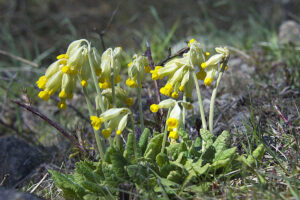
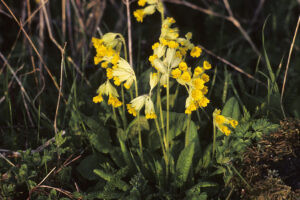
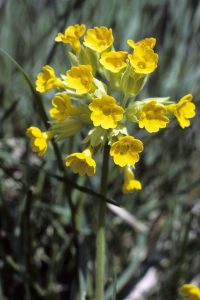
The generic name refers to the mountain Akonitos, near the Black Sea, where the Greek hero Heracles went to the underworld Hades to bring up its guardian, the three-headed dog Kerberos. As he tugged this terrible animal out of Hades, its froth fell on the ground as drops, from which Aconitum sprouted – a figure of the extreme toxicity of the genus.
The common names monkshood and helmet flower refer to the unique flower structure with five coloured sepals, the upper ones forming an erect hood. The name wolf’s bane refers to an old method of killing wolves, either with poisoned arrows or in traps with stakes, smeared in aconite juice.
In Scandinavia, a popular name of monkshood is Chariot of Venus. In Roman mythology, the chariot of goddess Venus was drawn by two doves. Pistil and stamens do look a bit like two doves, harnessed to a chariot.
Various aconite species are described on the page Plants: Flora of the Alps and the Pyrenees.
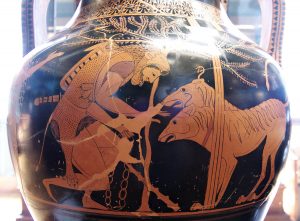
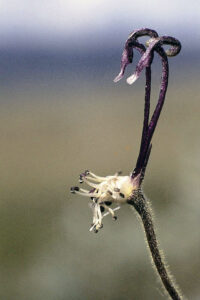
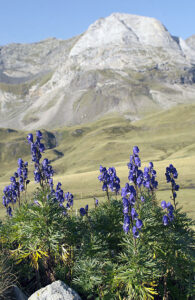
Many other Himalayan aconite species are utilized in local medicine. A paste from the root of A. ferox is applied for neuralgia, leprosy, cholera, and rheumatism. It is also regarded as a diuretic and diaphoretic. In western Nepal, the tuber of A. spicatum is used as an antipyretic and analgesic, and also for sore throat, tonsillitis, and gastritis. In north-eastern India, A. palmatum is utilized by the Naga people. The root is crushed, soaked overnight, and drunk to relieve diarrhoea, dysentery, and rheumatism.
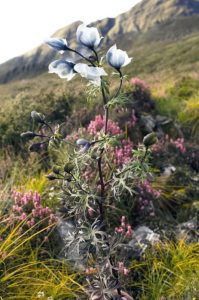
The generic name is derived from Ancient Greek helleboros, which was the name for H. orientalis, possibly constructed from the words helein (‘to injure’) and bora (‘food’), presumably referring to the toxicity of this species.
This pretty plant is among the earliest flowering plants of the Alps, sometimes appearing as early as December, a fact reflected in the popular name Christmas rose and in the German name Schneerose (‘snow rose’). However, it is not even distantly related to roses, but its beautiful flowers slightly resemble roses.
According to an old legend, it sprouted in the snow from the tears of a young girl who had no gift for the newborn Christ in Bethlehem. Snow in Bethlehem! That must be a phenomenon, which occurs once a century!
Another legend states that it used to bloom around the 6th of January, which, according to the old Julian calendar, was Christmas Day. So when the Gregorian calendar was supposed to be introduced around 1588, and the Christmas rose did not bloom around the new Christmas Day (25th December), this was seen as such a frightful omen that the Gregorian calendar was not accepted in England until 1751.
In the Middle Ages, people strewed Christmas rose flowers on the floors in their homes to drive out evil, and to ward off the power of witches. They also blessed their animals with it.
In the traditional folk medicine, black hellebore was used to treat insanity, melancholy, gout, and epilepsy. However, this was very dangerous, as the plant is highly toxic and may cause tinnitus, vertigo, stupor, thirst, a feeling of suffocation, swelling of the tongue and throat, emesis, catharsis, or even death from heart attack.
The specific name probably refers to the colour of the root.
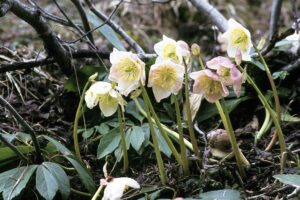
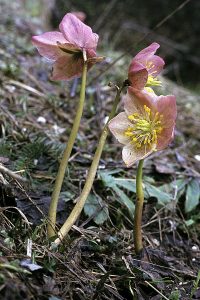
Like all members of the genus, it is very poisonous. Sap coming into contact with the skin causes irritation, while ingestion may cause burning of mouth and throat, vomiting, abdominal cramps, and diarrhoea.
The common name alludes to its early flowering, the Lent being a period of 40 days prior to Easter.
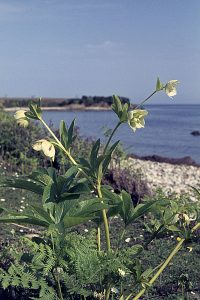
The generic name is a diminutive of rana (’frog’), thus ’little frog’, referring to the fact that many members of the genus grow in marshy areas, where frogs are also found. When left unharmed, many buttercup species may cover huge areas. Grazing animals avoid them, as they contain the toxic anemonol. However, dried as hay, the toxicity disappears.
The name buttercup stems from the butter-yellow flowers of many species, and the tiny ‘cup’, formed by the petals. According to an old belief, cows grazing on buttercups would produce the sweetest and most flavourful milk, rich in cream. Of course, this is pure superstition, as cows avoid these plants due to their toxicity. Rather, the richness of the milk would stem from the succulent grass in the meadows.
An old legend has it that fairies created the buttercups. Once, a group of fairies noticed an old man crossing a field, carrying a sack of gold, and they approached him to ask for alms. The old man, being a miser, refused and continued on his way. However, while the fairies had talked to him, one of them had managed to cut a hole in his sack, and as he continued across the field, coins dropped from the bag, and where they hit the ground, buttercups sprang forth.
Another legend, from the American West, relates that one day, Coyote (a wizard and trickster in many Native American mythologies) was playing with his eyes, tossing them into the air and catching them again. An eagle, however, swooped down, grabbed them and flew away with them. Unable to see, Coyote rummaged about to find something to replace his eyes, stumbling upon buttercups, which became his new eyes. For this reason, the name of buttercups in various Native American languages is ‘Coyote’s eyes’.
In his comedy Love’s Labours Lost, from the early 1590s, William Shakespeare (1564-1616) writes:
A large number of Ranunculus species have white flowers, including the water-crowfoots, which were previously placed in the genus Batrachium, derived from the Greek batrakhos (’frog’), referring to the habitat of these plants, where also frogs live.

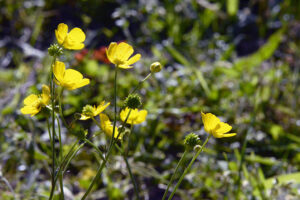
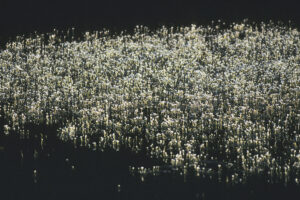
Incidentally, the name lesser celandine is a misnomer. In the early days of classification, certain botanists thought that it was related to the greater celandine (Chelidonium majus, Papaveraceae), and so they named it lesser celandine (Chelidonium minus). For some reason or other, both English names of these entirely unrelated plants stuck.
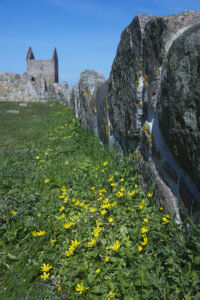

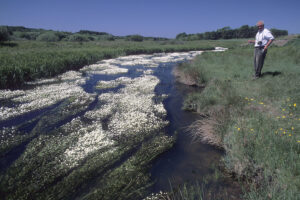

The common name alludes to the leaves, which somewhat resemble those of celery (Apium graveolens). In former days, beggars would smear its caustic juice on their skin to cause blisters, which would evoke pity in people. North American tribes used the plant as a poison for their arrow points.
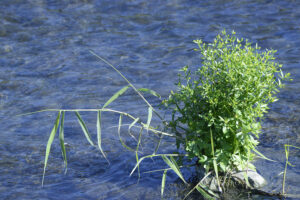
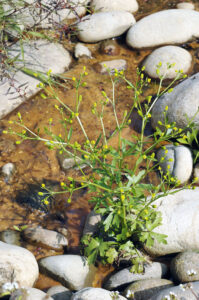
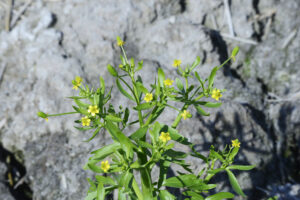
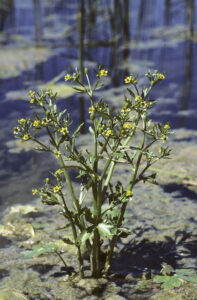
The fruit is taken for various lung ailments, cough, fever, indigestion, and gall bladder problems. The dried fruit is a mild laxative. The seeds are sedative, used for diarrhoea, nausea, vomiting, and dysentery. A poultice of bark, fruits or seeds is applied to wounds and rheumatic areas. A poultice of the leaves is applied for liver problems, asthma, and fever. A decoction of the root is given for fever, to expel tapeworms, and to increase menstrual flow.
The flowers yield honey. The fruits are tasty, eaten cooked, dried, candied, pickled, or as so-called ber butter. They are a common ingredient in Chinese dishes. A beverage is also made from them, being very rich in vitamin C, second only to guava (Psidium guajava). Ripe fruits are dried in the sun, ground, and kept for out-of-season. In Ethiopia, the fruits are used as fish poison. The wood is hard, yielding excellent timber, which is utilized for boats, tools, legs for bedsteads, and as well-lining. It is also used as firewood and makes good charcoal. In certain African countries, the thorny shrubs are made into corral fences to protect livestock. The seed oil can be utilized as excellent bio-diesel.
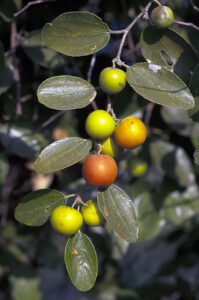
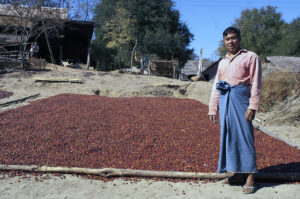
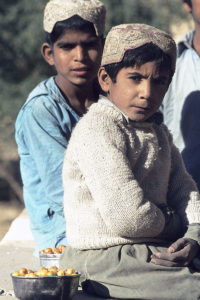
Despite its medicinal properties, agrimony is not known to cure eye diseases, so why the generic name was applied to it is uncertain. The specific name was given in honour of King Mithridates VI of Pontus (134-63 B.C.), called Eupator Dionysius (which can be translated as ‘the noble father of plants’), who was a renowned herbalist.
A common name of the plant, church steeples, refers to the long, spire-like inflorescence, whereas cocklebur and sticklewort alludes to the prickly fruits, which easily detach when in contact with socks, sweaters, animal furs, etc.
Roman naturalist Pliny the Elder (23-79 A.D.) calls agrimony an “herb of princely authority,” whereas Greek physician, pharmacologist, and botanist Pedanius Dioscorides (died 90 A.D.), who was the author of De Materia Medica (five volumes dealing with herbal medicine), states that it is not only “a remedy for those that have bad livers,” but also “for such as are bitten by serpents.”
English herbalist John Gerard (c. 1545-1612) says: “A decoction of the leaves is good for them that have naughty livers,” whereas another herbalist, Nicholas Culpeper (1616-1654), recommends it, in addition to the uses above, for gout, “either used outwardly in an oil or ointment, or inwardly, in an electuary or syrup, or concreted juice.” He praises its use externally, stating how sores may be cured “by bathing and fomenting them with a decoction of this plant,” and that it heals “all inward wounds, bruises, hurts and other distempers.” He continues: “The decoction of the herb, made with wine and drunk, is good against the biting and stinging of serpents . . . it also helpeth the colic, cleanseth the breath and relieves the cough. A draught of the decoction taken warm before the fit first relieves and in time removes the tertian and quartian ague.” [Ague is an old term for malaria.] And furthermore: “Agrimony draweth forth thorns, splinters of wood, or any such thing in the flesh. It helpeth to strengthen members that are out of joint.”
In his compendium The Vegetable System, English botanist John Hill (c. 1714-1775) recommends “an infusion of 6 oz. of the crown of the root in a quart of boiling water, sweetened with honey and half a pint drank three times a day,” for jaundice.
Agrimony is tonic, diuretic, and astringent (thus good for diarrhoea), and is still regarded as a very useful agent in skin eruptions, pimples, and diseases of the blood. A strong decoction of the root and leaves, sweetened with honey or sugar, has been taken successfully to cure scrofulous sores and ulcers. It has also been used for gallstones.
The magic powers of agrimony are mentioned in an old English medicinal manuscript:
Agrimony contains tannin and was previously used in dressing leather. Tea was made from the flowers, and an old remedy from 1632 says that dried agrimony prevented beer from turning stale. Sheep and goats will eat this plant, whereas cattle, horses, and pigs leave it untouched.
A close relative, hairy agrimony (A. pilosa), is utilized in Nepal for a number of ailments, including diarrhoea, dysentery, haemorrhoids, and tuberculosis. A paste of the plant is applied to the head to relieve headache, and also used for snakebites. Ash from the plant is a remedy to treat wounds. In traditional Chinese medicine, it is used to cure bloody stool or urine, and to curb profuse menstruation.
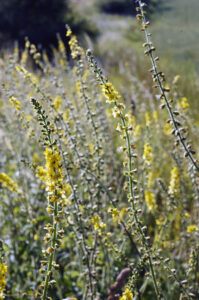
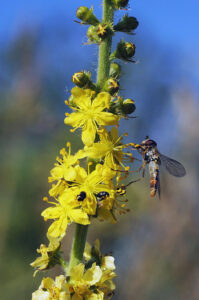

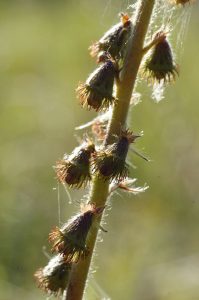
The generic name is derived from the Arabic alkemelych (‘alchemy’), applied to the plant in allusion to its reputation as a magical herb. The popular name lady’s mantle stems from the shape of the leaves, resembling the scalloped edges of a lady’s mantle. The leaf shape also resembles the imprint of a lion’s paw or a bear’s paw, giving rise to the folk names lion’s foot and bear’s foot. The name nine hooks refers to the margin of the leaf, which has mostly nine lobes, with finely toothed margins.
Lady’s mantle is a traditional astringent herb, formerly considered one of the best herbs for wounds. English herbalist Nicholas Culpeper (1616-1654) says: “Lady’s mantle is very proper for inflamed wounds and to stay bleeding, vomitings, fluxes of all sorts, bruises by falls and ruptures. It is one of the most singular wound herbs and therefore highly prized and praised, used in all wounds inward and outward, to drink a decoction thereof and wash the wounds therewith, or dip tents therein and put them into the wounds, which wonderfully drieth up all humidity of the sores and abateth all inflammations thereof. It quickly healeth green wounds, not suffering any corruption to remain behind and cureth old sores, though fistulous and hollow.” [‘To stay’ is an old expression for ‘to stop’.]
In former days, in Sweden, a tincture of the leaves was given for spasmodic or convulsive diseases. An old authority states that if placed under the pillow at night, the herb will promote quiet sleep.
In modern herbal treatment, it is employed to curb profuse menstruation.
In Denmark, around 1800, lady’s mantle was eaten as a vegetable or in salads. It was also used for dyeing yarn, applying olive-green or yellow.
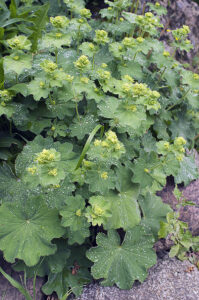
The prefix haw is an old word for ‘enclosure’ or ‘hedge’, and hawthorn was formerly widely used as a hedge plant. The name whitethorn arose from the whiteness of the bark, whereas the name mayflower refers to the main blooming time of these plants. Incidentally, the first ship to bring English settlers to North America, in 1620, was named Mayflower.
Formerly, it was widely believed that hawthorn flowers bore the smell of the Great Plague of London (1665-1666), and witches were said to hide among its foliage. Others regarded the hawthorn as sacred, probably from a belief that it furnished the Crown of Thorns that Jesus was wearing at the Crucifixion.
In the old days, a liqueur was made from hawthorn berries with brandy. Small tools and other items were carved from the hard wood, which also makes excellent fuel.
The famous Glastonbury Thorn in Somerset, England, is a form of common hawthorn, which blooms twice a year, in winter, and again in spring, hence its name C. monogyna cv. ‘Biflora’ (meaning ‘double-flowering’). This tree is associated with the introduction of Christianity in Britain, and, as legend has it, the original thorn tree sprouted from the staff of Joseph of Arimathea, who, according to the four Gospels, was the person that took care of the burial of Jesus after the Crucifixion. In the Middle Ages, his name was connected with Glastonbury, where he supposedly founded the earliest Christian oratory in England.
From old times, flowers and fruits have been used for fever, heart trouble, and high blood pressure. In the 1800s, an Irish physician, Dr. Green, became famous for his secret remedy for heart disease. After his death, it turned out that his tincture was based on hawthorn fruits.
Today, hawthorn is recommended as a cardiac, diuretic, astringent, and tonic. It is a useful diuretic in dropsy and kidney troubles, and also a good remedy for poor blood circulation. Research has shown that hawthorn berries can lower the blood pressure by dilating hardened and clogged arteries. Flowers and berries are also used for sore throat.
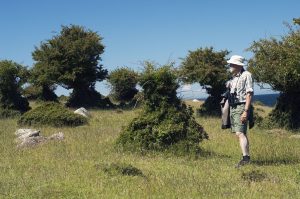
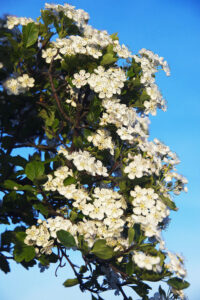
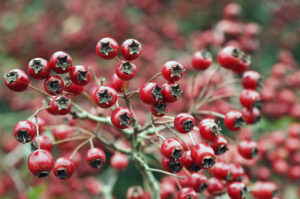
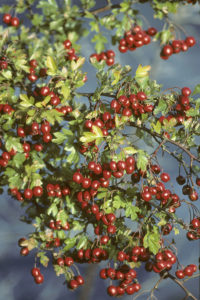
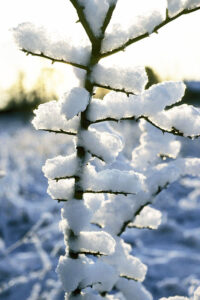
Even today, root and leaves are used for diarrhoea, and also for treating menopause problems and menstrual cramps. Tea, made from the leaves, checks dysentery.
Strawberries are eaten raw, with milk or cream, or as jam. In a play from 1603, English poet Ben Jonson (1572-1637) says:
A pleasant tea can be made from the leaves. An old English recipe says: “Gather strawberry leaves on Lamas Eve, [August 1] press them in the distillery until the aromatick perfume thereof becomes sensible. Take a fat turkey and pluck him, and baste him, then enfold him carefully in the strawberry leaves. Then boil him in water from the well, and add rosemary, velvet flower, lavender, thistles, stinging nettles, and other sweet-smelling herbs. Add also a pinte of canary wine, and half a pound of butter and one of ginger, passed through the sieve, besides plums and stewed raisins and a little salt. Cover him with a silver dish cover.”
Both leaves and fruits of woodland strawberry were used early in herbal medicine. The fruit was considered invaluable for fever, and it was also recommended for stone. Danish herbalist Henrik Smid (c. 1495-1563) claims that lepers with “a red face and warm blood” can live for a long time, if they drink strawberry water on a daily basis, whereas English herbalist Nicholas Culpeper (1616-1654) declares that strawberry is “singularly good for the healing of many ills.” Swedish naturalist Carl Linnaeus (1707-1778) discovered that the berries were an effective cure for gout, and in Denmark, a poultice of the leaves were used for the same ailment.
During World War I, the leaves were smoked as tobacco. The entire plant has been used for tanning.
The word strawberry is derived from the verb to strew, in allusion to the dense tangle of the plant’s stems, creeping over the ground.
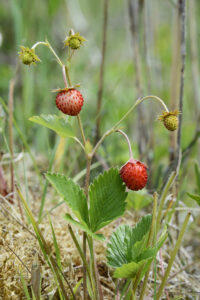
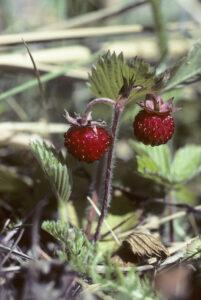
In his travelogue Travels Through North & South Carolina, Georgia, East & West Florida, the Cherokee Country, the Extensive Territories of the Muscogulges, or Creek Confederacy, and the Country of the Chactaws; Containing An Account of the Soil and Natural Productions of Those Regions, Together with Observations on the Manners of the Indians, from 1791, American naturalist William Bartram (1739-1823) notes about this species:
“(…) and having gained its summit, enjoyed a most enchanting view, a vast expanse of green meadows and strawberry fields; a meandering river gliding through, saluting in its various turnings the swelling, green, turfy knolls, embellished with parterres of flowers and fruitful strawberry beds; flocks of turkies strolling about them; herds of deer prancing in the meads or bounding over the hills; companies of young innocent Cherokee virgins, some busily gathering the rich fragrant fruit, others having already filled their baskets, lay reclined under the shade of floriferous and fragrant native bowers of Magnolia, Azalea, Philadelphus, perfumed Calycanthus, sweet Yellow Jessamine and cerulian Glycine frutescens, disclosing their beauties to the fluttering breeze, and bathing their limbs in the cool fleeting streams; whilst other parties, more gay and libertine, were yet collecting strawberries or wantonly chasing their companions, tantalising them, staining their lips and cheeks with the rich fruit.”
In Nepal, juice of the root is taken for fever, whereas juice of the entire plant is used for inflammation of nerves and lungs, and to curb profuse menstruation. Unripe fruits are chewed to cure blemishes on the tongue. A paste of the fruit is applied to skin diseases and wounds.
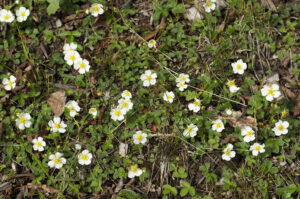
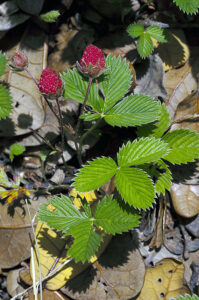
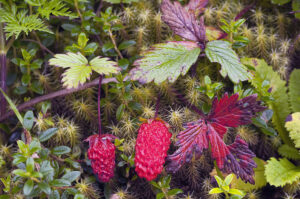
Almonds are antibacterial and anti-inflammatory, and they reduce the risk of cancer, dementia, and Alzheimer, and lower cholesterol levels in the blood. They are also an aid in weight loss, and the juice may be used for chapped lips. They also act as a mild laxative. Formerly, they were taken as an aphrodisiac.
Almonds come in two varieties. Bitter almonds, var. amara, contain amygdalin, a glucoside. When ingested, this glucoside is split into three substances: glucose, bitter oil, and the highly toxic Prussic acid. Fatal dosage of Prussic acid is c. 1 mg/kg body weight, so ingestion of many bitter almonds is very risky.
Sweet almonds, var. dulcis, however, contain very little amygdalin, and they are delicious, used in cookies, desserts, Mughal curries, and to make syrup. They contain up to 50% oil, utilized as edible oil and in the production of marzipan. The oil, and the residues after pressing, are used in the cosmetic industry.
In the Hebrew Tanakh, the almond was a symbol of promise due to its early flowering, and in the Christian Bible it is mentioned ten times, beginning with Genesis, 43:11, where it is described as “among the best of fruits.”
According to legend, the rod of Aaron bore sweet almonds on one side and bitter on the other; if the Israelites followed the Lord, the sweet almonds would ripen, but if they were to forsake the path of the Lord, the bitter ones would predominate.
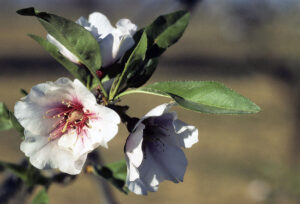
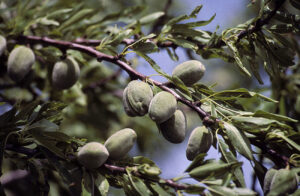
Like other names, including the German Kirsch and the Italian cerasa, the English name cherry stems from the Latin cerasus, which was adopted from the Greek kerasos, the ancient Greek name of the cherry tree. Cerasus was also the ancient Roman name of the modern town Giresun, situated on the Black Sea coast of Turkey, from where cherries during the Roman Era were exported to Rome. The specific name avium, from the Latin avis (‘bird’), relates to the fact that various bird species love cherries.
In his book Flora Danica, from 1648, Danish physician and herbalist Simon Paulli (1603-1680) states that young girls apply cherry resin to a piece of cloth, moisten it in water and rub their curly hair with it, to avoid it becoming dishevelled.
The delicious fruits are an ingredient in countless cakes and desserts, and much utilized to make jam and wine. A kind of liqueur is made from an extract of berries and crushed stones. The wood is very durable, utilized for many items, including furniture, violins, and pipes, and formerly also for parts of windmill machinery.
Bark, leaves, and stones contain amygdalin (see Prunus amygdalus below). Formerly, the leaves were used for tea, and in war times they were crushed to make a substitute for tobacco.
In his book Det tabte Land (’The Lost Land’), from 1919, Danish poet Johannes V. Jensen (1873-1950) describes the cherry tree thus: ”Each tree is like a white-clad cupola, full of coolness, sweetness, and sunshine, the entire tree a single sound of all the humming, dizzy bees – a wonder of light, a sphere of bliss.”
A traditional advice says that cherries are a good remedy for gout, and, in fact, a modern Norwegian experiment has shown that cherries do indeed speed up excretion of uric acid. The level of uric acid in the blood of ten healthy women fell about a fifth after ingestion of cherries. The dark red colour of sour cherries and red morellos stems from antocyanins, and research indicates that these substances can prevent rheumatism, diabetes, and colon cancer. Antocyanins are also excellent anti-oxidants, which can subdue infections.
The generic name is a Latinized form of prounos, the Greek name of the plum tree.

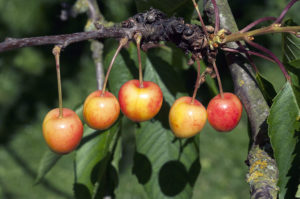
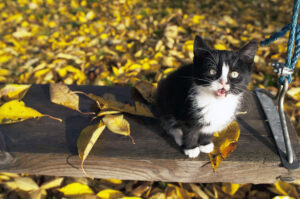
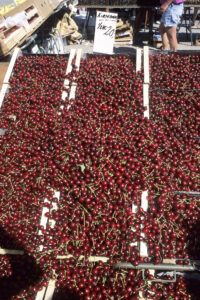
In his book Myter VI: Pisangen, from 1932, Danish poet Johannes V. Jensen (1873-1950) describes rowan in this way: ”The loveliest tree, no fragrance is like a flowering rowan after rain – cool, sweet, tasty, the most beautiful breath in the world.”
Through the ages, rowan wood has been utilized for many purposes. Remains of a funnel-shaped cup, carved from rowan wood, dating back to the Stone Age (c. 5400-3900 B.C.), was found north of Copenhagen, Denmark. From the Bronze Age, vessels with sticks of rowan wood stuck through the ears, have been found.
Later, numerous items were made from rowan wood, including planks, chariots, wheel spokes, bridles, and pipes, while the bark has been used for tanning and dyeing, giving a reddish-brown colour. The fruits make an excellent jelly. Formerly, they were also used in Northern Europe to produce a strong spirit and wine, and the Welsh made beer from them.
The fruits are spread by birds, and sometimes seeds sprout in straw roofs or atop pruned trees. These epiphytes are called flying-rowan, and they were formerly believed to possess magical powers. In his book The Golden Bough (1890), Scottish anthropologist James George Frazer (1854-1941) writes that they were supposed to be “exceedingly effective against witchcraft: since it does not grow on the ground, witches have no power over it. If it is to have its full effect, it must be cut on Ascension Day.”
Wearing a necklace of rowan berries would protect women against influence of witches. It was also a custom to tie twigs of rowan over stable doors to protect livestock from evil spirits. In Denmark, it was said that if an apple tree was grafted on a rowan, and a pregnant woman would eat its apples, she would not be able to deliver. It was also believed that if a witch threw rowan berries to a cow, and it would eat them, or just lick on them, it would have a miscarriage.
As the content of vitamin C in rowan fruits is high, they were formerly taken to prevent scurvy. They were also utilized for other ailments, including diarrhoea, arthritis, and dysentery, and the bark was used for malaria. In modern herbal medicine, they are used for sore throat and laryngitis, and, due to their astringent properties, as a remedy for haemorrhoids and strangury. A decoction of the bark is given for diarrhoea and leucorrhoea (vaginal discharge).
The popular name mountain ash stems from the similarity of rowan leaves to the leaves of ash (Fraxinus excelsior).
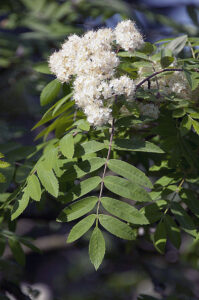
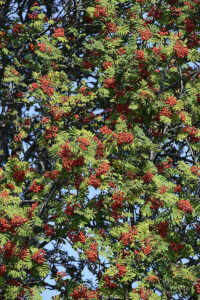
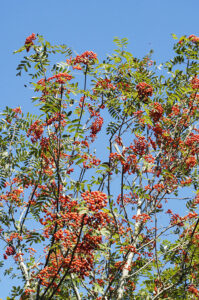
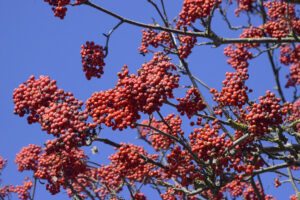
In Norse religion, this plant was dedicated to Frigg, goddess of knowledge, love, and marriage, who was also protector of women giving birth. It was a custom to line the childbed with this fragrant herb. When Christianity was introduced, this heathen habit was banned, but as it persisted, the Church decided to dedicate yellow bedstraw to Virgin Mary instead, claiming that this herb was lining the crib of the newborn Jesus, hence the folk name Our Lady’s bedstraw. It was also stuffed into mattresses, from which the coumarin of the drying plants would emit a pleasant fragrance. As coumarin is toxic, it would also expel fleas and lice.
Another popular name of this species is cheese rennet, as the flowers are able to coagulate milk to make cheese. In his book Herbal Simples, Dr. William T. Fernie (1830-1914) writes: “The people in Cheshire, especially about Nantwich, where the best cheese is made, do use it [yellow bedstraw] in their rennet, esteeming greatly of that cheese above other made without it.”
The name of the entire genus, Galium, from the Greek gala (’milk’), also refers to the usage of yellow bedstraw in rennet.
Flowers and roots are used for dyeing, the flowers giving yellow colour, the roots red. Dr. Fernie (see above) states that yellow bedstraw was named maid’s hair, because, during the reign of Henry VIII, “maydens did wear silken callis to keep in order their hayre, made yellow with dye.” – In Denmark, flowers are added to alcohol to give flavour and colour.
In his book from 1745, Carl Linnæi Öländska och Gotländska Resa förrättad År 1741, the famous Swedish naturalist Carl Linnaeus (1707-1778) relates the following case of superstition from his journey to Öland and Gotland in 1741: ”As regards Galium luteum, the locals told us that it was often strewn on the floor during fiests, but always with the unfortunate result that the guests began arguing and fighting. As a physicus, I am unable to explain the reason for this, but as a logicus, I use the following syllogism [logical argumentation]: Galium is only strewn on the floor during fiests. In these parts (as in other places), people always get drunk during fiests. When people get drunk, they always start arguing and fighting. Consequently, Galium causes squabble.”
In former times, yellow bedstraw was thought to be an efficient healer of epilepsy, hysteria, and arthritis, and it was utilized as a diuretic. English herbalist John Gerard (c. 1545-1612) writes: “An ointment is prepared which is good for anointing the weary traveller.” Another herbalist, Nicholas Culpeper (1616-1654) recommends a decoction of yellow bedstraw to stop nose-bleed and internal bleeding. In Denmark, in the 1600s, it was believed that scabies and scab could be cured with this herb.
Today, yellow bedstraw is a popular remedy for urinary problems, and for bladder and gall stones. In France, it is still being used for treatment of epilepsy.
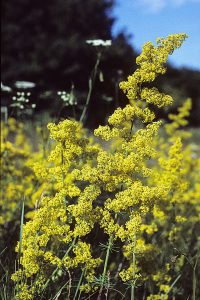
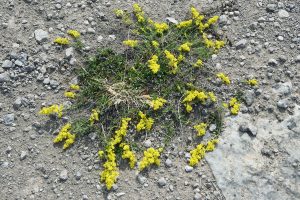
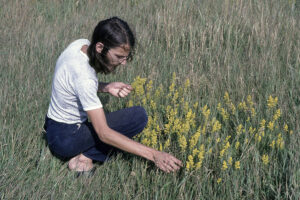
Delicious juice is made from many species, notably orange (Citrus x sinensis), lemon (C. limon), and lime (C. aurantiifolia). Marmalade is produced from various species, mostly bitter orange (C. aurantium var. amara) and bergamot orange (C. bergamia). Pulp from the production is used as cattle feed.
The rind of several species contains essential oils, used in the perfume industry. In Vietnam, perfume is made from flowers of pomelo (C. maxima). An essential oil of bergamot orange is added as flavouring to two tea varieties, Earl Grey and Lady Grey, and also to various types of sweets, including Turkish Delight. In Sweden and Norway, this oil is often added as flavouring to snus, a popular tobacco product. In Italy, a liqueur named Liquore al Bergamotto, is derived from bergamot.
A rather grotesque variety of cedrat (C. medica) is var. sarkodactylis, in daily speech called Buddha’s Hand due to the shape of the fruit. It is utilized to add fragrance to clothing etc. Lemon juice is used as bleach, and to remove stains, whereas juice of leech lime (C. hystrix) is utilized as an insecticide. Tool handles are made from pomelo wood.
All Citrus species are an excellent source of various vitamins, especially vitamin C. In the days of Vasco da Gama (1460s – 1524) and Ferdinand Magellan (c. 1480-1521), up to 80% of the sailors on board sailing ships died of scurvy, by Sir Richard Hawkins (1562-1622) called “the plague of the Sea, and the Spoyle of Mariners.” As a preventive, captains began to bring ample provisions of vinegar, mustard, malt, and sauerkraut, which were a quite effective means to prevent outbreaks of the dreaded disease. Later, British ships were required by law to bring lemons or limes, which are even more effective against scurvy, on their journeys.
In today’s herbal medicine, leaves, flowers, fruits, and seeds of various Citrus species are used for various ailments, including colds, fever, cough, asthma, tonsillitis, and stomach disorders. Lemon peel helps relieve varicose veins. The fruit of cedrat is used for dysentery, juice of the rind of bitter orange for stomach problems. Dried peel of unripe fruits of ‘Buddha’s Hand’ citron is taken as a tonic. An essential oil from bergamot orange is recommended for treatment of shingles. In former times, lemon juice was used as a remedy for sunburn. In southern Italy, juice of bergamot orange was utilized for malaria.

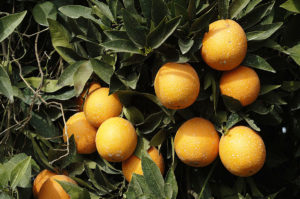
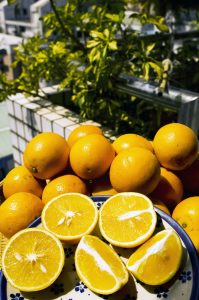
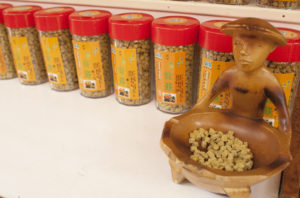
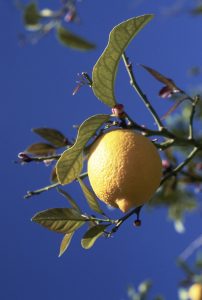
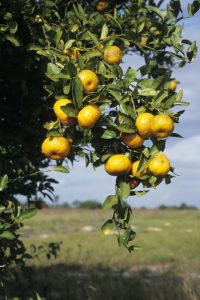
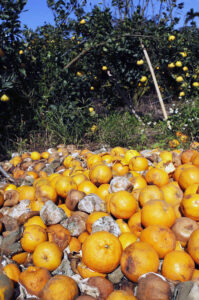
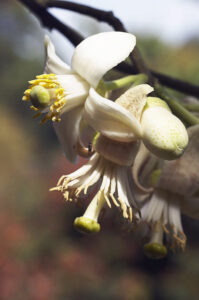
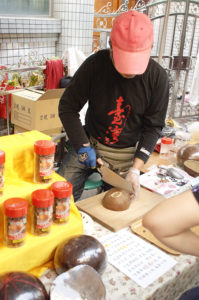
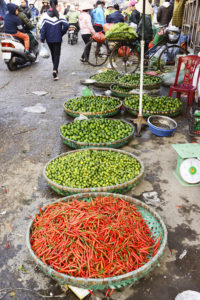
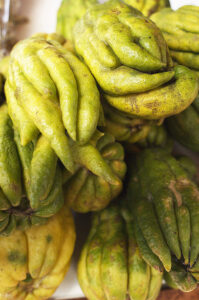
Rue was much utilized by the Ancients. Greek physician Hippocrates of Kos (c. 460-370 B.C.) recommended it, and it was a major ingredient of an antidote to poison, used by Mithridates VI of Pontus (134-63 B.C.). Roman naturalist Pliny the Elder (23-79 A.D.) stated that rue made the eye sight sharp and clear, especially when the vision had become dim through over-exertion of the eyes, and painters of his time would devour a great quantity of it. In the Middle Ages, monks who were copying manuscripts in dim light would also use it.
Tacuinum Sanitatis, a medieval handbook on wellness, which was based on the تقويم الصحة (Taqwīm as‑siḥḥah, or ‘Maintenance of Health’), an Arab medical treatise, written by a Christian physician, Ibn Buṭlān (died 1068), states that rue has the following properties: “Its nature is warm and dry in the third degree. Its optimum is when grown near a fig tree. Its medical usage is that it sharpens the eyesight and dissipates flatulence. Its dangers are that it augments the sperm and dampens the desire for coitus. This can be neutralized by consuming foods that multiply the sperm.” [The expression “grown near a fig tree” alludes to the fact that rue prefers to grow in slightly shady places.]
In Denmark, in the 1400s, leaves of rue and laurel were crushed and mixed with earthworms and vinegar, and this ointment was applied to the forehead to treat headache. In the 1500s, a mixture of crushed rue and dog shit was applied to bubos (plague boils). In 1625, Pietro Piperno, a Neapolitan physician, recommended rue for epilepsy and vertigo, and if you were suffering from the former, you should wear this herb around your neck.
English herbalist John Gerard (c. 1545-1612) writes: “If a man be anointed with the juice of rue, the poison of wolf’s bane, mushrooms, or todestooles, the biting of serpents, stinging of scorpions, spiders, bees, hornets and wasps will not hurt him.”
English herbalist Nicholas Culpeper (1616-1654) recommends an ointment of rue for sciatica and pains in the joints, and the juice for “the shaking fits of agues [malaria], to take a draught before the fit comes.” He also says that ”the juice thereof warmed in a pomegranate shell or rind, and dropped into the ears, helps the pains of them. The juice of it and fennel, with a little honey, and the gall of a cock put thereunto, helps the dimness of the eyesight.”
In Denmark, in the early 1800s, a mixture of rue and honey was applied to the umbilicus to expel intestinal worms.
In today’s herbal medicine, rue is considered to be stimulating and antispasmodic, and is often employed, in form of a warm infusion, as an efficient remedy for menstrual flow. It is also used for headache connected with over-exertion, rheumatism, sprains, gall bladder problems, hysteria, cough, colic, and flatulence. Externally, an ointment of bruised leaves will ease the severe pain of sciatica. A strong decoction of the plant, when applied to the chest, is useful for chronic bronchitis.
Formerly, the leaves were used by farmers to treat croup in poultry, and also various cattle diseases.
Rue was widely used in Ancient Roman and Middle East cuisines, and today leaves and berries are an important ingredient in Ethiopian cuisine. Rue is used as a flavouring in Greek, Croatian, Italian, and other cuisines, and it was once also used as flavouring in beer and vinegar. Porridge can be made from the seeds.
In many parts of Europe, during the Middle Ages, rue was considered a powerful defence against witches, and it was often used in spells. Later, judges would carry rue to protect them from contagious ‘jail fever’ (typhoid). – An old word says that rue-water, sprinkled in the house, would rid it of fleas.
Formerly, at the ceremony usually preceding the Sunday High Mass, the holy water was sprinkled from brushes made of rue – hence its popular names Herb of Grace and Herb of Repentance. The generic name Ruta is from the Greek reuo (’to set free’), in allusion to the herb being an effective remedy for various diseases.
Today, the species is widely cultivated as an ornamental. Cats dislike its smell and therefore avoid it, so if you dislike cats, plant rue in your garden! It is also used as an insect repellent, and in South India it is recommended as a snake repellent.
In Hamlet, by William Shakespeare (1564-1616), rue is one of the flowers distributed by the mad Ophelia:
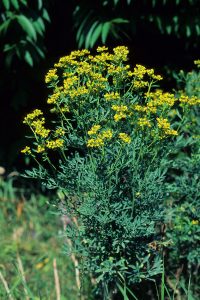
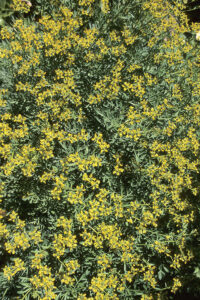
The name mistletoe is from Old Germanic, mistel (‘dung’) and tan (¨twig¨), thus ‘the twig in the dung’, which aptly describes seeds of these plants, sprouting in a bird dropping, which has been left on a branch.
To the Celtic druids, mistletoes, which grew on the sacred oak trees, possessed the power of the oaks, and they played a role in their religious rituals. Mistletoes were only collected when the druids had visions, directing them to seek it. Carrying mistletoe branches, young men would walk around, announcing the coming of the new year.
This custom was probably taken over by the British, and even after the introduction of Christianity it was preserved in a different form. On New Year’s Eve, branches of mistletoe were cut, adorned with fruits and brightly coloured ribbons, and hung from a beam at midnight, after which young men would lead young maidens beneath the mistletoe and wish them Happy New Year with a kiss.
In Brittany, mistletoe is called Herbe de la Croix. According to an old legend, the Cross of Christ was made from its wood, which caused it to be degraded to a parasite.
In Norse mythology, the god of love, Balder, son of Odin and Frigg, was troubled by ominous dreams, so his mother made all living and inanimate things swear that they would not harm him. The other gods tested the oath by shooting arrows and hurling stones at him, but he remained unscathed. However, Frigg had neglected to ask the mistletoe. This was noted by the evil and cunning Loke, who made an arrow from it and persuaded Balder’s blind brother Höðer to fire it at him, killing him.
Formerly, in its entire area of distribution, birdlime was made from the gluey berries, giving rise to the popular name birdlime. This lime was utilized to catch thrushes and other small birds – a practice still taking place in the Middle East and the Himalaya. Soap was produced from the berries in the 1800s.
Ripe fruits are much relished by birds. In Nepal, people also eat the ripe fruits, but elsewhere they are considered to be toxic. In Croatia, mistletoe is an ingredient in a local liqueur, named biska.
Traditionally, mistletoe has been used for internal haemorrhage, insomnia, tinnitus, apoplexy, and epilepsy. Formerly, in Sweden, persons afflicted with epilepsy would carry a knife with a mistletoe handle to ward off fits.
Today, it is used for high blood pressure, and as a nervine, antispasmodic, and tonic. New research seems to indicate that it may benefit people with cancer. – In Nepal, a paste of the plant is used for bruises, wounds, boils, sprains, and dislocated bones. Juice of the bark is applied to muscular swellings.
Other species of mistletoe are described on the page Plants: Parasitic plants.
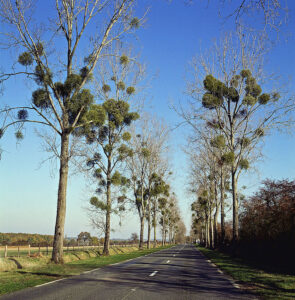
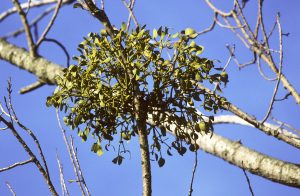
The wood is utilized for furniture, cups, bowls, rifle stocks, etc., whereas the leaves are used for wrapping fruit, making it more durable. Over-exploitation of the timber for commercial and local use has caused the species to decline, especially in Pakistan. (Source: IUCN Red List of Threatened Species, iucnredlist.org)
In Nepal, juice of the bark is applied to swellings of muscles, and also to boils and pimples.

In Ayurvedic medicine, balloon vine is used for treatment of arthritis, inflammation, constipation, and abdominal pain. A decoction of the leaves is used for dandruff. In Nepal, juice of the plant is utilized for numerous ailments, including fever, muscular swellings, sprains, dropsy, gonorrhoea, haemorrhoids, rheumatism, and asthma. A decoction of the leaves is taken for diarrhoea and dysentery. The root is used as an emetic, laxative, demulcent, stomachic, and rubefacient. Seeds are used for fever and rheumatism.
The Chepang people of Nepal eat the tender parts as a vegetable.

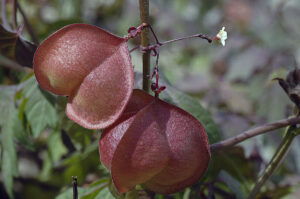
In traditional Chinese medicine, this plant is called 魚腥草 (‘fishy-smelling herb’). It is utilized due to its antibacterial and antiviral effects, mainly for various respiratory diseases, including bronchitis and pneumonia, and also for herpes simplex and for urinary tract infections. As a paste, it is applied to various skin problems. In Japan, a decoction of the dried leaves is drunk to detoxify the body and to kill harmful bacteria. In Nepal, juice of the root is used for indigestion and skin ailments, and it is dripped into the eyes in case of eye problems. Juice of the plant is applied to wounds of domestic animals to rid them of maggots and to accelerate healing. Elsewhere, it is used for diabetes, and as a diuretic.
Tender parts and root are cooked in soups or as a vegetable, and the leaves are pickled.
In Australia and the United States, this species has become invasive in some places.
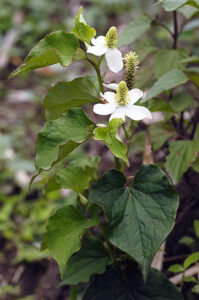
This species is generally regarded as anti-inflammatory and anti-diabetic and may also be good for treatment of cancer. In Nepal, juice of the plant is taken for urinary disorders, and juice of the rhizome is used for cough, colds, haemorrhoids, asthma, and urinary disorders. A paste of the rhizome is utilized for fever, colic, diarrhoea, and backache, and is also applied to boils. Juice of the leaves is dripped into the ears in case of earache. The Gurung tribe of Nepal drink a decoction of the rhizome for gout, and to improve digestion.
In Nepal, boiled flowers are pickled, and tannin is obtained from the root.
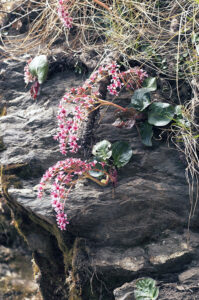
In his book The Popular Names of British Plants, Richard Chandler Prior (1809-1902) states that the word mullein was moleyn in Anglo-Saxon, and malen in Old French, derived from the Latin malandrium, i.e. the malanders, or leprosy, and continues: “The term malandre became also applied to diseases of cattle, to lung diseases among the rest, and the plant being used as a remedy, acquired its names of mullein and bullock’s lungwort.”
The names Aaron’s rod, Jacob’s staff, and others, refer to the long spikes. Presumably, the person naming the plant Aaron’s rod, found that the spike resembled the rod used by Aaron, brother of Moses, when he performed miracles in Egypt.
According to legend, witches used lamps and candles with mullein wicks, giving rise to the name hag’s taper, although ‘hag’ may be derived from Anglo-Saxon haege or hage (‘hedge’), perhaps implying that the long spike resembled a tall candle, growing in the hedge – hence the name Our Lady’s candle. In his book A niewe Herball (1578), English botanist and antiquary Henry Lyte (1529?-1607) tells us that the “whole toppe, with its pleasant yellow floures, sheweth like to a wax candle or taper, cunningly wrought.”
Herbalist John Parkinson (1567-1650) says: “Verbascum is called of the Latines candela regia, and candelaria, because the elder age used the stalks dipped in suet to burne, whether at funeralls or otherwise.” The name clown’s lung wort refers to its use as a remedy for chest problems, whereas wild ice-leaf presumably refers to the greyish leaves, shining like ice, when the sunlight is at a certain angle. ‘Dock’ is a term applied to various plants with large leaves, in this case in the name velvet dock.
In the old days, the long spikes were dried and dipped in tallow to make torches, hence its popular name torches. When dry, the down on leaves and stem makes excellent tinder, and before the introduction of cotton it was used for lamp wicks, hence the name candlewick plant.
In Europe, as well as in Asia, the power of driving away evil spirits was previously ascribed to mullein, and in Denmark it was a believed that root and flowers were able to drive away rats and mice.
The seeds are slightly narcotic, formerly being used for fishing in Europe, a usage that is still practiced in Nepal. In Denmark, the seeds were utilized to poison mice.
English herbalist John Gerard (c. 1545-1612) remarks: “There be some who think that this herbe being but carryed about one, doth help the falling sickness, especially the leaves of the plant which have not yet borne flowers, and gathered when the sun is in Virgo and the moon in Aries, which thing notwithstanding is vaine and superstitious.” [‘Falling sickness’ is an old expression for epilepsy.]
The flowers can be used for dyeing, giving a yellow hue.
Formerly, mullein was utilized for numerous ailments, including cough, colds, tuberculosis, diarrhoea, constipation, ague (malaria), haemorrhoids, dysentery, colic, catarrh, hernia, and tooth ache. Crushed leaves in vinegar was applied to burns.
In his book Adam in Eden, or Nature’s Paradise. The History of Plants, Herbs, Flowers (1657), English botanist William Coles (1626-1662), also called William Cole, says that: “Husbandmen of Kent do give it their cattle against the cough of the lungs, and I, therefore, mention it because cattle are also in some sort to be provided for in their diseases.”
Certain American tribes soaked the leaves in water and applied them to artritic limbs, and also on the throat for diphtheria. A warm decoction made from the root was drunk against pains, and as a mild laxative. People of the Potawatomi tribe inhaled the smoke from dried leaves against asthma, and the smoke was also blown on an unconscious person.
Today, mullein juice, made from boiled flowers, is used for a number of respiratory problems, such as bronchitis, asthma, laryngitis, flu, cough, and colds. Its astringent properties make it useful for bleeding of the lungs and bowels, and for diarrhoea. A poultice of the leaves is used for haemorrhoids. Mullein oil is anti-inflammatory.
In Nepal, a poultice of the root is applied to muscular swellings and wounds. Mixed with local liqueur it is taken for diarrhoea. A paste of the plant is employed to treat asthma, lung problems, cough, and constipation.
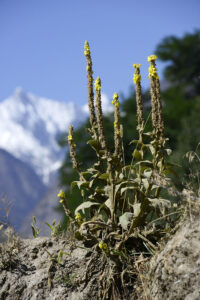
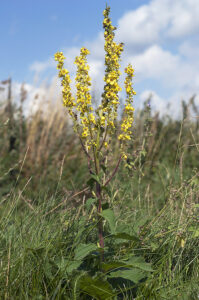



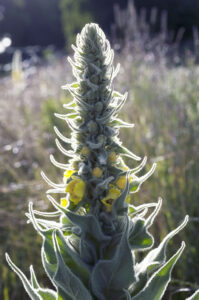
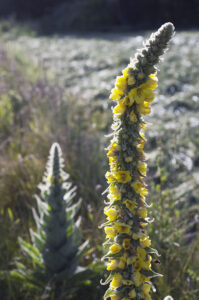
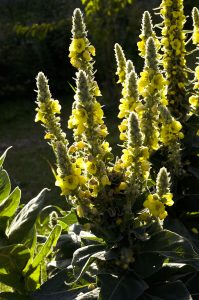
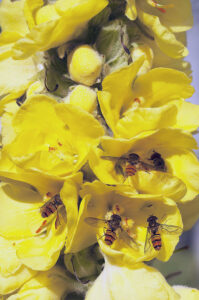
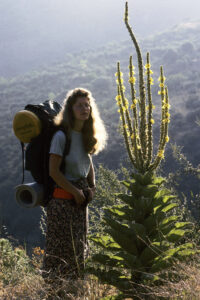
These fruits have been utilized as food in Central America since at least 7500 B.C. Green or red fruits are eaten fresh, fried, or pickled, or as a vegetable in dishes. Dried or pounded fruits are a very popular spice. The leaves are also edible, widely used in Asian cuisines. The fruits are very rich in several vitamins, besides potassium, iron, magnesium, and manganese.
In his Flora Medica, from 1838, English botanist John Lindley (1799-1865) described Capsicum annuum thus: “It is employed in medicine, in combination with Cinchona in intermittent and lethargic affections, and also in atonic gout, dyspepsia accompanied by flatulence, tympanitis, paralysis, etc. Its most valuable application appears however to be in cynanche maligna (acute diphtheria) and scarlatina maligna (malignant scarlet fever), used either as a gargle or administered internally.”
The fruits have antiseptic and stimulant properties, and powdered fruits are taken for indigestion and stomach disorders, and also for other ailments, including fever, headache, herpes, arthritis, Raynaud’s disease (‘white fingers’), psoriasis, and shingles. Juice of the fruit is applied to the skin to increase blood circulation, and a liniment is applied to sprains and painful joints. In some places, they are used as an aphrodisiac.
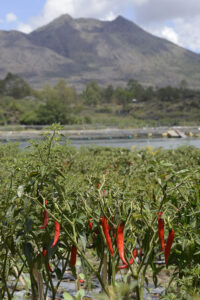
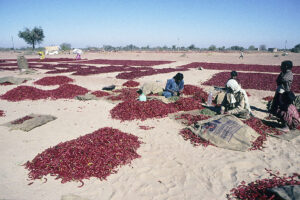

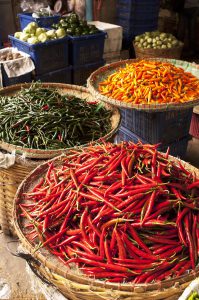
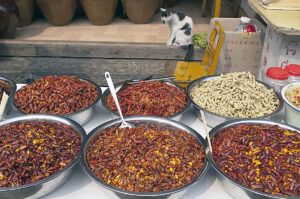
The entire plant is extremely poisonous – a fact reflected in most of its popular English names, including mad apple, devil’s apple, hell’s bells, devil’s trumpet, devil’s weed, and devil’s snare. Nevertheless, in northern India, I once watched a herd of goat head straight for a growth of thorn-apples and commence eating the fruits, so, presumably, goat stomachs can neutralize the toxins.
The popular names Jimsonweed and Jamestown weed refer to Jamestown, Virginia, where British soldiers, in 1676, attempted to suppress an armed rebellion by Virginia settlers, led by Nathaniel Bacon, against the rule of Governor William Berkeley. Some of the soldiers consumed thorn-apple, and as a result they spent the following 11 days in altered mental states. In his book The History and Present State of Virginia, from 1705, Robert Beverly gives an interesting account of this effect:
“The James-Town weed (…) was gather’d very young for a boil’d salad, by some of the soldiers sent thither to quell the rebellion of Bacon (1676); and some of them ate plentifully of it, the effect of which was a very pleasant comedy, for they turned natural fools upon it for several days: one would blow up a feather in the air; another would dart straws at it with much fury; and another, stark naked, was sitting up in a corner like a monkey, grinning and making mows [grimaces] at them; a fourth would fondly kiss and paw his companions, and sneer in their faces with a countenance more antic than any in a Dutch droll. In this frantic condition, they were confined, lest they should, in their folly, destroy themselves – though it was observed that all their actions were full of innocence and good nature. Indeed, they were not very cleanly; for they would have wallowed in their own excrements, if they had not been prevented. A thousand such simple tricks they played, and after eleven days returned themselves again, not remembering anything that had passed.”
In his book Great Herball, from 1597, English herbalist John Gerard (c. 1545-1612) writes that “the juice of thornapple, boiled with hog’s grease, cureth all inflammations whatsoever, all manner of burnings and scaldings, as well of fire, water, boiling lead, gunpowder, as that which comes by lightning and that in very short time, as myself have found in daily practice, to my great credit and profit.”
The Zuni, or Shiwi, as they called themselves, of New Mexico once used thorn-apple as an analgesic, to render a patient unconscious, while a broken bone was set.
In traditional Chinese medicine, it was used as an anaesthesia during surgery, and in Ayurvedic medicine, smoke from burning dried leaves is inhaled to treat asthma. Other uses include a paste of leaves and seeds, applied to wounds and boils, pounded leaves, mixed with water, applied to the head in case of headache, juice of the flowers taken for ear ache, and, in Nepal, smoke from frying seeds, inhaled to treat tooth ache. Thorn-apple can also reduce tremors in patients with Parkinson’s disease.
In former days, thorn-apple was widely used as a hallucinogen by witches, and also during sacred ceremonies among numerous native tribes all over North America. Still today, in Ethiopia, magicians and exorcists, called debtera, use it ‘to open their mind’ – i.e. to be more receptive, creative, and imaginative.
In his book The Serpent and the Rainbow, from 1985, Wade Davis identified thorn-apple – in Haiti called ‘zombi cucumber’ – as an important ingredient of the concoction, which voodoo priests employed to create zombies.
In Nepal, thorn-apple leaves are mixed with rice or bread and fed to mad dogs to kill them.
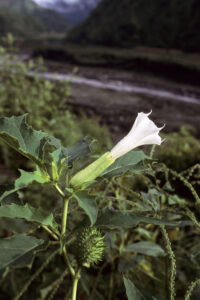
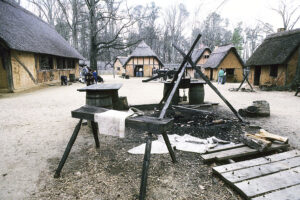
The generic name is derived from the Greek hys (‘swine’) and kyamos (‘bean’), thus ‘hog bean’ – presumably a derogatory term due to the extreme toxicity of the fruits. The English name seems to imply that chickens die from eating the plant.
During the Middle Ages, extract from henbane constituted a part of the famous ‘witch ointments’, applied to their naked body by witches. The poison penetrated their skin, throwing them into an ecstasy, during which they had fantastic hallucinations. Some had the impression of being turned into an animal, others felt they were able to fly through the air.
It is thought that the priestesses of the Oracle at Delphi used burning leaves of henbane to enter an ecstasy, before stating their prophecies.
An old tradition has it that during the Middle Ages, gypsies, mercenaries, and various other travelling folk stole chickens from farms by placing a tray with burning henbane leaves in the chicken house, causing the chickens to faint and fall to the ground, without making noise.
In Greek mythology, the dead in Hades were crowned with henbane, as they wandered hopelessly along the River Styx.
English herbalist Nicholas Culpeper (1616-1654) philosophizes about Jupiter’s bean, one of the common names of henbane: “I wonder how astrologers could take on them to make this an herb of Jupiter: and yet Mizaldus*, a man of penetrating brain, was of that opinion as well as the rest; the herb is indeed under the dominion of Saturn and I prove it by this argument: All the herbs which delight most to grow in saturnine places are saturnine herbs. Henbane delights most to grow in saturnine places, and whole cart loads of it may be found near the places where they empty the common Jakes, and scarce a ditch to be found without it growing by it. Ergo, it is an herb of Saturn.”
*Antoine Mizauld (1510-1578), also known as Antoninus Mizaldus, French astrologer and physician.
[A ‘saturnine place’ is an old expression, probably an allusion to gloomy or melancholy places, whereas ‘Jake’ is an old word for toilet.]
Now and then, henbane has been utilized for murder, one example being an American physician, Hawley Harvey Crippen (1862-1910), who, in 1910, poisoned his wife with hyoscyamine and scopolamine, which can be extracted from dried henbane leaves.
Greek physician, pharmacologist, and botanist Pedanius Dioscorides (died 90 A.D.), who was the author of De Materia Medica, five volumes dealing with herbal medicine, used henbane for pains and to procure sleep. Roman naturalist Pliny the Elder (23-79 A.D.) declared it to be “of the nature of wine and therefore offensive to the understanding.”
English herbalist John Gerard (c. 1545-1612) says: “Leaves, seeds and juice, when taken internally, cause an unquiet sleep, like unto the sleep of drunkenness, which continueth long and is deadly to the patient. To wash the feet in a decoction of henbane, as also the smelling of the flowers, causeth sleep.”
Nicholas Culpeper (above) states: “The leaves of henbane do cool all hot inflammations in the eyes. (…) It also assuages the pain of the gout, the sciatica, and other pains in the joints which arise from a hot cause. And applied with vinegar to the forehead and temples, helps the headache and want of sleep in hot fevers. (…) The oil of the seed is helpful for deafness, noise and worms in the ears, being dropped therein; the juice of the herb or root doth the same. The decoction of the herb or seed, or both, kills lice in man or beast. The fume of the dried herb stalks and seeds, burned, quickly heals swellings, chilblains or kibes in the hands or feet, by holding them in the fume thereof. The remedy to help those that have taken henbane is to drink goat’s milk, honeyed water, or pine kernels, with sweet wine; or, in the absence of these, fennel seed, nettle seed, the seed of cresses, mustard or radish; as also onions or garlic taken in wine, do all help to free them from danger and restore them to their due temper again. Take notice, that this herb must never be taken inwardly; outwardly, an oil, ointment, or plaister of it is most admirable for the gout. (…) To stop toothache, it is applied to the aching side.”
Formerly, henbane was widely used in folk medicine for the production of sedatives, and also to make magic and love potions. Necklaces were made from the root, worn by children as charms to prevent fits and to cause easy teething. In Denmark, people with toothache (popularly called ‘worms in your teeth’) would inhale the vapours from boiling henbane seeds. These vapours would undoubtedly ease the pain, but the effect might just as well have been psychological, because after the treatment, the patient could see the killed ’worms’, lying between the henbane seeds in the bowl, in which they had been heated. The explanation is that the heating would burst the seed coat, exposing the white, curved germs – not unlike fly larvae. – Smoke from the burning plant was utilized for skin diseases.
An extract of the toxic alkaloids in the leaves is utilized for various mental disorders, and also for seasickness, anaesthesizing the organs of the inner ear. It is also used as a mild diuretic.
Black henbane is native to the Mediterranean and western Asia, but has become naturalized in almost all parts of Europe and parts of North and South America.
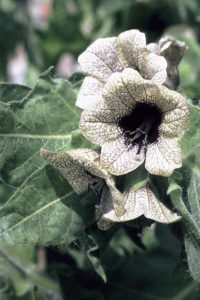
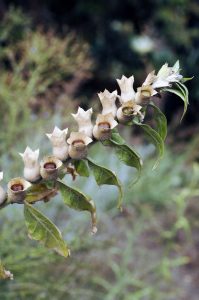
The generic name is of unknown origin, possibly derived from the Latin sol (’sun’) referring to the fact that plants of this genus prefer to grow in sunny places. The popular name is a corruption of an ancient Germanic name of these plants, Nachtschatten, of unknown meaning. As Schatten also means ‘shadow’ in German, the name nightshade was introduced, but apparently this is a misnomer.
Fruits of these plants may be red, orange, yellow, or black.
Jerusalem cherry (Solanum pseudocapsicum) is described on the page In praise of the colour orange.
This fact is related by Danish physician and herbalist Simon Paulli (1603-80) in his book Flora Danica, from 1648: ”Like a vine, bittersweet produces woody stems and many branches, which attach themselves to hawthorns or other bushes.”
Paulli also writes: ”Matthiolus [Pietro Andrea Gregorio Mattioli (1501-77), Italian physician and naturalist] says that the women in Hetruria (which is a distinguished landscape in Italy) use the juice of the berries to brighten their face with, and to remove spots and freckles.”
Paulli continues: “Sebicius [Melchior Sebicius, German physician in the 1500s] recommends that dried and ground bittersweet berries be placed on the breasts of women, whose milk has solidified, to make it run again.”
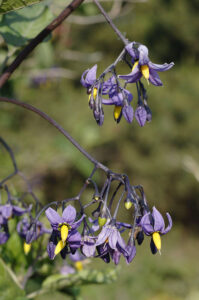
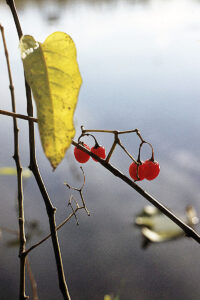
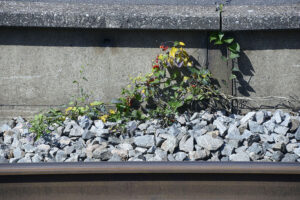
This species was named for its black berries. It is very variable, plants in northern Europe usually being small, unbranched herbs, whereas other subspecies have densely branched, very long, woody stems.
Some subspecies contain a toxic alkaloid, solanin, but the content varies tremendously between the subspecies, and non-toxic forms are eaten as a vegetable in several Asian countries. In former times, non-toxic forms were also eaten as spinach around the Mediterranean. Ripe berries are eaten raw in several African and Asian countries.
In traditional European folk medicine, black nightshade was used for inflammation, gout, swelled testicles, and ulcers. In former times, Arabs would apply crushed leaves to reduce pain and inflammation. Today, it is utilized as a diuretic, and for fever, colds, and cough.
In Nepal, black nightshade is used as a laxative, febrifuge, stimulant, and tonic, and for headache, painful joints, enlargement of the liver, haemorrhoids, dysentery, fever, and wounds, and the ripe fruit is utilized for diarrhoea, eye problems, and rabies. Juice of the leaves is used for dysentery, and it also makes a good mouth wash for ulcers. In some parts of the Himalaya, it is regarded as an aphrodisiac.
Among the Naga people of north-eastern India, an extract of the plant is used to relieve muscular pain, and a paste from it is applied to the skin to relieve stings from nettles and bees. Leaves and fruits are used for malaria, high blood pressure, and bladder infection.
In Chinese medicine, it is utilized for fever, inflammation and cancer, and also as a diuretic.
In North America, crushed leaves are applied to sunburns, and in the Amazon, a related species is used for all kinds of burns.
In Bohemia, the leaves were formerly placed in cradles of infants to promote sleep. (Source: The Treasury of Botany: a Popular Dictionary of the Vegetable Kingdom, eds. J. Lindley & T. Moore, Longmans, Green, & Co., 1874)
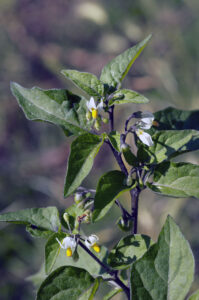
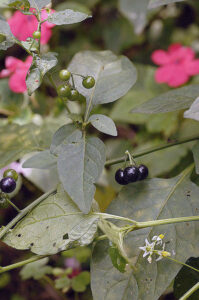
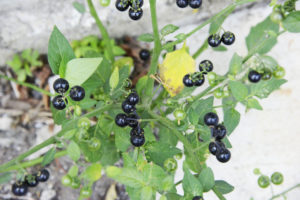
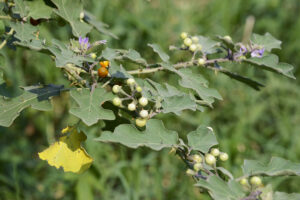
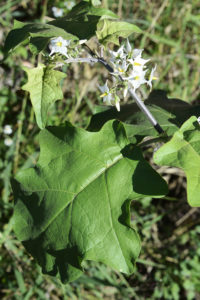
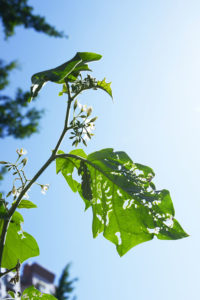
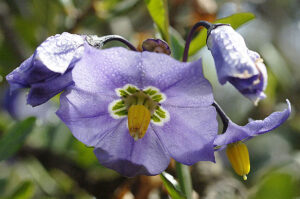
According to a Chinese legend, the habit of drinking tea dates back to about 2740 B.C., during the reign of the famous emperor and herbalist Shen Nong. This emperor preferred to have his water boiled before drinking it, to make sure it was clean. One day, when he and his army were travelling in a distant region of his empire, they were resting beneath a tea tree. His servant was boiling water, when some leaves from the tree accidentally fell into the pot. The drink turned brownish, but the emperor drank it anyway, finding it quite refreshing.
Today, tea is the most popular drink in the world. Numerous varieties exist, but they can be divided into the following main types: oolong, in which the leaves are withered and oxidized before being curled and twisted. Those of green and white teas are less oxidized, whereas those of black tea are more oxidized, and also fermented, which leads to a significant loss of medicinal properties.
Seeds of the tea bush yield tea oil, used in cooking and as seasoning.
In 1753, Swedish naturalist Carl Linnaeus (1707-1778) named a group of plants Camellia, in honour of Moravian-born Jesuit lay brother, pharmacist, and missionary Georg Joseph Kamel (1661-1706), who discovered a number of new plants in the Philippines, although not the tea plant, which Linnaeus, incidentally, placed in another genus, Thea. However, in 1818 English botanist Robert Sweet (1783-1835) moved all Thea species to the genus Camellia.
In the Orient, tea leaves are widely used medicinally. The calming effect of tea drinking reduces stress and anxiety. Green leaves are anti-inflammatory and a powerful anti-oxidant, inhibiting cancer and tumour formation, and blood clots. They also lower the cholesterol level in the blood, and they may be efficient in treatment of diabetes.
In modern herbal medicine, tea (especially green tea) is used for numerous ailments, including arthritis, diarrhoea, dysentery, herpes, haemorrhoids, liver problems, sunburn, wounds, gall stones, and excessive gas. Green tea contains fluoride, which reduces tooth decay. Studies indicate that it may have positive effect on weight loss.
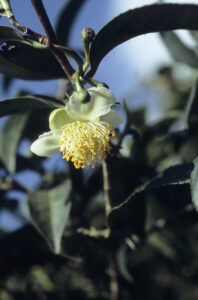

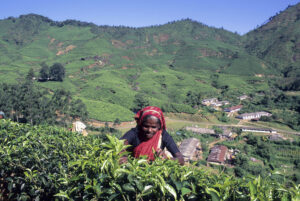

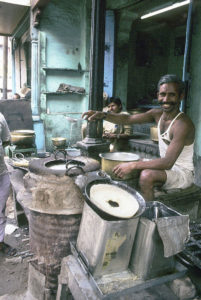
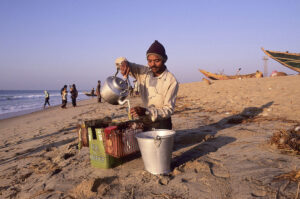
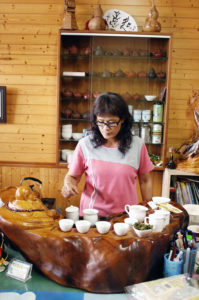

The popular name stems from the practice of producing paper from the bark. Rope is also made from the bark. In Nepal, leaves and bark are used as fish poison. In Nepal, juice of the root is used for fever and intestinal problems, and a decoction of the bark is also used for fever. Powdered seeds are taken for stomach ache, and also to expel intestinal worms.
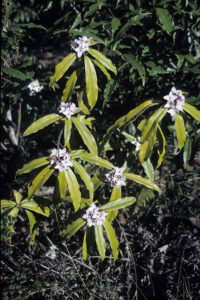

The specific name is derived from the Greek chamai (‘near the ground’) and jasme (‘jasmine’), given in allusion to the low growth and the jasmine-like flowers of this plant.
Paper and twine are made from the root. In Nepal, a decoction of the root is applied to aching joints, a decoction of the bark to sprains. In traditional Chinese medicine, the root is used for treatment of tumours, and to destroy internal parasites, expel water retention, and clear phlegm. It is also a traditional remedy for treatment of asthma and skin problems.
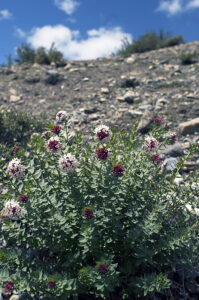
Tender parts of this plant may be eaten as a vegetable, and its seeds are roasted and pickled. It is cultivated in India for its stem fibres, which supply excellent bast, from which cloth, bags, rope, fishing nets etc. are weaved. The plant yields a blue dye. In north-eastern India, the seeds are used as fish poison.
In Ayurvedic medicine, Nilgiri nettle is used as a diuretic and laxative, to treat headache, arthritis, rheumatism and allergy, and to expel intestinal parasites. In Nepal, the boiled root is given for gastric problems, juice of the root for constipation and to treat boils. Juice of leaves is used for fever, headache, and painful joints. Ash from the plant is applied to eczema and ringworms. In Rwanda, the species is used as an antidote for snakebites.
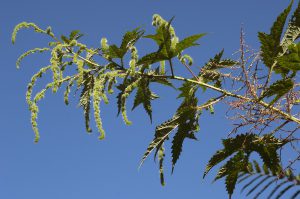
Formerly, cloth was made from the stem fibres, from the finest texture down to the coarsest, such as sailcloth, sacking, cordage, and fishing nets. As cotton became fashion, nettle fibres went out of use. However, during World War I, in Germany and Austria, nettle fibres had a come-back. In 1915, 1300 tons of this material was collected in Germany, increasing to 2700 tons in 1916.
Scottish poet Thomas Campbell (1777-1844) complained of the little attention paid to the nettle in England, saying: ”In Scotland, I have eaten nettles, I have slept in nettle sheets, and I have dined off a nettle tablecloth. The young and tender nettle is an excellent potherb. The stalks of the old nettle are as good as flax for making cloth. I have heard my mother say that she thought nettle cloth more durable than any other species of linen.” – As Campbell says, nettle makes a fine potherb, and it is still a popular ingredient in herbal soups. In rural areas of Nepal, nettles are an important food. Everywhere, they are of considerable value as fodder for cattle, sheep, pigs, geese, and chickens.
A decoction of nettle yields a beautiful and permanent green dye, used in Russia for woollen goods.
An old legend has it that if nettle is planted near beehives, it will drive away frogs. Supposedly, in those days, it was believed that frogs, or maybe toads, would eat bees?
Nettle is mentioned in the tragedy King Lear, by William Shakespeare (1564-1616):
The herbalists of bygone times recommended nettle for a number of diseases, including jaundice, tuberculosis, ague (malaria), dysentery, frostbite, stone and gravel, rheumatism, and gout. Seeds, taken inwardly, would be helpful for stings or bites of venomous creatures and mad dogs, and as an antidote to poisoning by hemlock (see Conium maculatum, Apiaceae), henbane (Hyoscyamus niger, Solanaceae), and nightshade (Solanum, Solanaceae).
People suffering from arthritis would utilize the curious practice of urtication – thrashing the affected limbs with fresh nettles, which, according to one wise woman in Denmark, would “awaken the nerve ends.”
For stimulating hair growth, the old herbalists recommended combing the hair daily with nettle juice.
Recent research has shown that nettle root is an effective remedy for enlarged prostate. Nettle leaves are diuretic, blood-cleansing, anti-inflammatory, and anti-allergenic. They are used for a huge number of ailments, such as nasal and respiratory problems (including asthma, bronchitis, and even tuberculosis), for bladder infections, gingivitis, sciatica, laryngitis, and hives.
Persons, suffering from multiple sclerosis, may relieve the pain by flailing themselves with fresh nettles. Due to their high content of iron and vitamin C, the leaves are a good remedy for anaemia. Nettle tea is considered to be helpful against rheumatism, arthritis, and gout.
Among the Tamang people of Nepal, a paste of the root and leaves is taken orally for bone fracture. Elsewhere in Nepal, a decoction of the root is taken for asthma, cough and colds. A paste of the root is applied to dog bites. Juice of the root, or a paste of the fruits, is applied to dislocated bones. Juice of the stem is taken for fever, and a decoction of the leaves to treat jaundice and menstrual disorders.
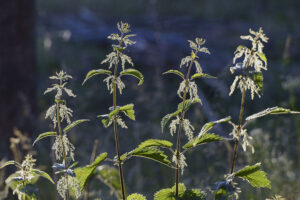
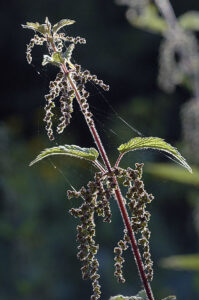
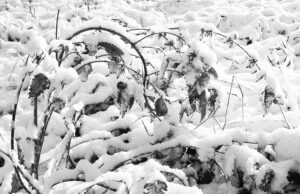

In the Middle Ages, people wore necklaces of fresh plants for good luck, and it was thought that it would protect them against snakebites and headache. If you rubbed it on your skin, while reciting a secret spell, your wishes would be granted. A vervain plant in the home would protect it against lightning.
In Nimphidia, the Court of Faery, from 1627, English poet Michael Drayton (1563-1631) writes:
Originally, officinalis was derived from officina (‘workshop’, or ‘office’), and the suffix alis, which, together with a noun, forms an adjective, thus ‘made in a workshop’. However, in a botanical context, the word denotes plants species that were sold in pharmacies due to their medicinal properties.
The name Verbena, and with that the English name, is explained in various ways. According to one authority, it is derived from the Latin verber, meaning rod or stick. Thus, it seems, Swedish naturalist Carl Linnaeus (1707-1778) applied the name Verbena to the plant in allusion to its stiff, rod-like branches and stem. Others claim that it stems from verbena, the Roman name of altar plants. A third source says that it is derived from the Celtic word ferfaen, meaning ‘to drive away stones’ – it was thought that the plant was an effective remedy for kidney stones.
This plant is native to central Europe and the Mediterranean and has become naturalized in North America.
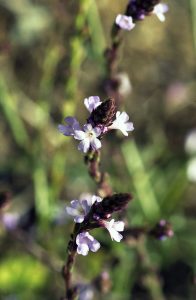
The name pansy is from the French pensée, meaning ‘thought’ – the plant was regarded as a symbol of remembrance. The name heartsease refers to its former usage for heart problems, but may also stem from its role in love potions. In A Midsummer Night’s Dream, by William Shakespeare (1564-1616), Titania is the proud fairy queen, married to Oberon. They engage in a quarrel, whereupon Oberon orders his servant, Puck, to feed Titania a love potion, containing pansy, among other ingredients, which makes her fall in love with Nick Bottom, a weaver, who, for the occasion, has been given the head of a donkey by Puck
Several of the common names of wild pansy refer to its multi-coloured petals. The name stepmother, used in several countries, including Germany (Stiefmütterchen) and Denmark (stedmoderblomst), stems from a fanciful reference to the flower, depicting a stepmother, who sits on a stool with a dish of porridge with a blob of butter (the yellow-eyed petal), feeding her own daughters (the two colourful petals nearby), but not her stepchildren (the two dull-coloured petals furthest away).
In Denmark, wild pansy has been used for dyeing, yielding a green hue. Today, large-flowered hybrid forms of the plant are cultivated as ornamentals.
English herbalist John Gerard (c. 1545-1612) states: “It is good, as the later physicians write, for such as are sick of ague, especially children and infants, whose convulsions and fits of the falling sickness it is thought to cure. It is commended against inflammation of the lungs and chest, and against scabs and itchings of the whole body and healeth ulcers.” [Ague is an old word for malaria, and ‘falling sickness’ is an old expression for epilepsy.]
The flowers were used for heart diseases, giving rise to the popular name heartsease, and the plant was employed as a demulcent and an expectorant.
Today, this species and other members of the genus are used for their strong anti-inflammatory and diuretic properties. They are also an excellent remedy for colds and bronchitis, and for various skin problems, such as eczema and psoriasis. The root and seeds are emetic and purgative.
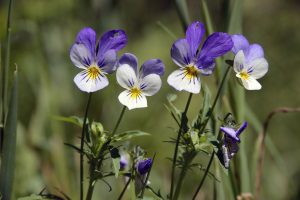
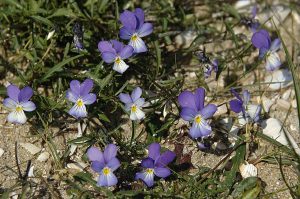

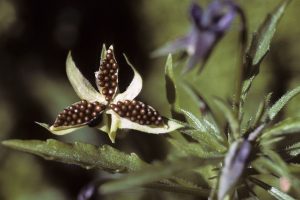
Ginger was imported to Europe at a very early stage. It was used extensively by the Romans, but almost disappeared from Europe with the fall of the Roman Empire. By the 11th Century, however, ginger was again a widespread European commodity, when, among other uses, it was added as flavouring to buttermilk.
Its usage in food became much more widespread, when the Arabs and other Muslims began expanding their empires. In the 1500s, the Spaniards brought ginger to Jamaica, where they established plantations, and during the following centuries, plantations were established in most hot countries.
It is told that Queen Elizabeth I (1533-1603) invented the gingerbread man, which became a popular Christmas treat. An old English recipe says: “Gather strawberry leaves on Lamas Eve, [August 1] press them in the distillery until the aromatick perfume thereof becomes sensible. Take a fat turkey and pluck him, and baste him, then enfold him carefully in the strawberry leaves. Then boil him in water from the well, and add rosemary, velvet flower, lavender, thistles, stinging nettles, and other sweet-smelling herbs. Add also a pinte of canary wine, and half a pound of butter and one of ginger, passed through the sieve, besides plums and stewed raisins and a little salt. Cover him with a silver dish cover.”
Today, the rhizome is widely used as a spice, especially in Asian cuisines. From the tender young rhizome, a variety of products are made, including pickles, candied ginger, ginger wine, and ginger cakes.
Ginger is cultivated in most tropical and subtropical countries. In 2013, the total world production was 2.1 million tons.
The specific name indicates the medicinal properties of this plant. In China and India, its usage goes back more than 5,000 years. In Ayurvedic texts, it is called “a universal great medicine”, and an old Indian proverb says that “everything good is found in ginger.” According to traditional Chinese medicine, it “restores devastated yang” and “expels cold.”
Today, ginger is probably the most popular medicinal herb in the world. Its main usage is boosting the immune system, stimulating blood circulation and the digestive system, and treating colds, cough, fever, flu, nausea, vomiting, and morning-sickness during pregnancy. However, it is useful for numerous other ailments, including indigestion, angina, depression, dizziness, sciatica, Raynaud’s disease (‘white fingers’), ulcers, arthritis, chronic fatigue, hives, dandruff, and travel sickness.
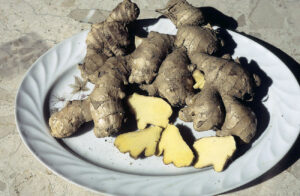
Caltrop fruits have 2 to 4 very strong spines, which are able to penetrate a bicycle tyre, giving rise to a popular name of this plant, puncture vine. When the fruit is lying on the ground, at least one thorn is always pointing upwards, so that it may stick to a foot of a passing animal, or, if a furry animal, like a sheep, lies down in an area with these fruits, several will stick to its fleece. In this way, the seeds are dispersed. Much damage has been done to the feet of livestock by these fruits.
The generic name is from the Greek tribolos, meaning ’caltrop’, a small metal object with several spikes, of which one is always pointing upwards. In the old days, these weapons were spread on roads and footpaths to prevent traffic of the enemy’s soldiers, horse riders, and horse-drawn vehicles.

Greek scholar Theophrastos (c. 371-287 B.C.) and Greek physician, pharmacologist, and botanist Pedanius Dioscorides (died 90 A.D.), who was the author of De Materia Medica, five volumes dealing with herbal medicine, both maintained that the rhizome of common male fern would expel intestinal worms. English herbalist John Gerard (c. 1545-1612) writes: “The roots of the male fern, being taken in the weight of half an ounce, driveth forth long flat worms, as Dioscorides writeth, being drunke in mede or honied water, and more effectually if it be given with two scruples, or two third parts of a dram of scammonie, or of black hellebore: they that will use it, must first eat garlicke.”
In 1855, Swiss apothecary M. Peschier states that by digesting buds of common male fern in sulphuric ether, and using this tincture against tapeworms, they were killed with constant success. (Source: M. Peschier 1855. Bibliothèque Universelle de Genève, XXX, p. 205)
The pounded rhizome has the same effect. Due to the great toxicity of this drug, it is only used nowadays, when alternative drugs are inadequate. A decoction of the rhizome has also been used to treat certain fungal infections.
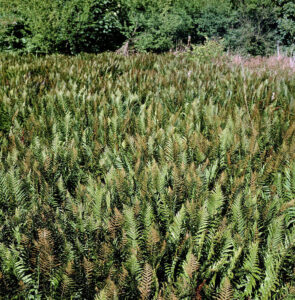
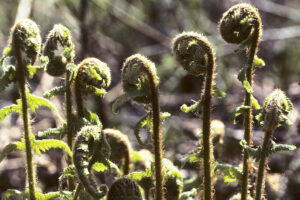
The generic name is from the Latin equus (‘horse’), and seta, which has several meanings, including ‘rough’, ‘brush’, or ‘hair’. The latter word can refer to the rough, silica-containing stems of these plants, but together with equus, the word means ’horse hair’. With a bit of imagination, a bunch of drying stems do resemble a horsetail.
In former days, horsetail stems were used to polish pewter and wood, which gave rise to the popular name pewterwort, and also to strengthen fingernails. Due to their high content of silica, they can be used as an abrasive.
In Nepal, the stem juice of Equisetum diffusum is used for gonorrhoea, and juice of the root is utilized for urinary problems, sprains, fractures, burns, and scabies.
Field horsetail grows in a wide range of habitats, including open woodlands, pastures, along streams and roadsides, and in other disturbed areas. It is a most troublesome weed in fields due to the vigorous growth of its very long rhizomes
In his book Bræen (1908), Danish poet Johannes V. Jensen (1873-1950) writes: ”On the grey fields, beside the mole hills, horsetails had penetrated the surface, like a dead man’s fingers.”
English herbalist Nicholas Culpeper (1616-1654) says: “It is very powerful to stop bleeding, either inward or outward, the juice or the decoction being drunk, or the juice, decoction or distilled water applied outwardly. (…) It solders together the tops of green wounds and cures all ruptures in children. The decoction taken in wine helps stone and strangury; the distilled water drunk two or three times a day eases and strengthens the intestines and is effectual in a cough that comes by distillation from the head. The juice or distilled water used as a warm fomentation is of service in inflammations and breakings-out in the skin.”
In traditional Austrian medicine, field horsetail has been taken as tea, or externally for rheumatism and gout, and for disorders of the skin, kidneys, and urinary tract. It has also been used for tuberculosis and kidney stones.
In today’s herbal medicine, it is known as an excellent antioxidant, and for its anti-inflammatory, coagulant, demulcent, diuretic, and astringent properties. Its silica content may prevent tendinitis and osteoporosis. It is also regarded as beneficial to ligaments and painful lower back muscles, and it is possible that it will prevent hair loss.
In spring, buds of field horsetail are eaten as a vegetable in Japan and Korea, but all other members of the genus are considered to be toxic.
In Nepal, the stem juice of Equisetum diffusum is used for gonorrhoea, and juice of the root is utilized for urinary problems, sprains, fractures, burns, and scabies.
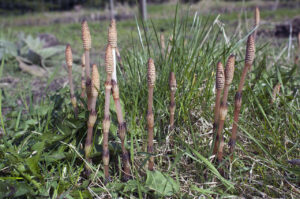
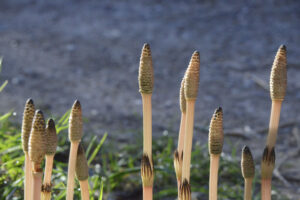

It grows in damp places, preferably springs in open woodlands, where it often forms large clones. It is native to Europe, except the northernmost parts, and thence eastwards almost to the Ural Mountains, southwards to northern Africa and Iran. It may be found up to elevations around 1,200 m.
The specific name is derived from Ancient Greek telma (‘marsh’), alluding to this plant growing in wet places.
Previously, a somewhat similar plant in western North America, found from Alaska southwards to California, was regarded as a subspecies of the northern great horsetail. It is now recognized as a separate species, E. braunii.

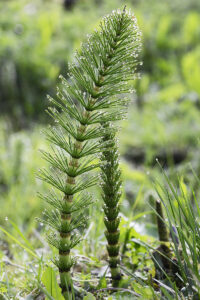
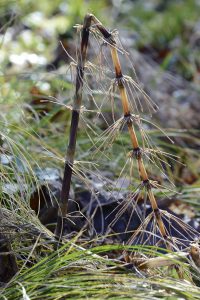
Among American tribes, this species was utilized for dropsy, and for kidney and prostate problems. Women with irregular menstruation drank a decoction of it, mixed with willow leaves. Juice of the root was added to human milk, and this mixture was applied to inflamed eyes. Top shoots of young plants were eaten to cure diarrhoea, and the ashes of burned plants were applied to burns. Potawatomi tribals maintained that tea made from this species was the best remedy for lumbago.
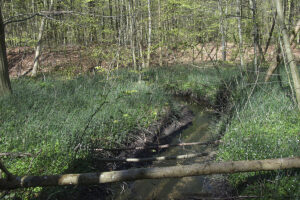

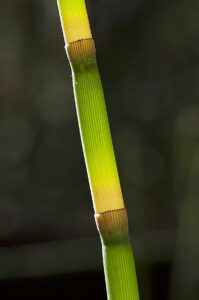
Marsh horsetail belongs to the group of horsetails, in which the sporangia are clustered in so-called strobili at the tip of the stem.
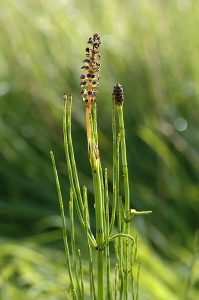
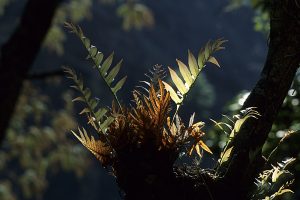
Stem, leaves, and root are much utilized in Chinese herbal medicine, chiefly as an invigorator of the blood circulation, but also as an anti-inflammatory in swellings and wounds, for shingles, tuberculosis, and toothache, and as a diuretic.
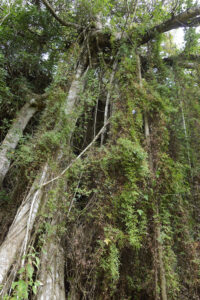

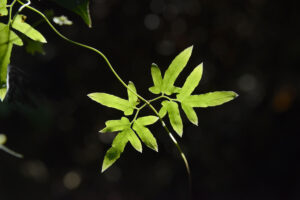
Most fungi obtain their nutrients from dead organic matter through their thread-like mycelium, others live in symbiosis with plants, some with animals or other fungi, and some are parasites. The mycelium is mostly underground, and you mainly notice fungi in their fruting stage.
Lichens are double organisms, consisting of a fungus and an alga or a cyanobacterium, living in a mutual symbiotic relationship. The alga or the cyanobacterium is attached to the mycelium of the fungus, which is again attached to the soil, or to stones or trees. Thus, the alga or cyanobacterium is protected from most enemies, and in return it provides the fungus with essential carbohydrates that the fungus cannot produce. The mycelium, however, is able to obtain certain nutrients from the soil or from the air, which benefit the alga or cyanobacterium.
Formerly, the spores, or the fungus itself, was applied to wounds as a styptic. It was sucked into the nose to stop nosebleeds, and also applied to frostbite and to raw skin on the feet. In an old Danish book, it is said: “Formerly, most soldiers knew of this treatment, when they on their long marches, in burning summer heat, had been sunburned and gotten patches of raw skin.”
Puffballs have also been utilized as painkillers, for stomach ache, and to reduce swelling, fever, and cough. In Schleswig, northern Germany, the spores were formerly used to treat diarrhoea in calves.
Most puffballs are edible when young, but with little taste. Common puffball is reported to have a higher content of protein than most other fungi.
In former days, in Denmark, it was believed that adders were living in puffballs, and that children could become blind, if the spores blew into their eyes.



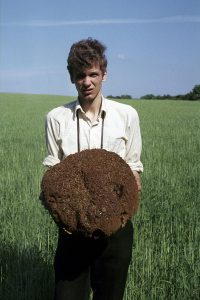

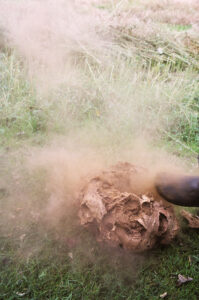
Cup lichens are widely distributed in the Northern Hemisphere, found on the ground or on rocks. The thallus varies in shape from simple and pointed to cup-shaped and can be yellow, gray, or brown in colour.
Reindeer lichens cover vast areas in the northern tundra and taiga areas, and although they grow very slowly (3-5 mm per year), they constitute a very important food item for reindeer or caribou (Rangifer tarandus), moose or elk (Alces alces), and musk ox (Ovibos moschatus).
Cup lichens contain a gummy or starchy material, which, boiled with milk or syrup, has been used as a remedy for whooping cough and chest ailments.
In Scandinavia, reindeer lichens have been used in the manufacture of alcohol. In Denmark, in the 1700s, these lichens were harvested in great quantities and, mixed with heather (Calluna vulgaris) used as winter fodder for cattle and sheep.


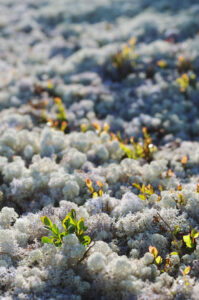
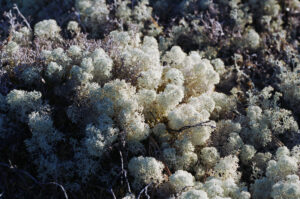
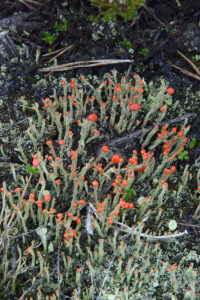
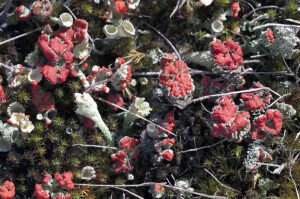
The generic name derives from Arabic ušna (‘moss’). In former days, botanists didn’t distinguish between mosses and lichens.
In 1546, Danish herbalist Henrik Smid (c. 1495-1563) says that old-man’s-beard lichens from oaks, boiled in wine with red roses and wormwood, is used as a compress to strengthen the joints.
In his book Flora Danica, from 1648, Danish physician and herbalist Simon Paulli (1603-1680) recommends old-man’s-beard lichens as an astringent, to relieve painful menstruation, and to prevent abortion.
He also gives this fascinating account of Usnea: ”But above all other kinds of moss [lichens], which grow in the forests on trees, rocks and other places, the most famous one is Usnea, or Muscus cranii humani, meaning: ’That moss which grows on human skulls’, which, although rarely, is sometimes found on the skulls of miscreants, who have been beheaded, or otherwise done away with, and whose heads have been placed on a stake.”
The lichen from these ‘miscreants’ should be a very effective remedy for healing battle wounds from swords. You only had to tie the lichen around the sword, and the wounded person would be healed, even if he was miles away. It was also used against epilepsy and nosebleed.
Nowadays, Usnea is commonly used for sore throat, as an antibiotic, to reduce pain and fever, and to aid weight loss.
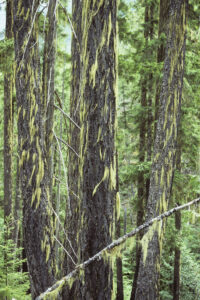


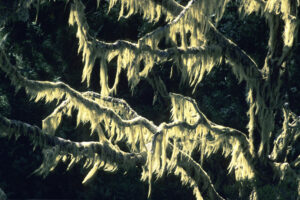
Previously, these organisms constituted a separate family, Lobariaceae, but have lately been moved to Peltigeraceae.
The generic name is Latin, meaning ‘lobed’, ultimately derived from Ancient Greek lobos (‘a lobe of the liver’), alluding to the lobed thallus. The name lungwort likewise refers to the thallus, the surface of which resembles that of a lung.
